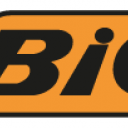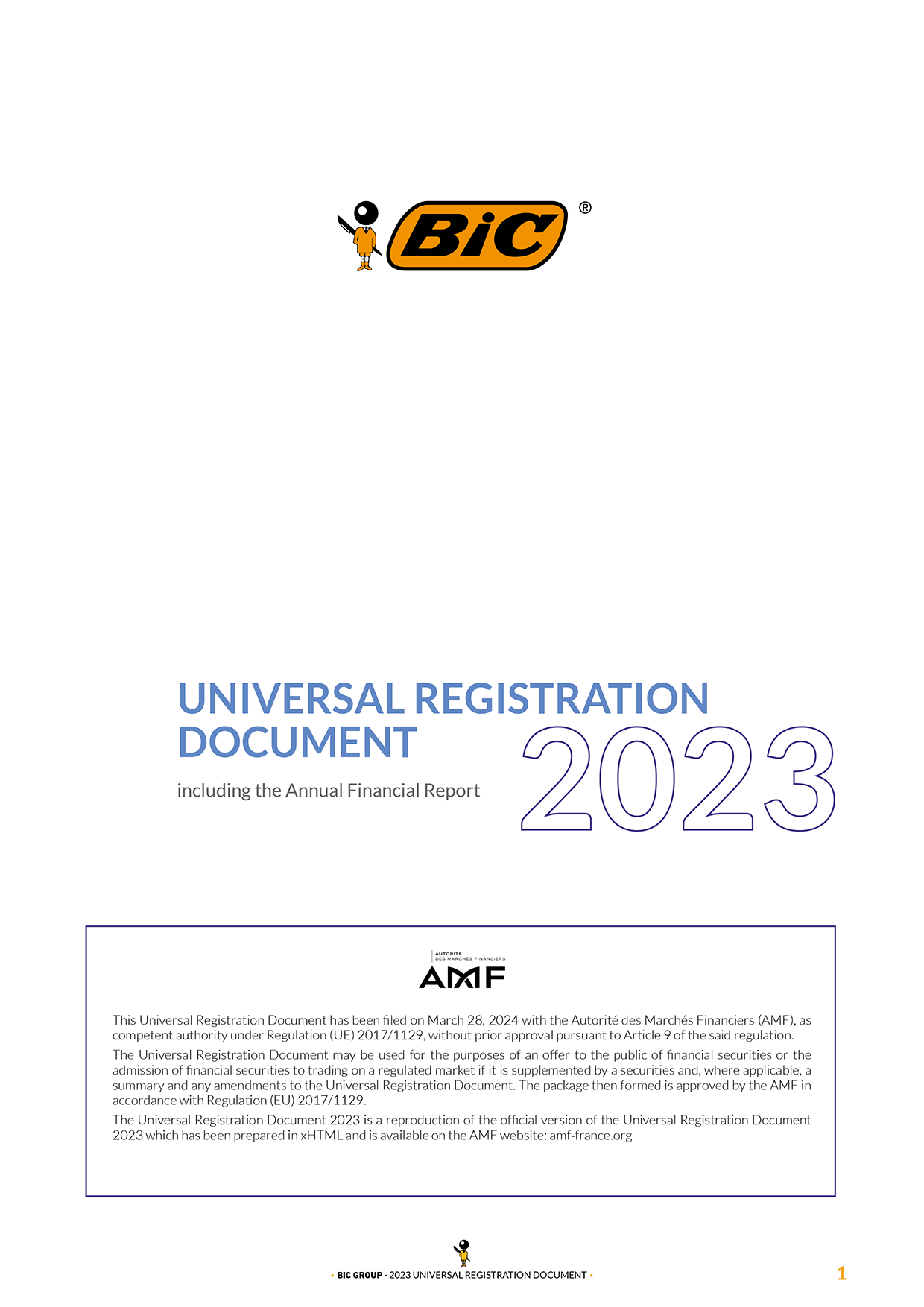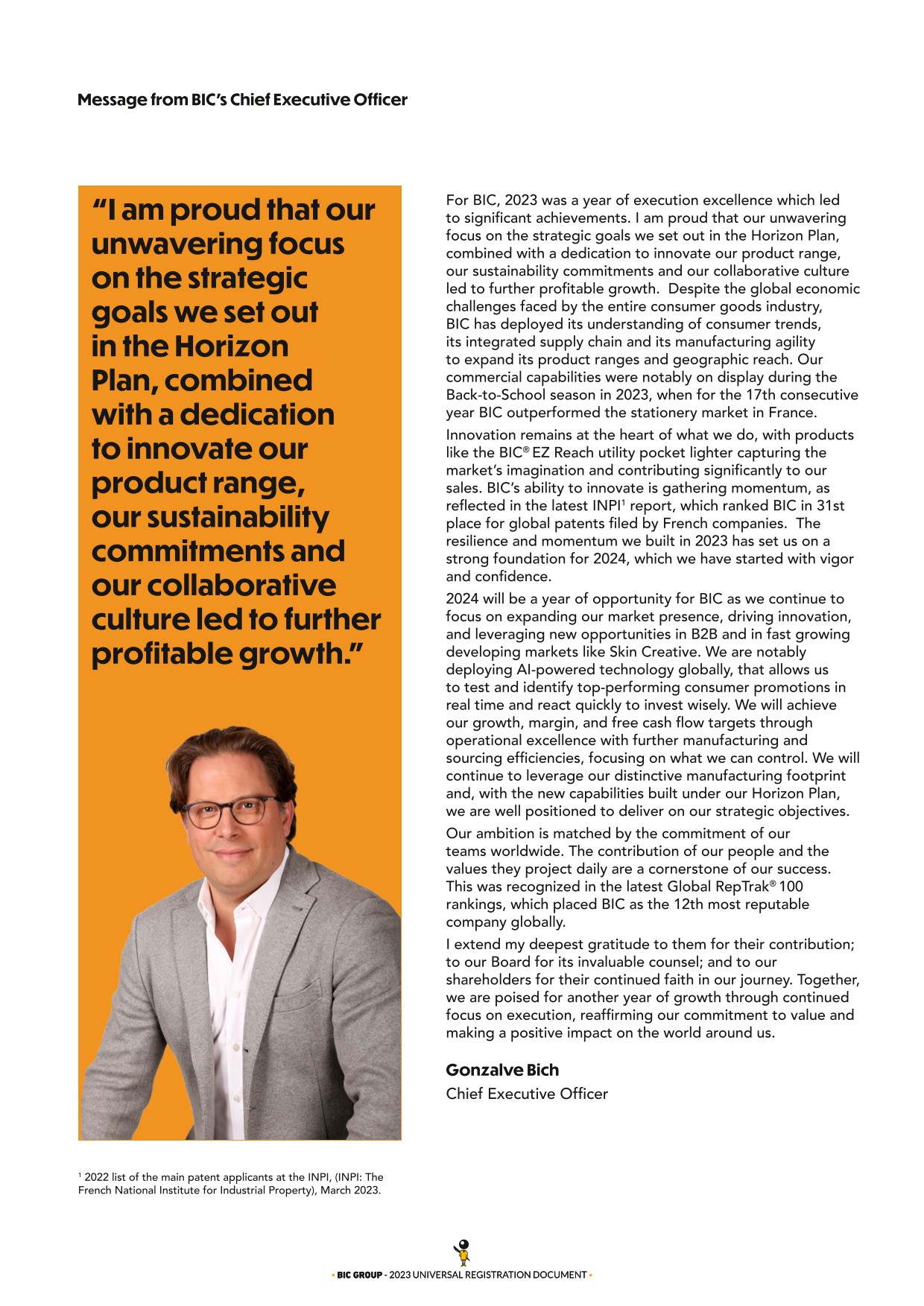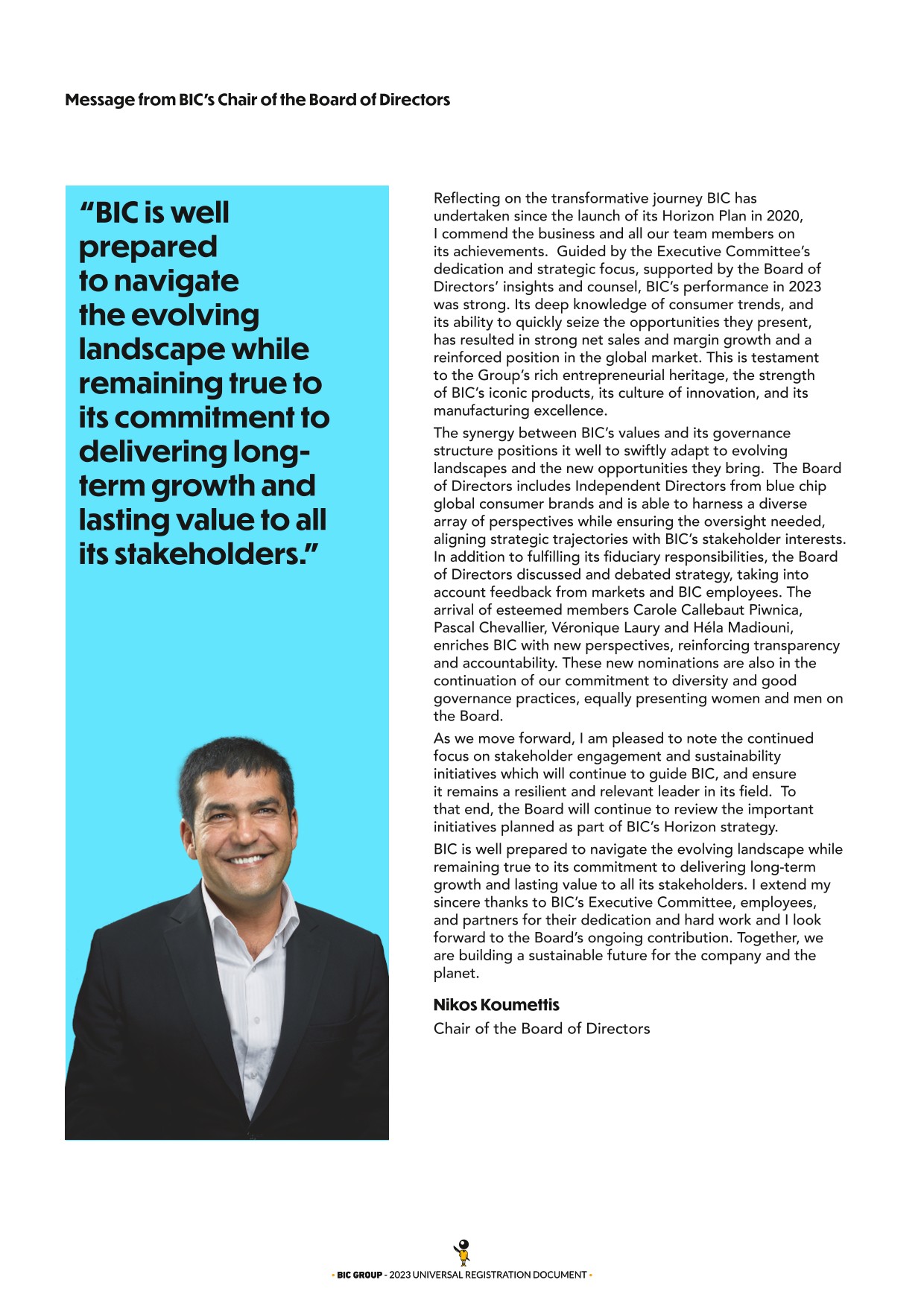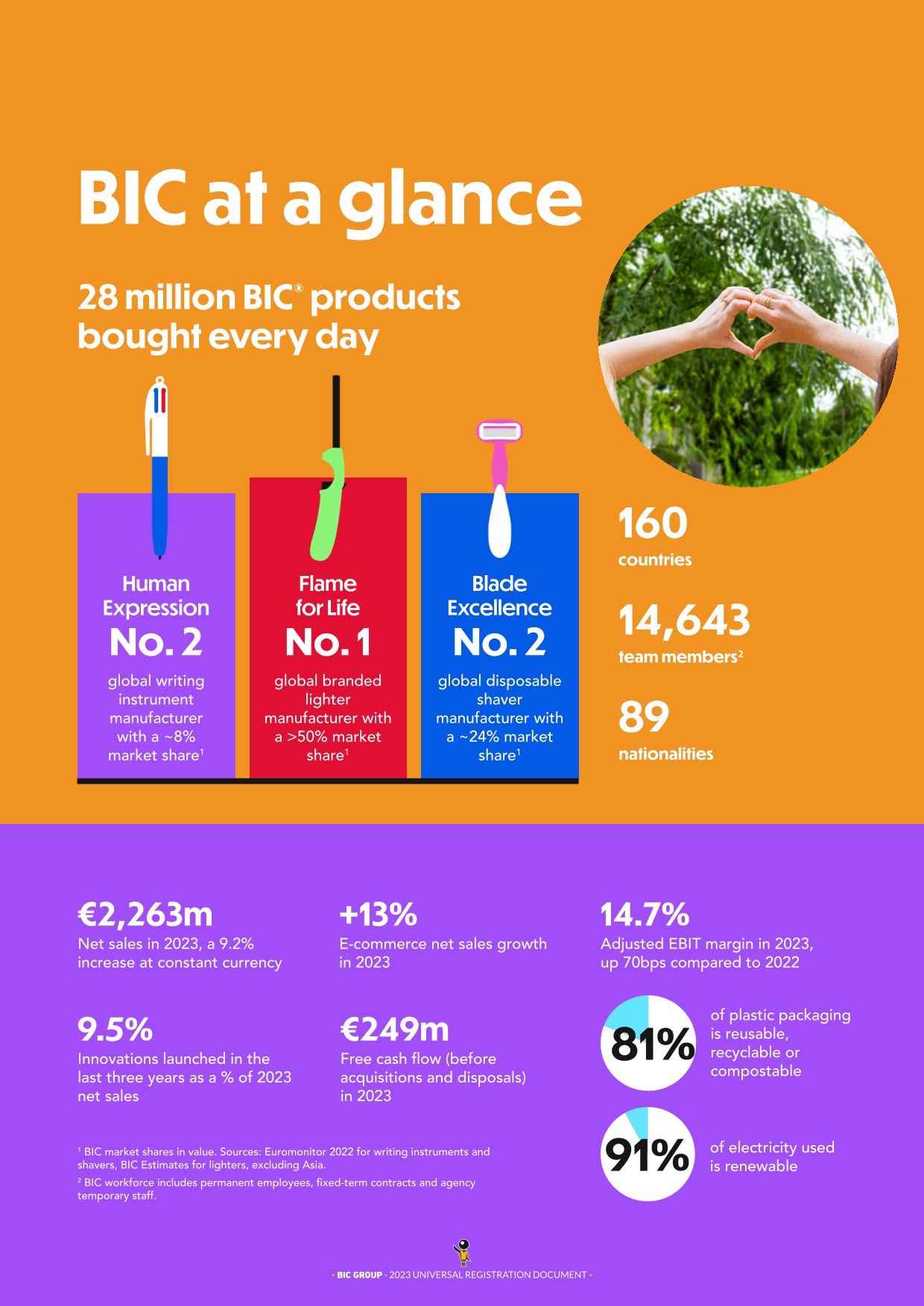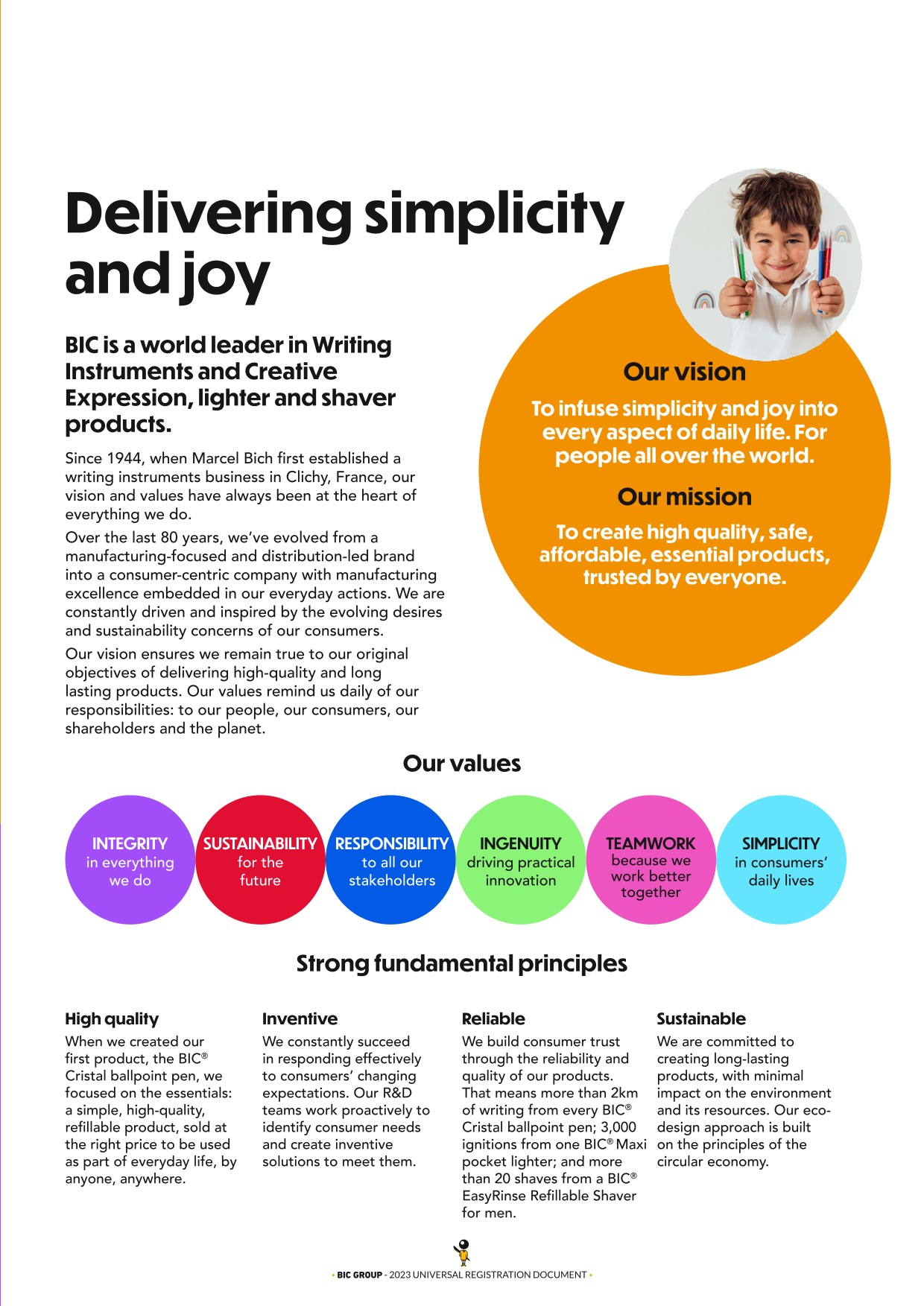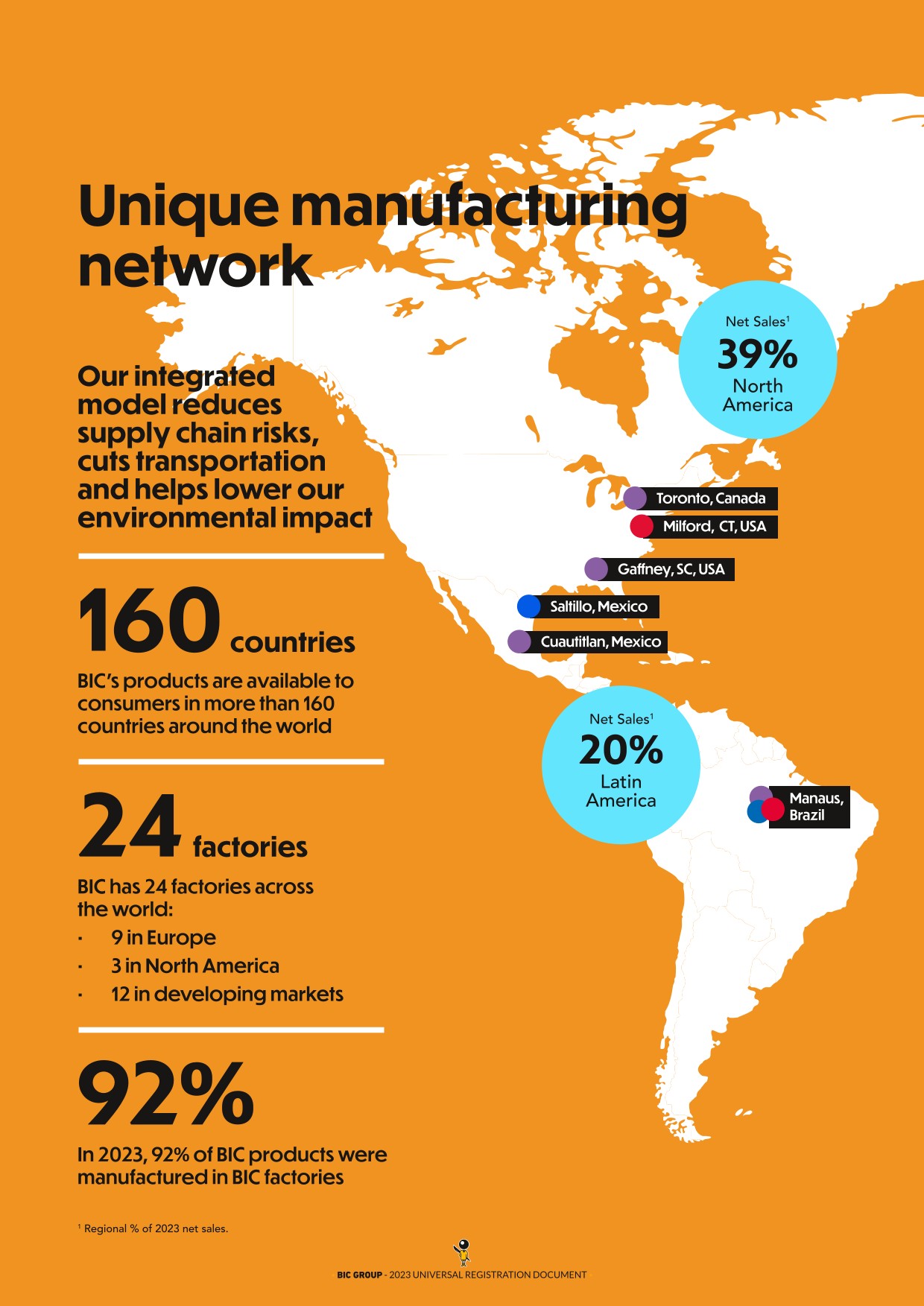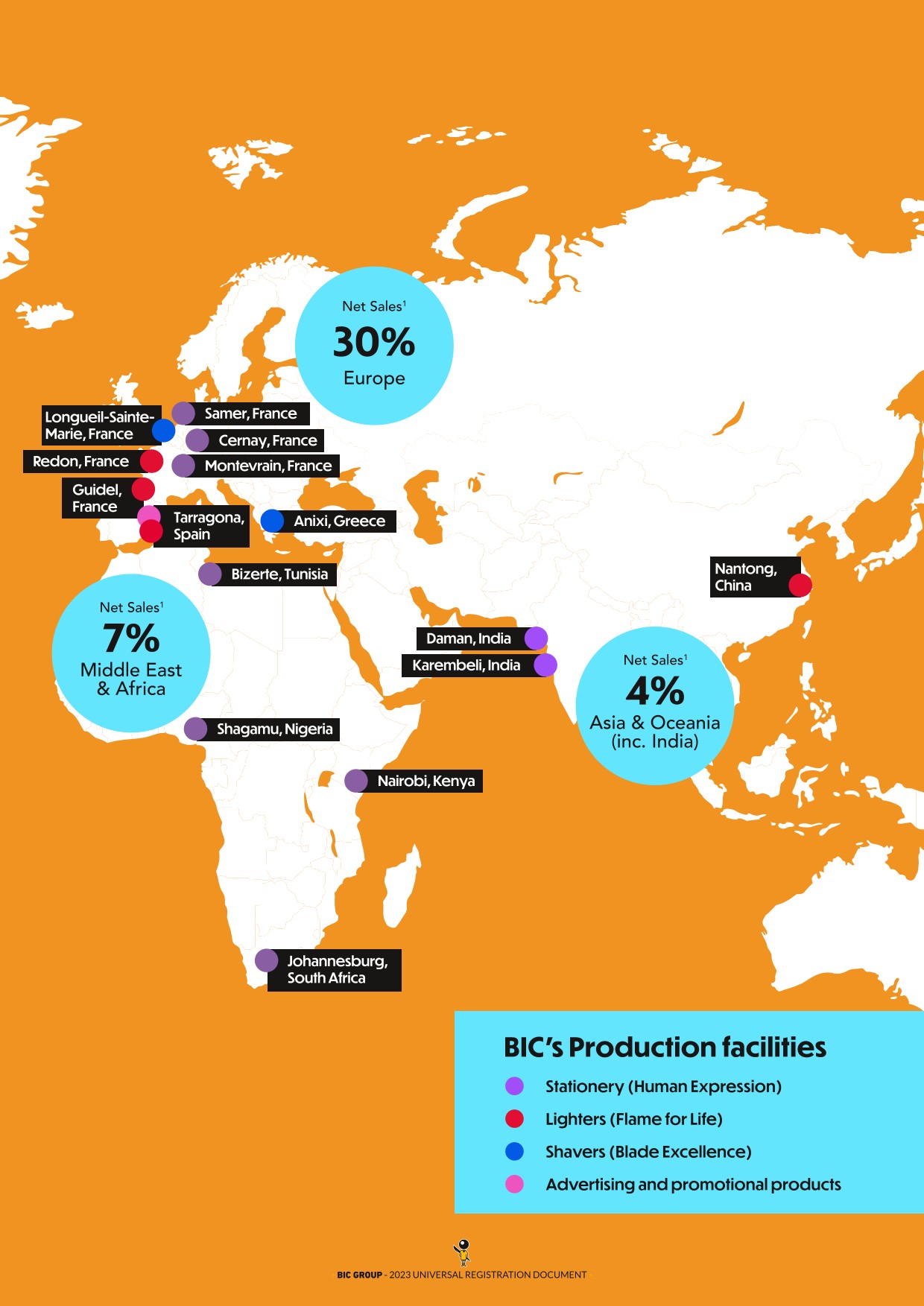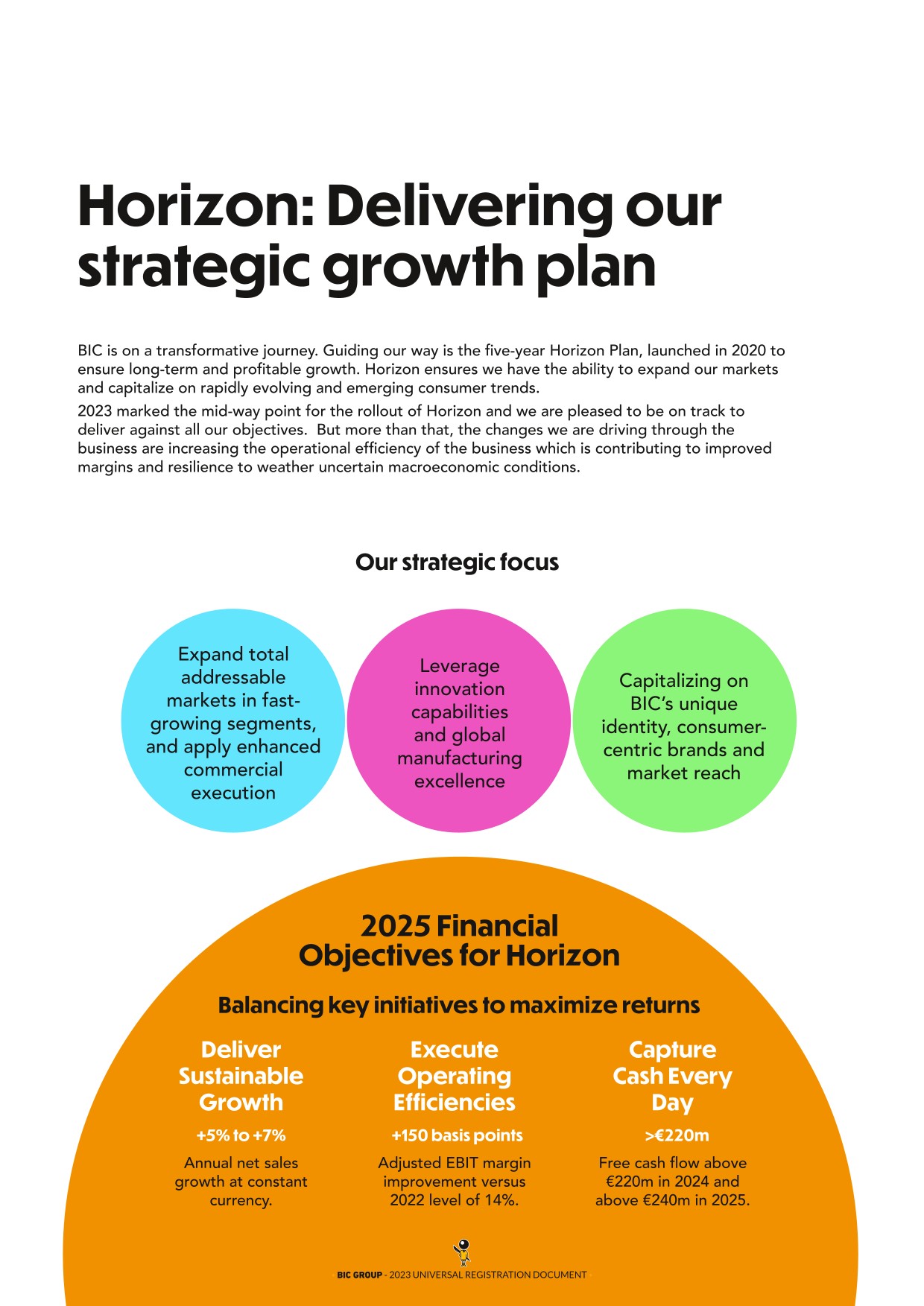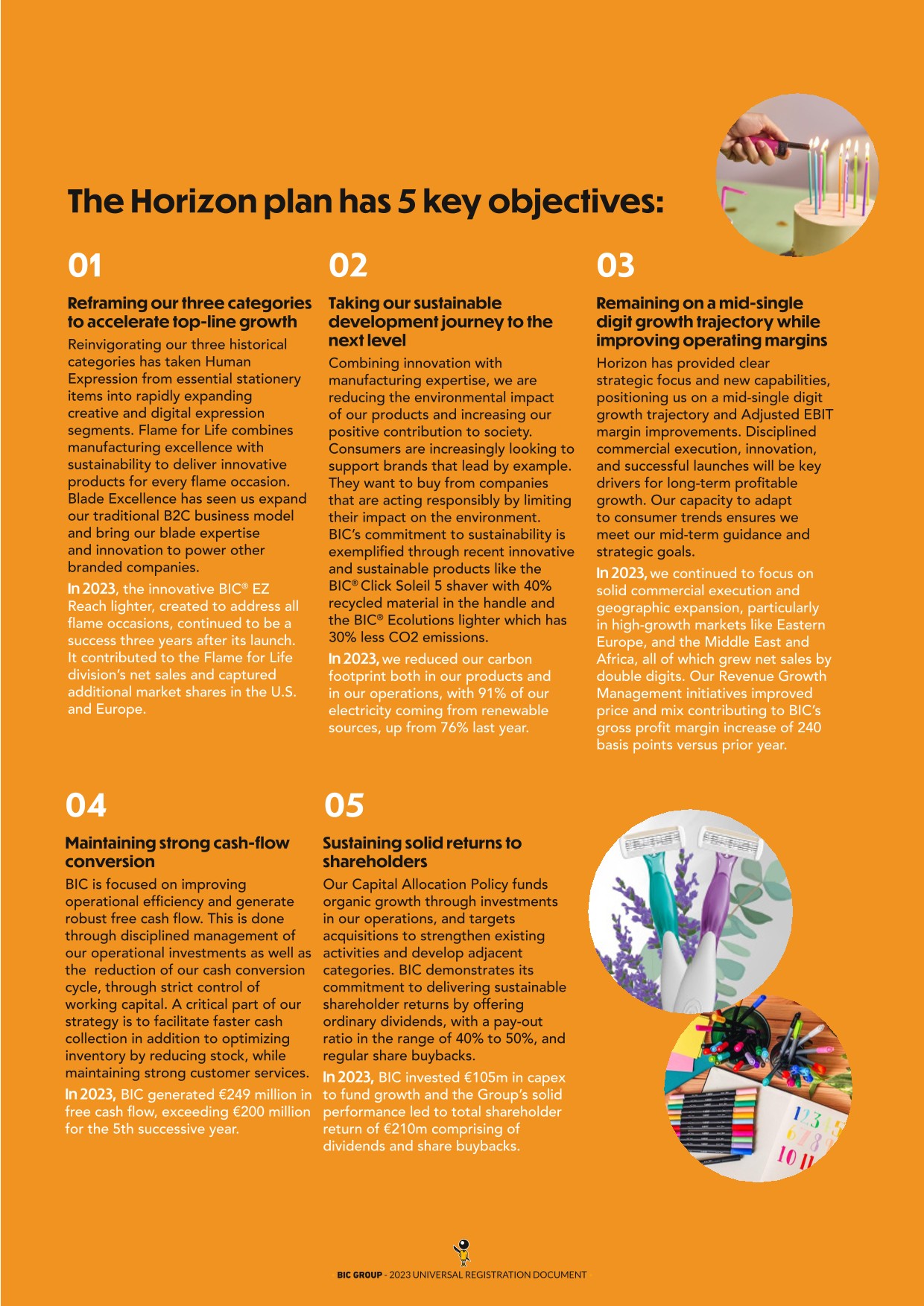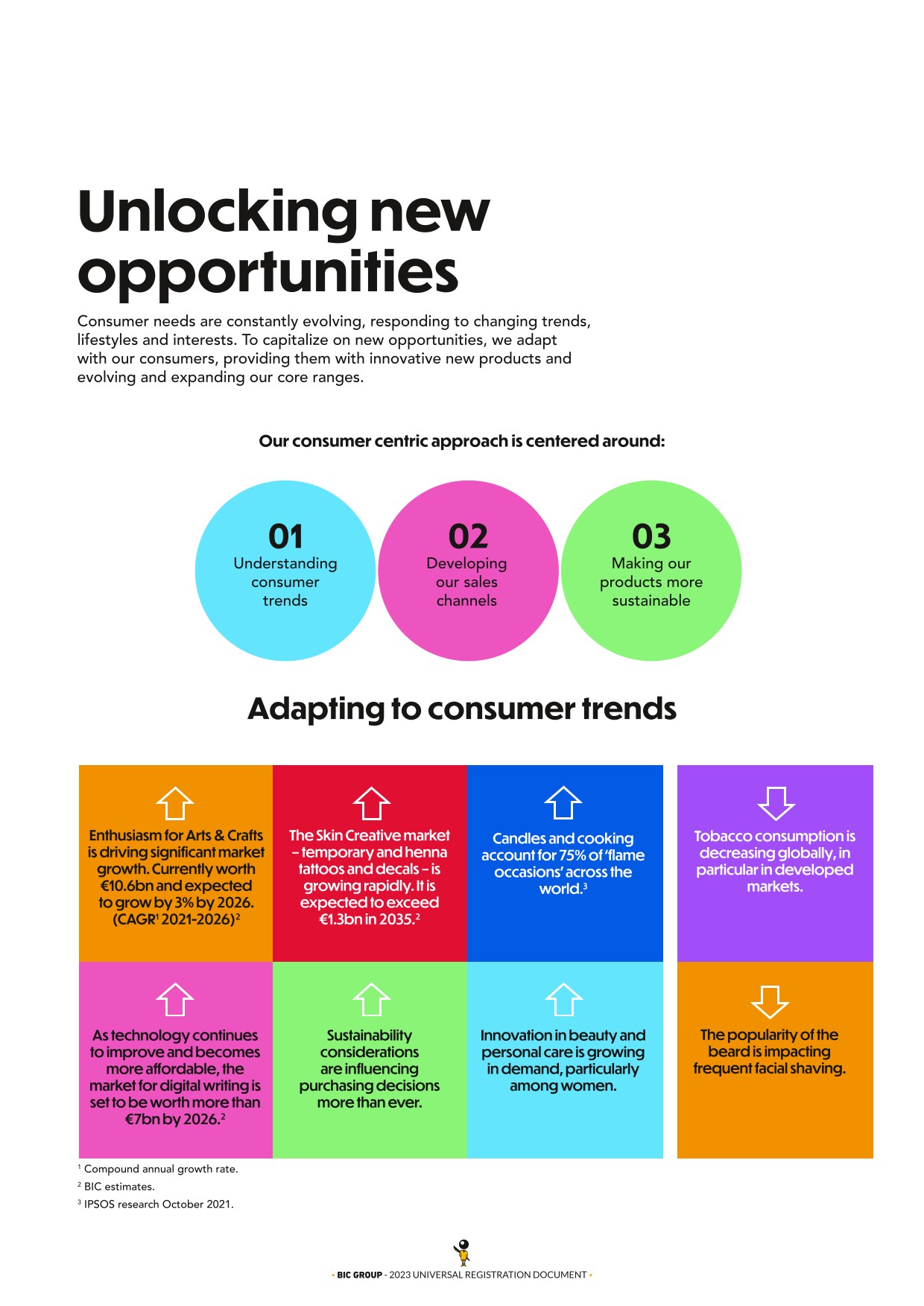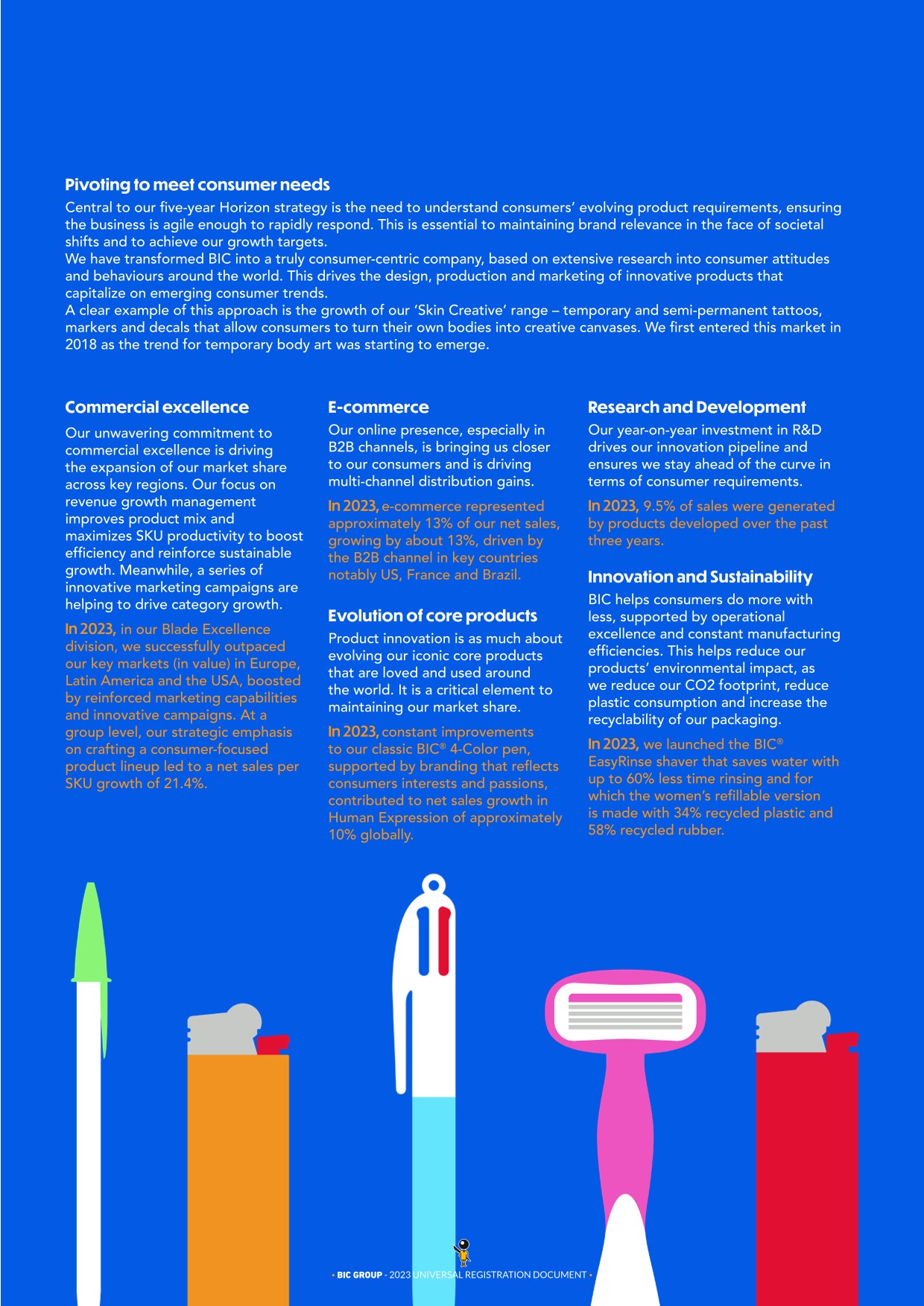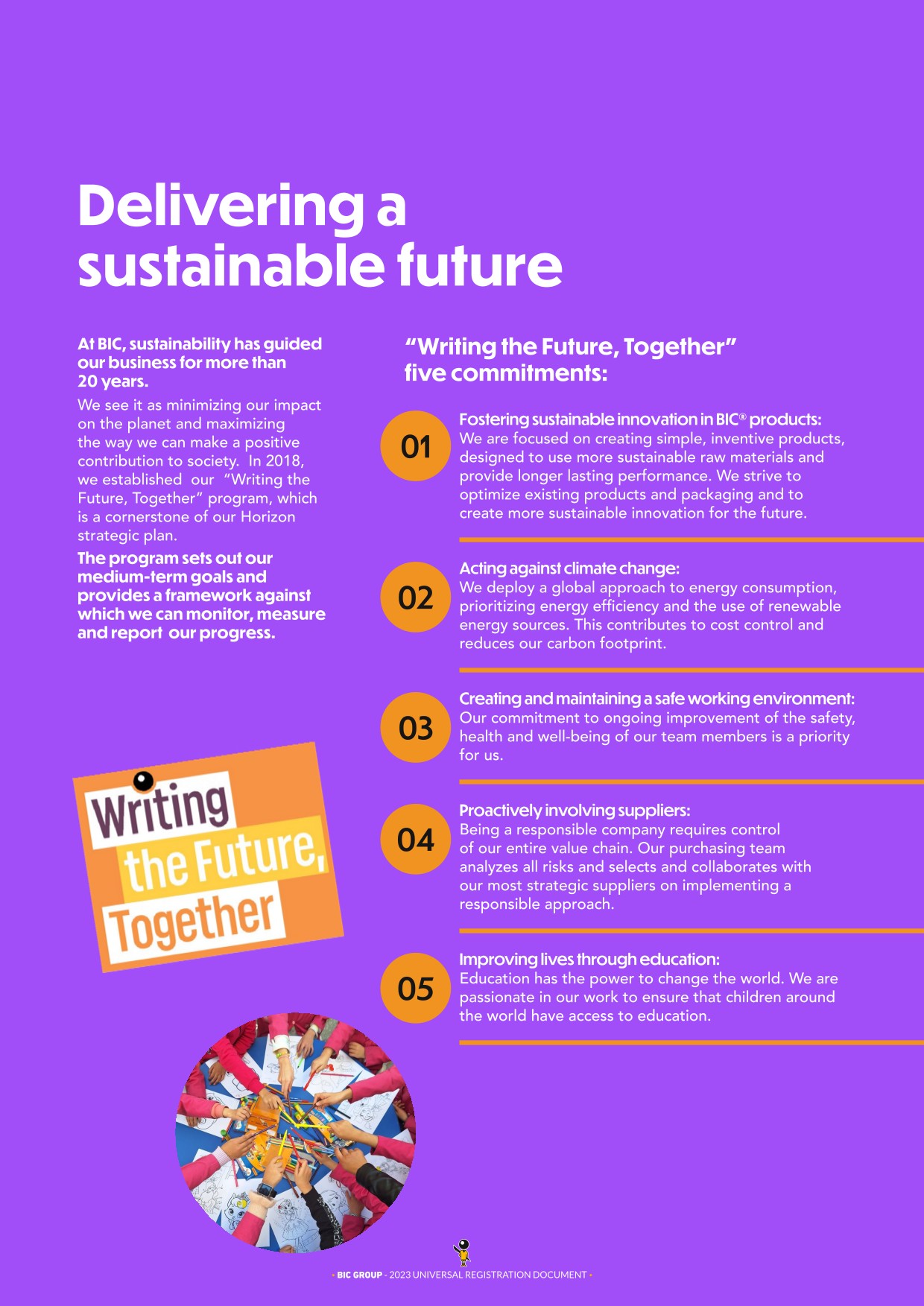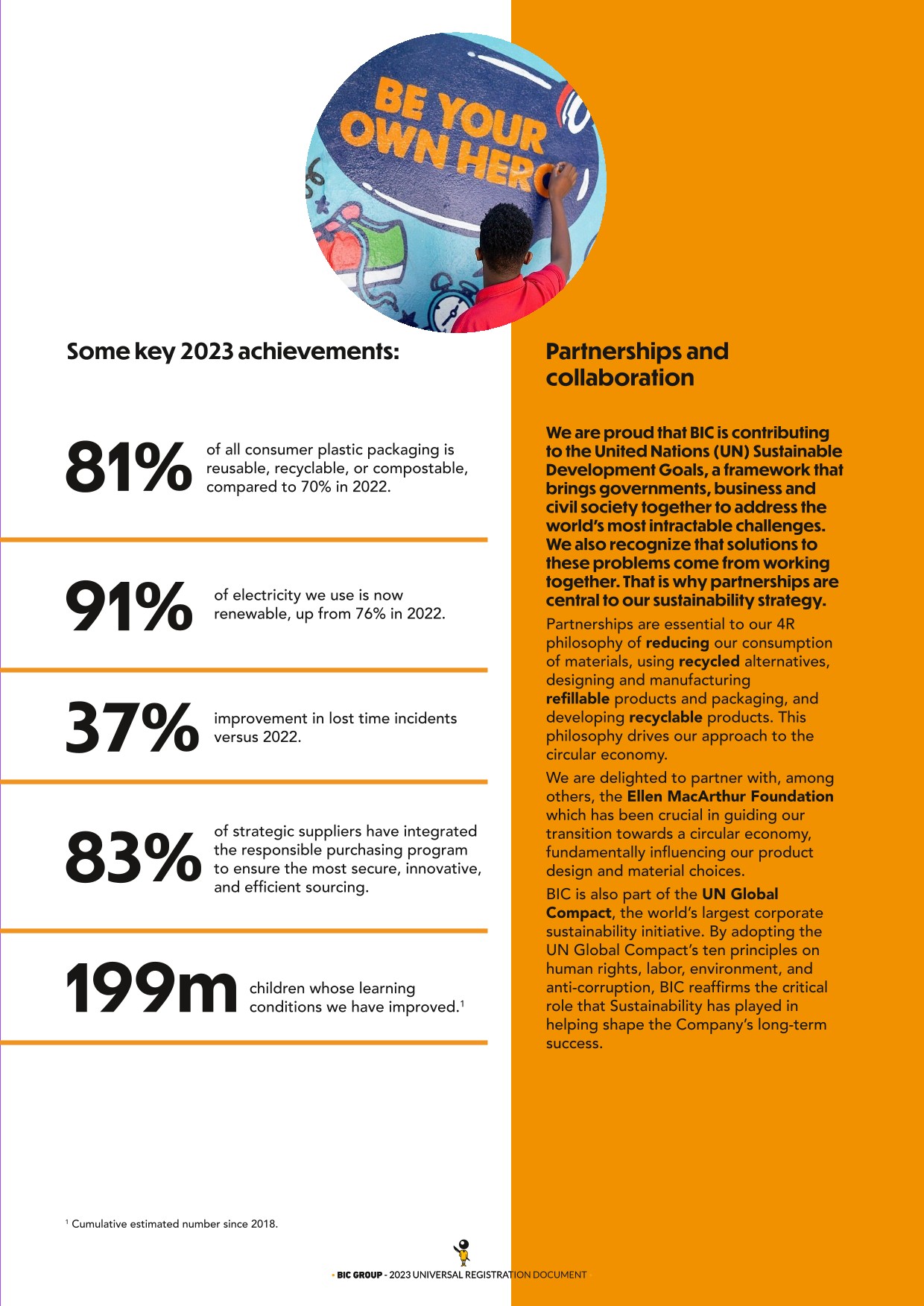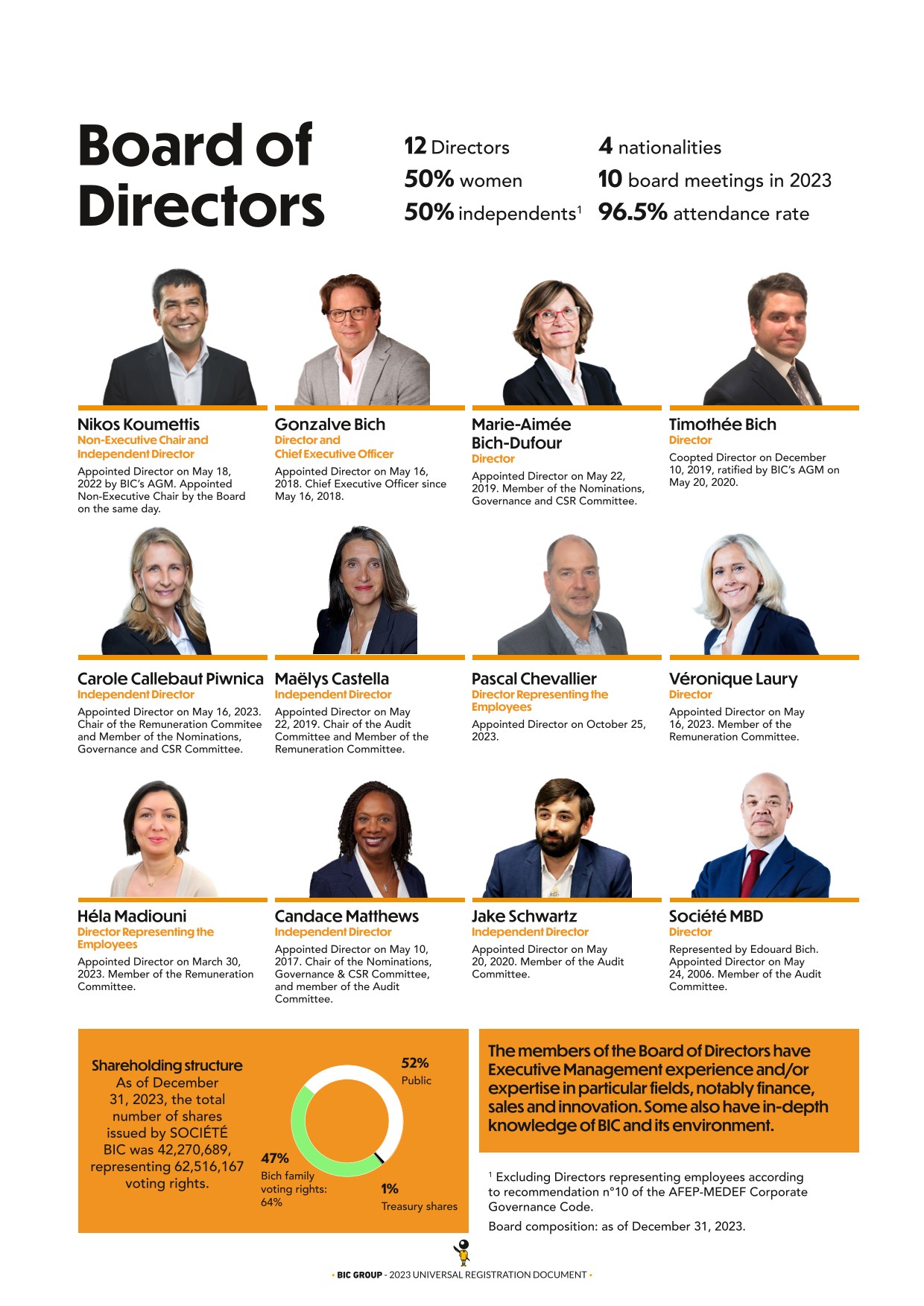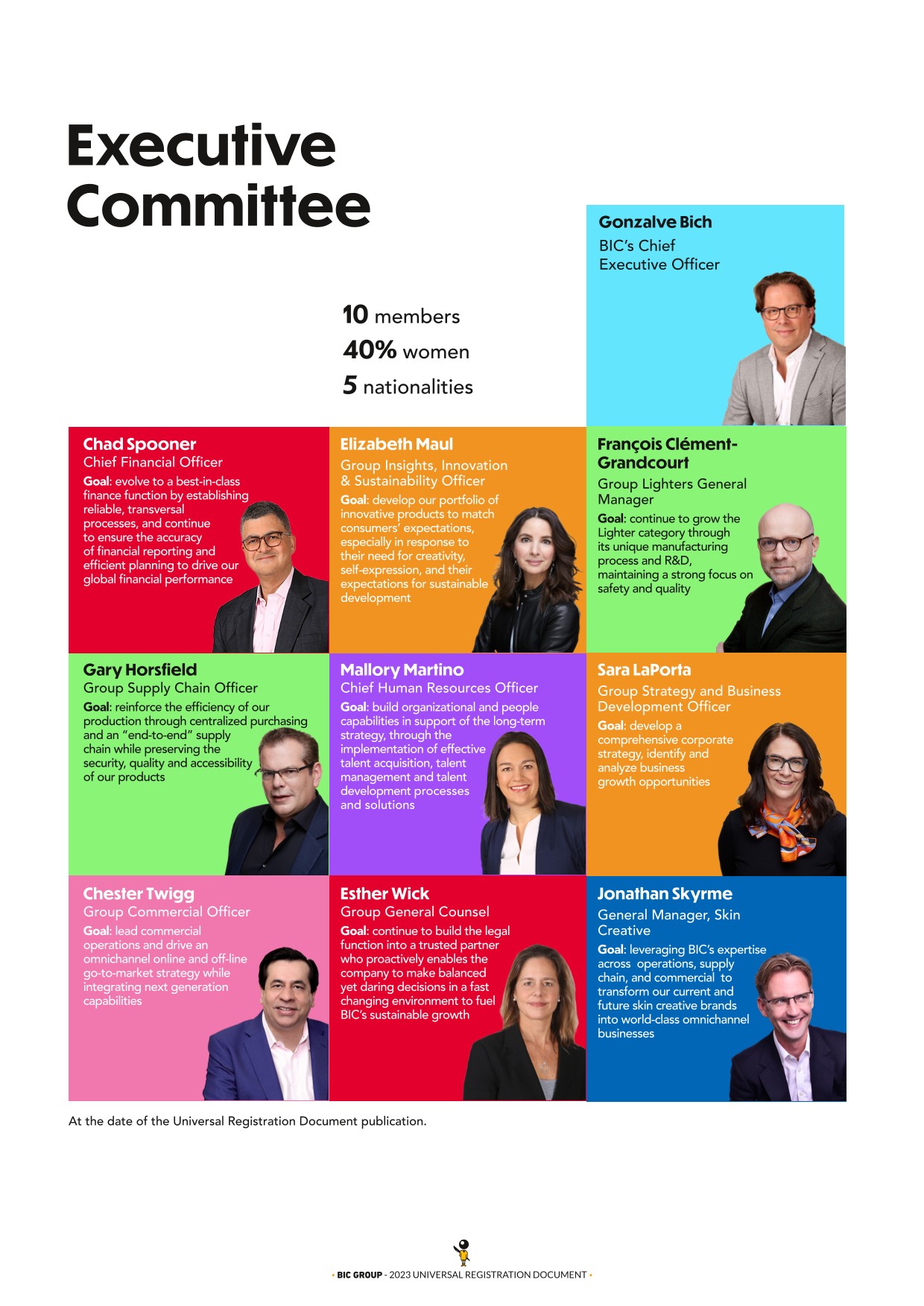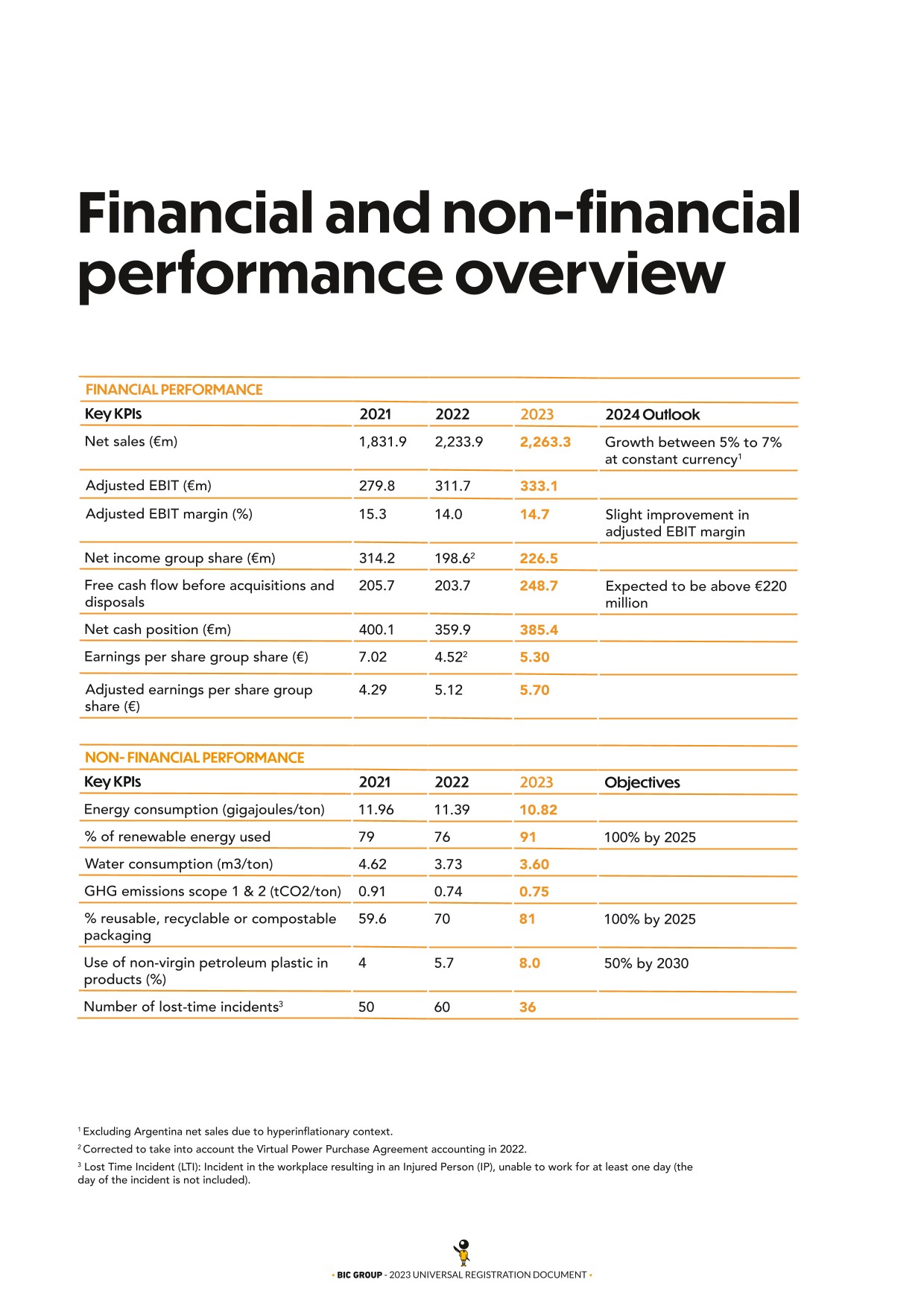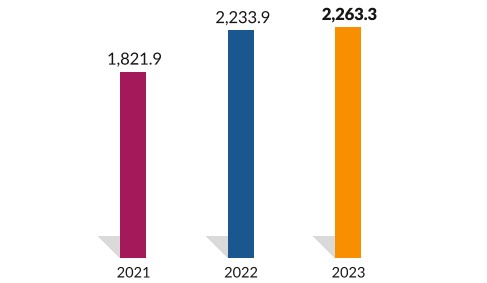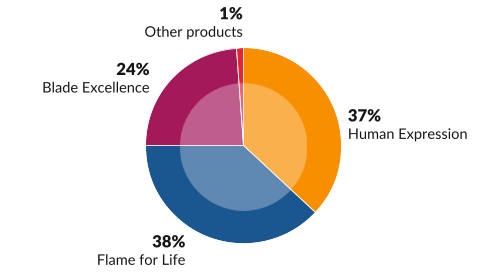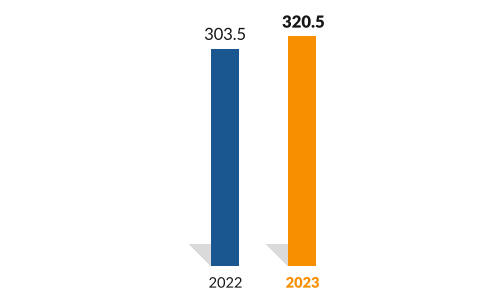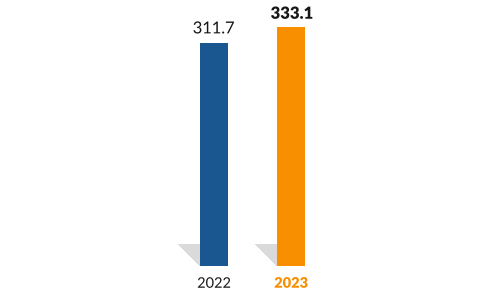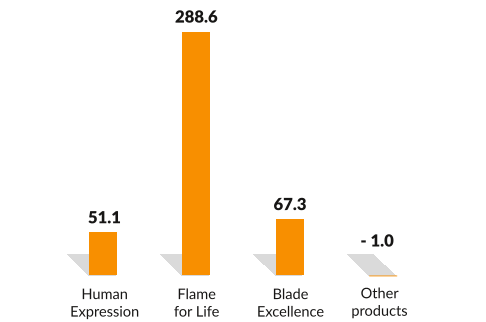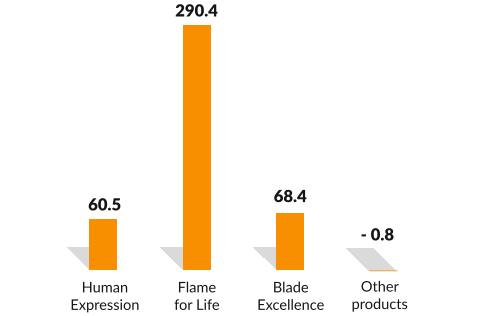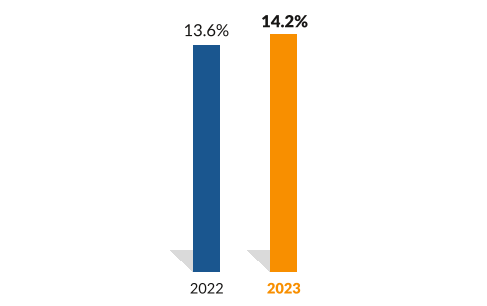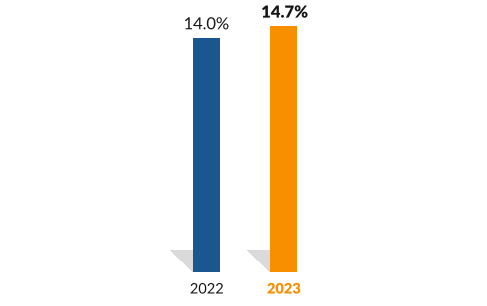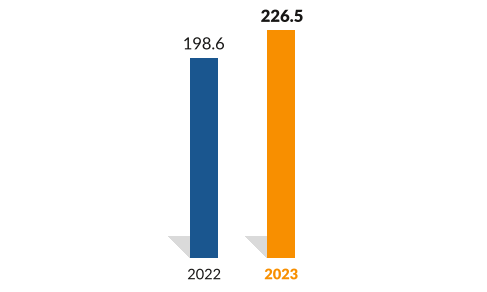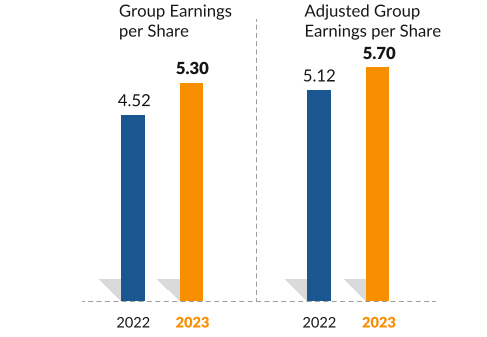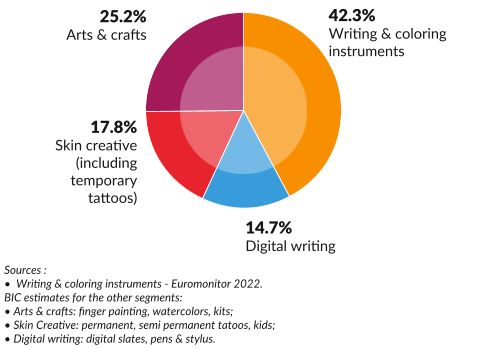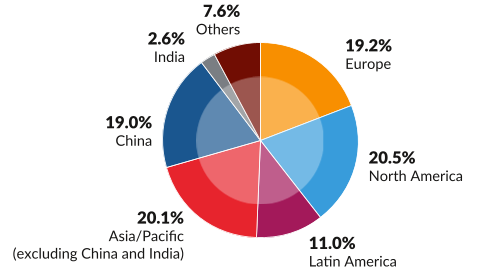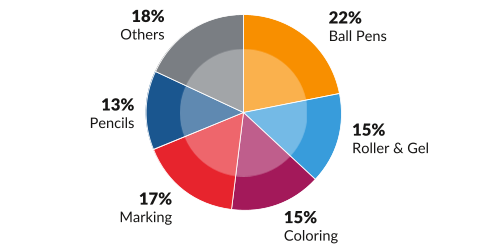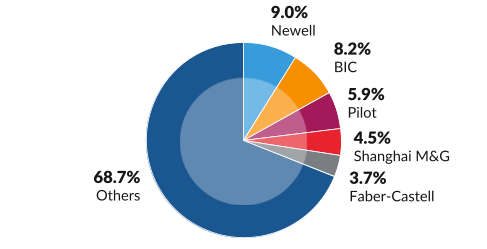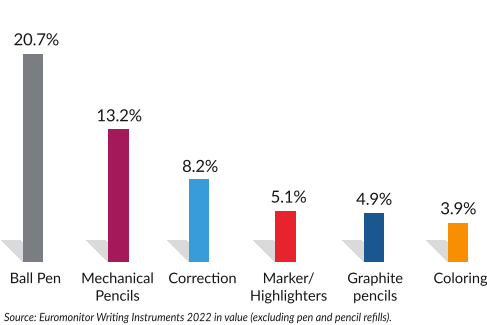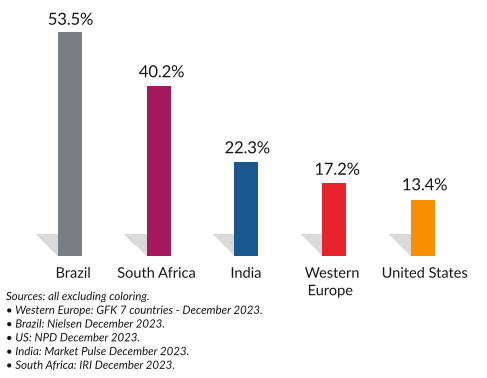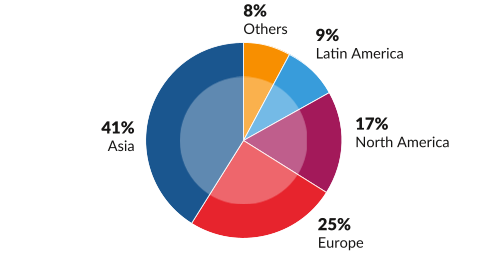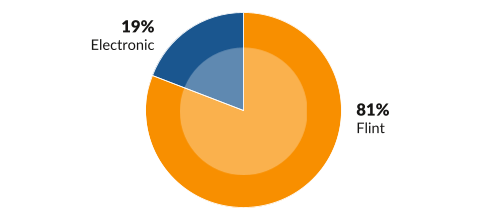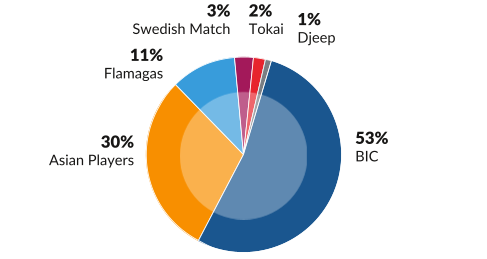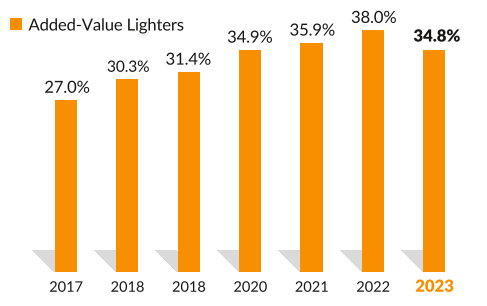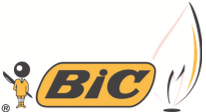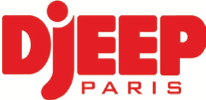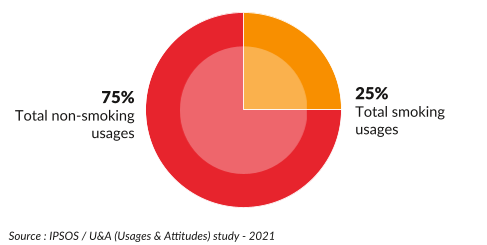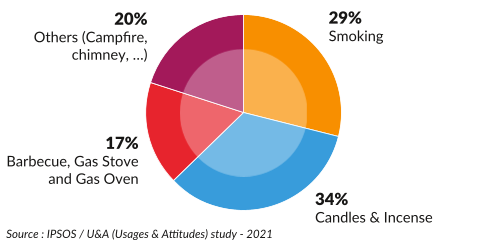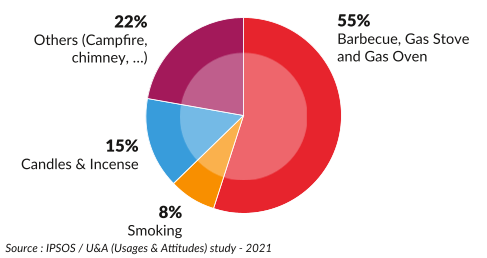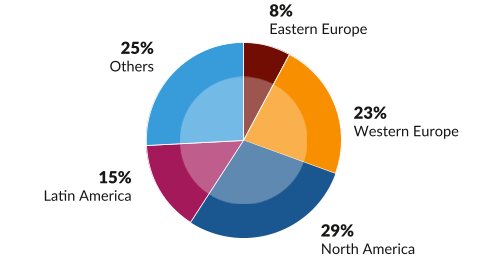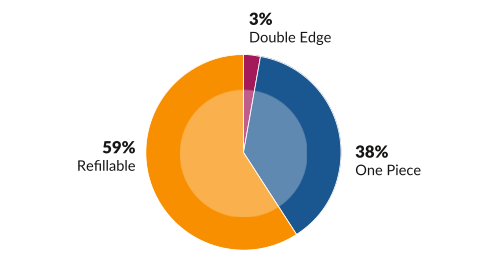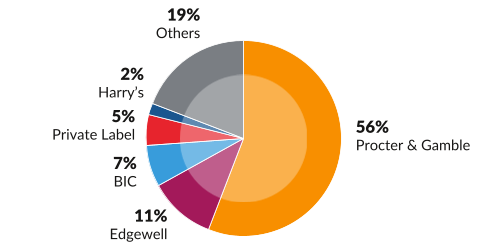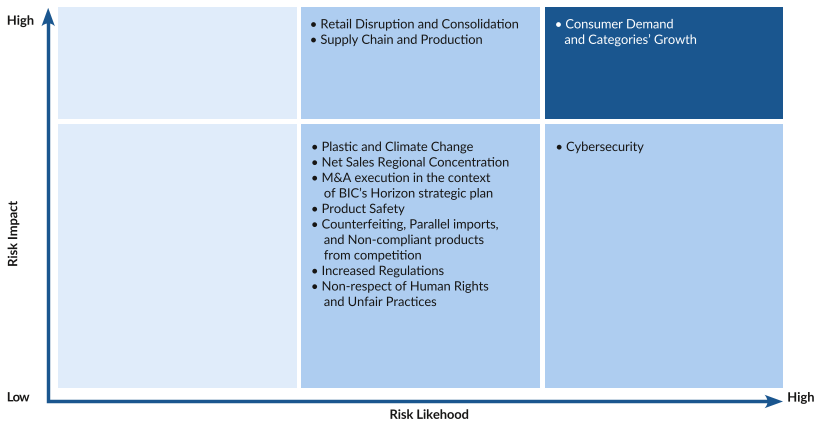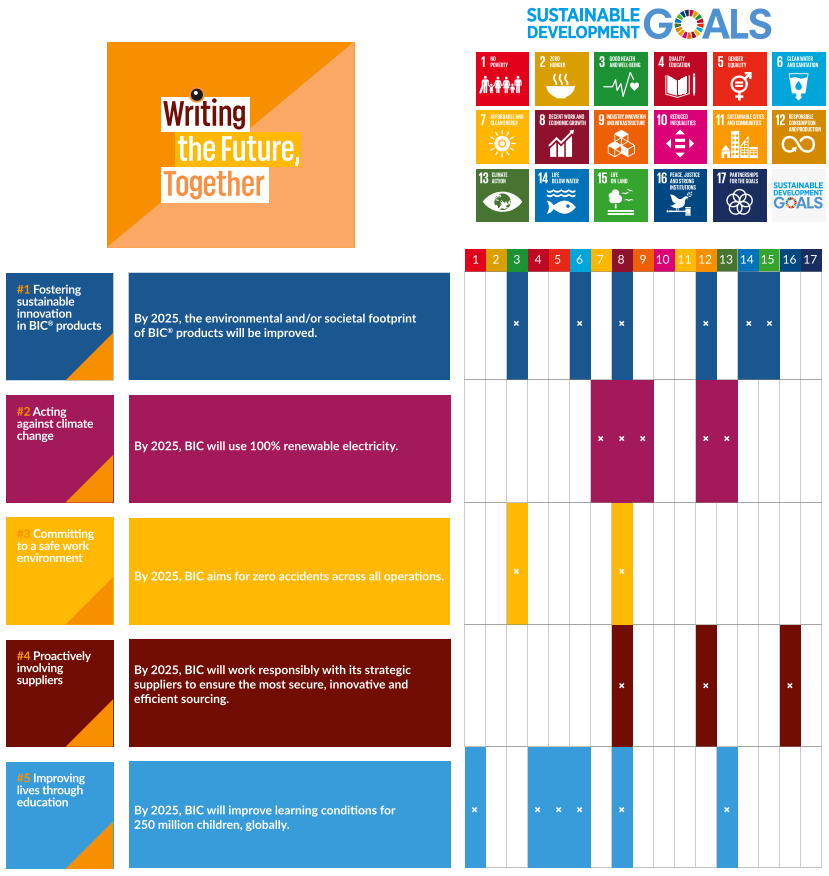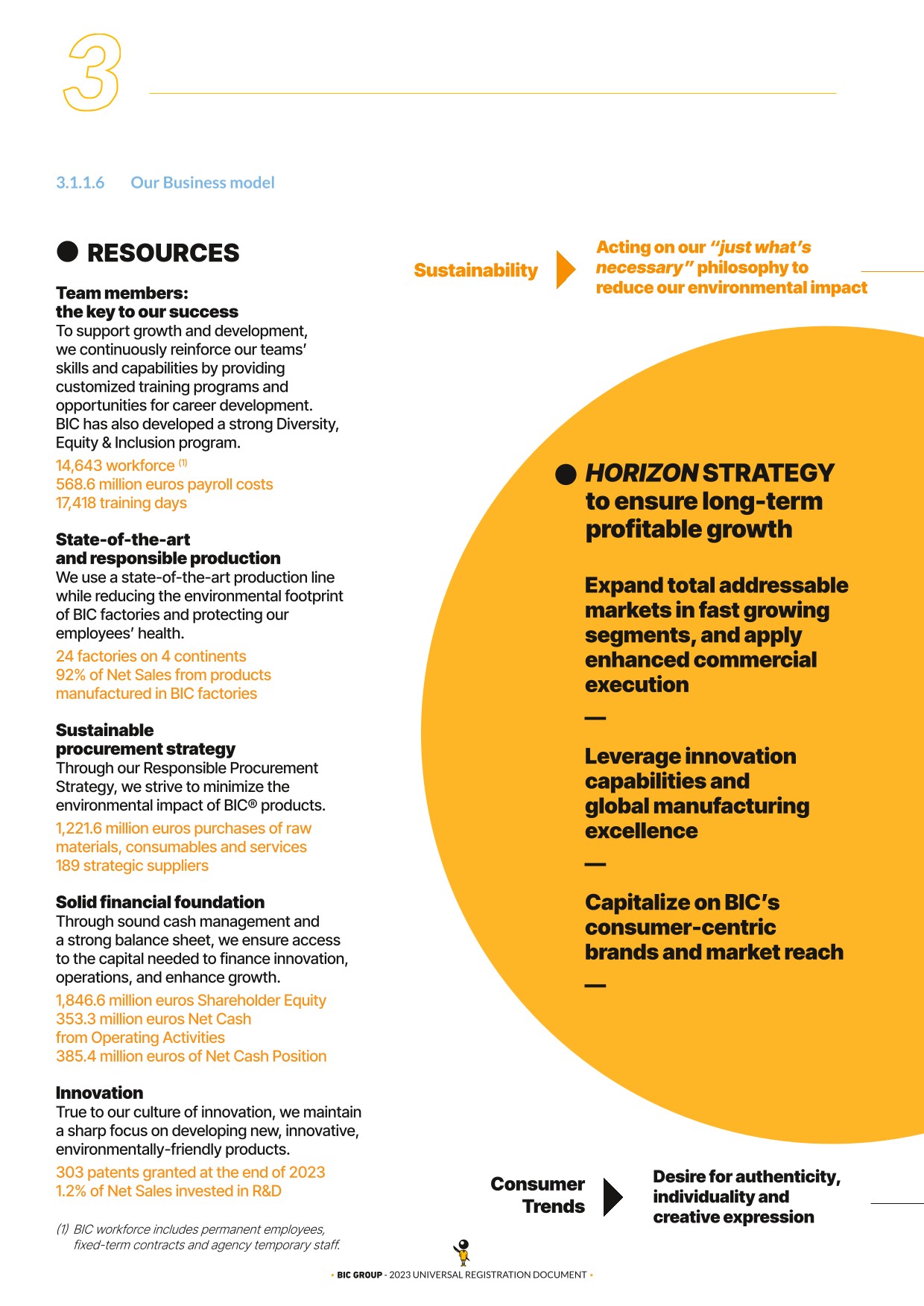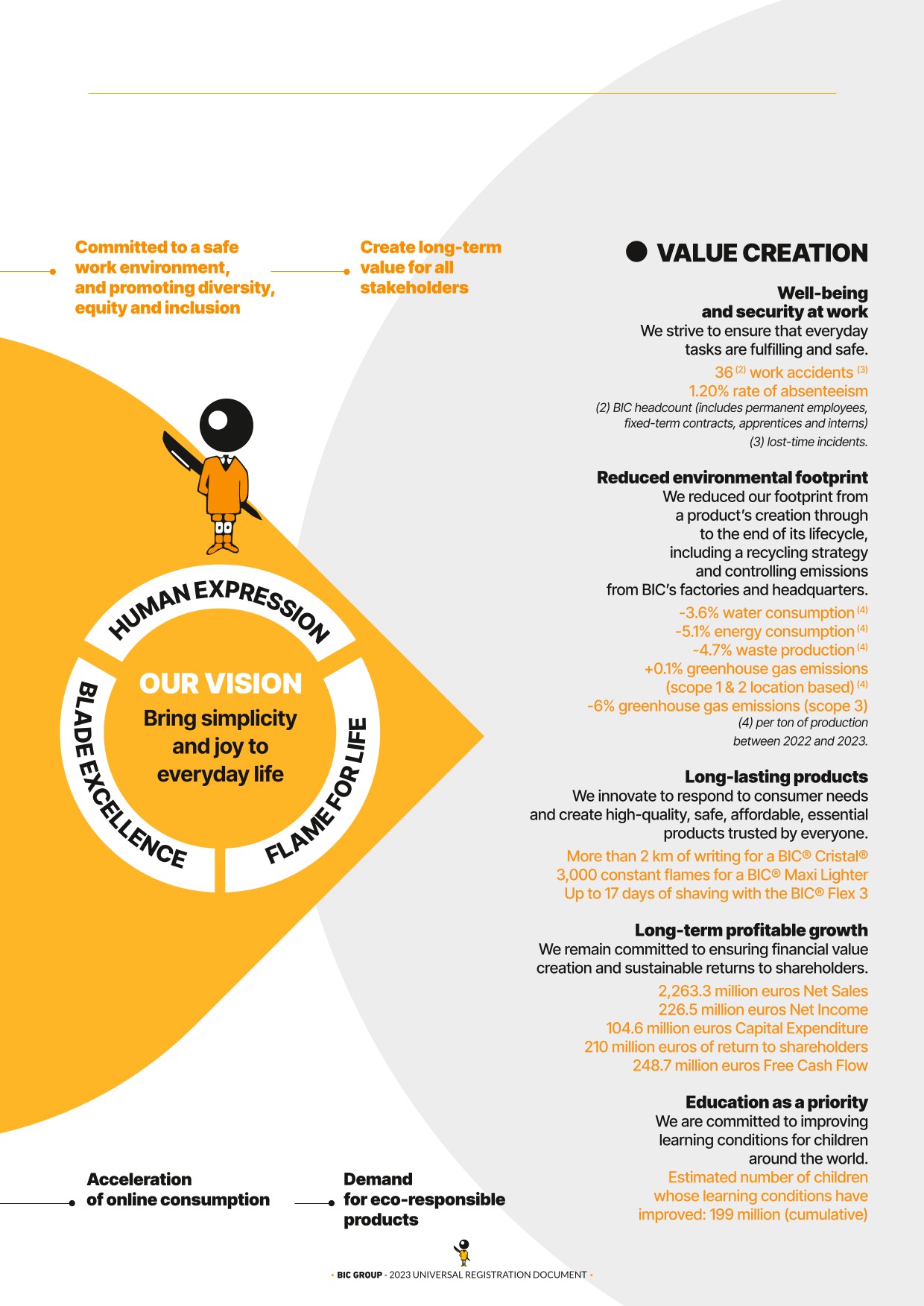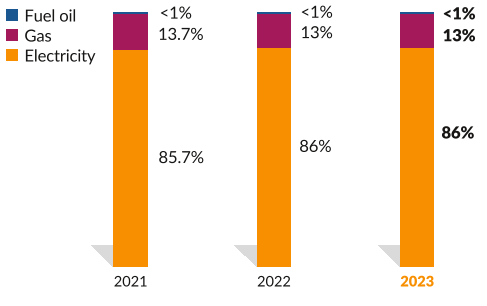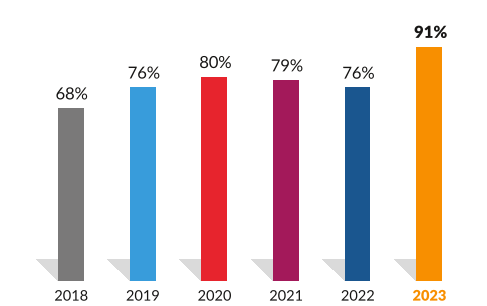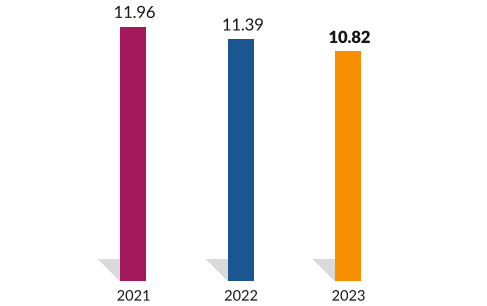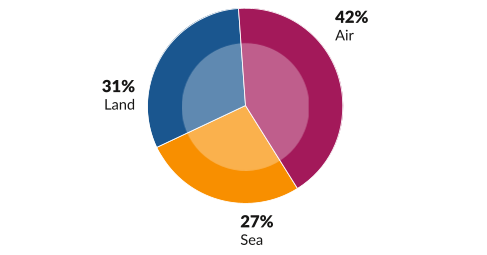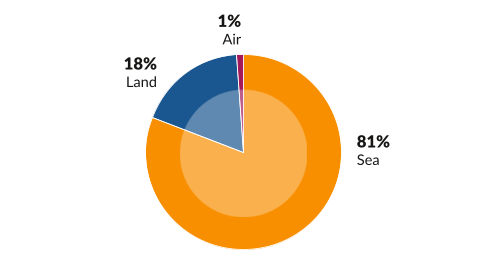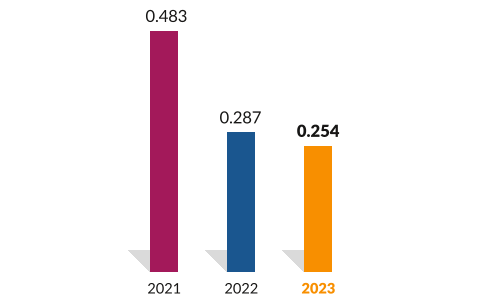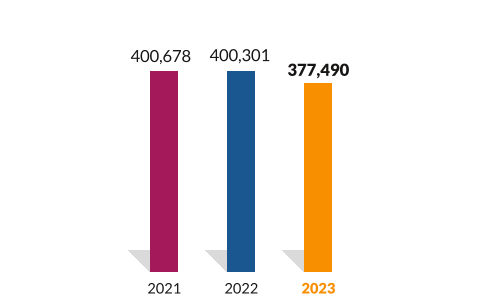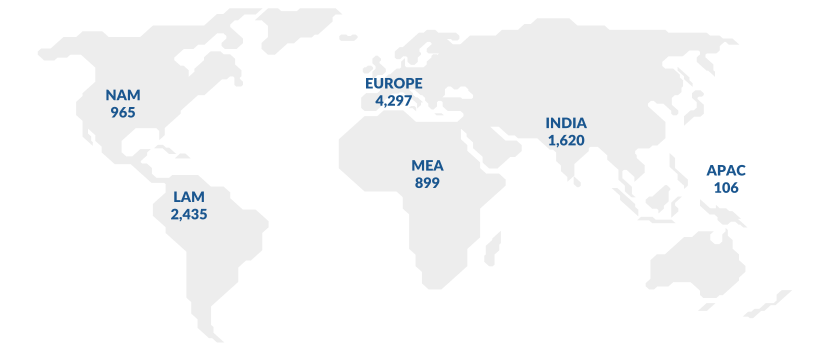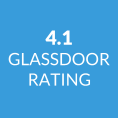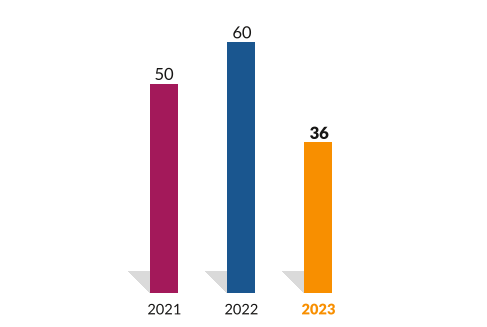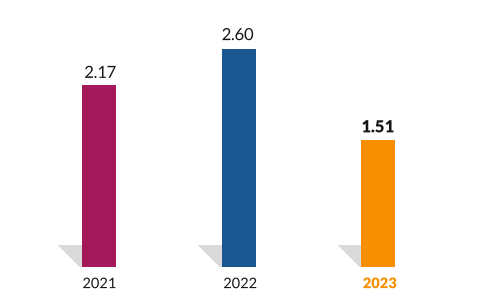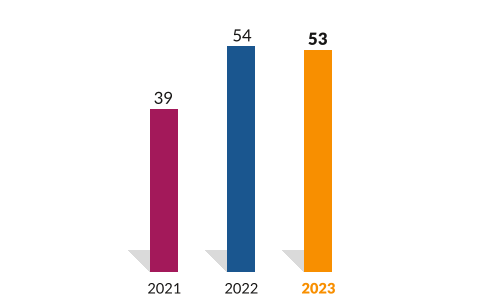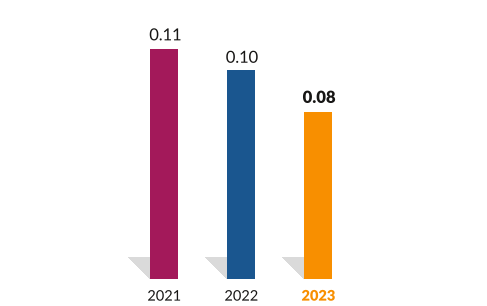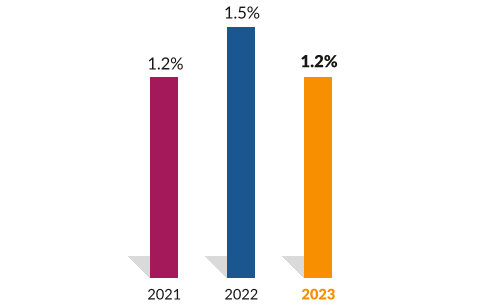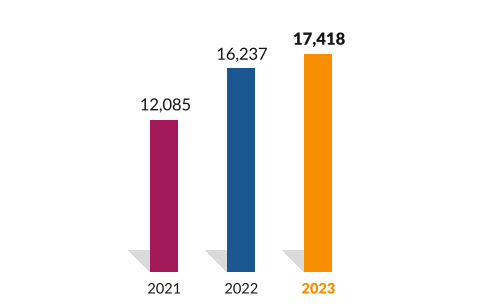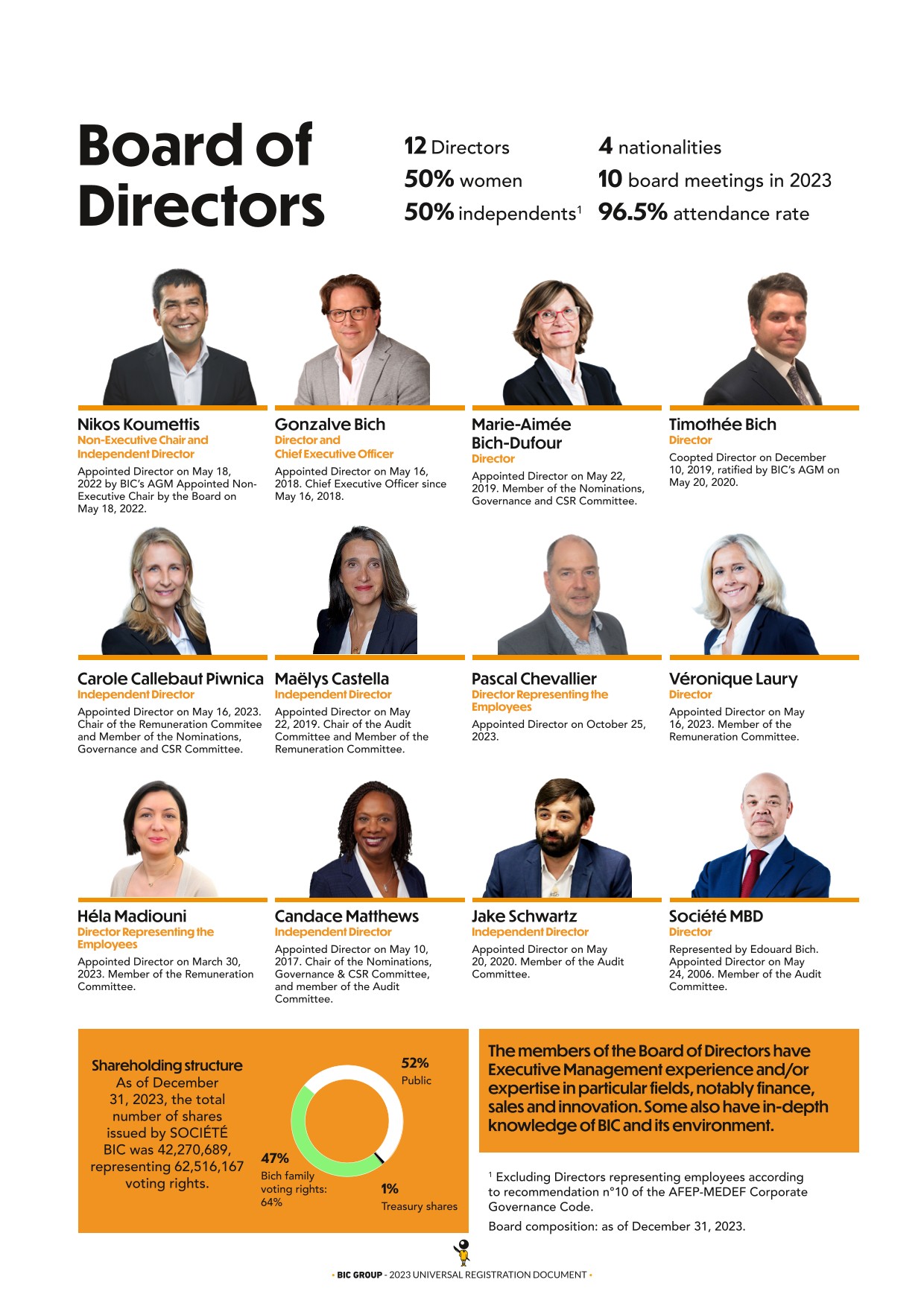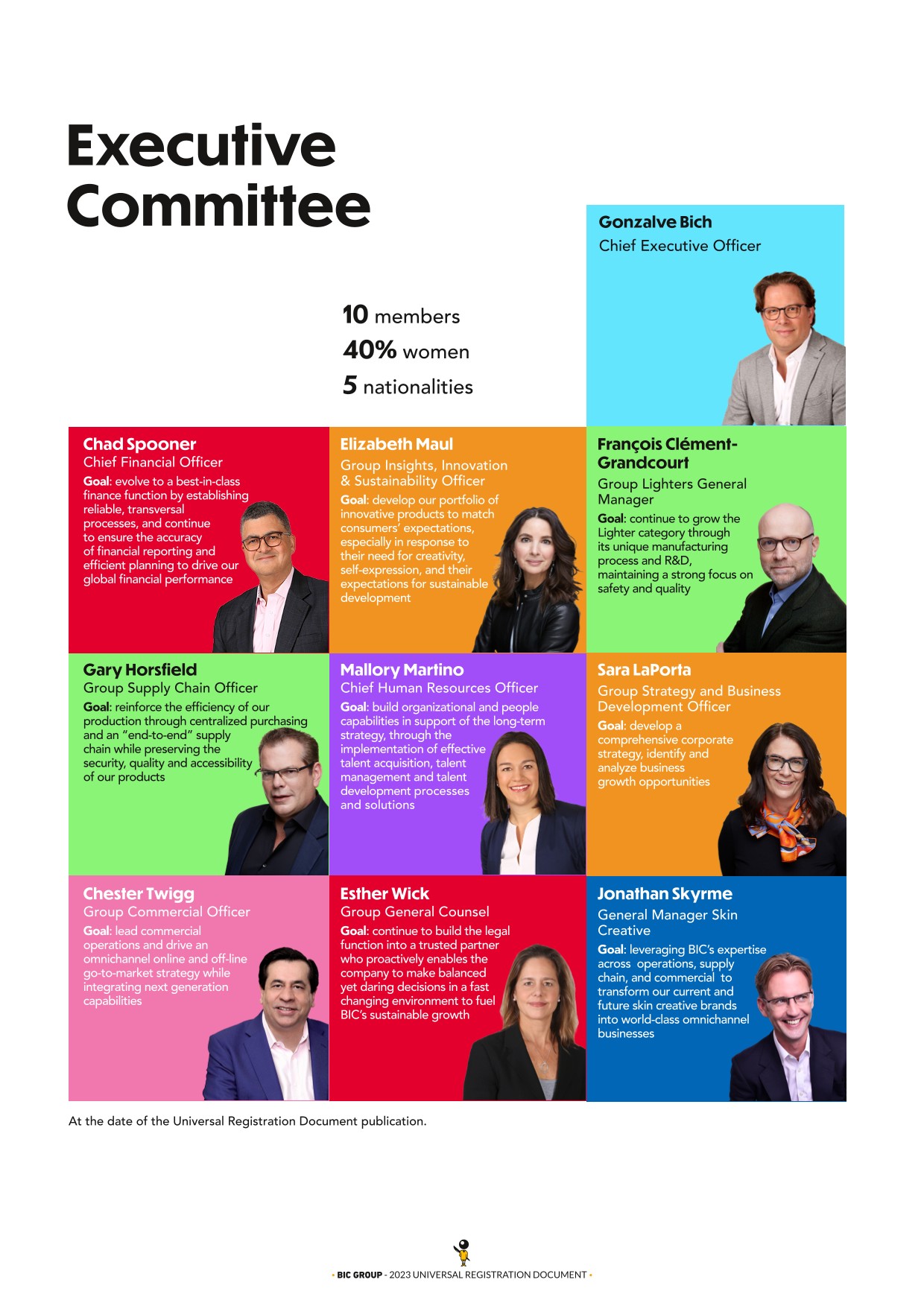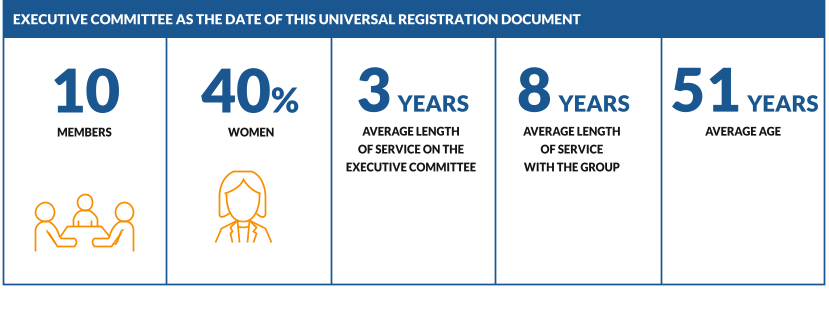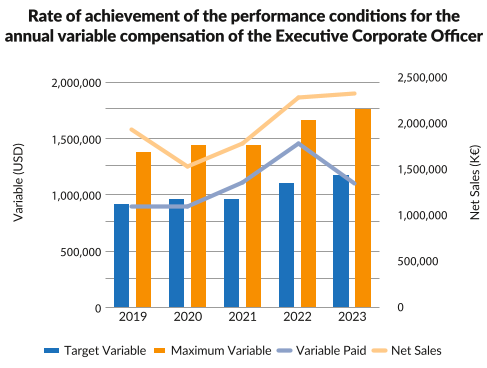URD 2023
-
Group presentation, Outlook, and strategy
1.1.History
Marcel Bich acquires a factory in Clichy, France, and starts a Writing Instruments business with his partner Édouard Buffard.
Launch of the “Pointe BIC®” in France, a revolutionary improved version of the Ball Pen invented by Hungarian Laslo Biro.
Acquisition of the Waterman Pen company in the United States. Expansion into Africa and the Middle East.
Diversification into the leisure industry through its subsidiary, BIC Sport, specializing in windsurf boards.
Acquisition of Tipp-Ex®, the leading European correction products brand, and Sheaffer®, a high-end brand in Writing Instruments.
Mario Guevara becomes Chief Executive Officer of BIC in May.
Acquisition of PIMACO, Brazil’s leading manufacturer and distributor of adhesive labels.
November: opening of a new shaver packaging facility in Mexico.
December: acquisition of Antalis Promotional Products (Sequana Group).
March: Acquisition of 40% of six (of the seven) Cello group entities, a leading stationery group in India.
June: Acquisition of Norwood Promotional Products, a U.S. leader in calendars and promotional products.
First-half: Disposals of the PIMACO B-to-B division in Brazil and the REVA Peg-Making business in Australia.
November: Acquisition of Angstrom Power Incorporated, a company specialized in portable fuel cell technology.
September: Launch of BIC® Education, an educational solution for elementary schools, combining handwriting and digital technology. Completion of the share purchase following the call option exercised on September 17 on Cello. Increase of BIC’s stake in Cello’s seven entities from 40% to 55%.
October: Acquisition of land in Nantong, China (130 km North of Shanghai) to build a Lighter production facility.
April: Sale of BIC’s Portable Fuel Cell Technology business to Intelligent Energy.
December: Cello sells its remaining stake in Cello to BIC. This raises BIC’s stake in Cello to 100%.
May: Mario Guevara retires from his position as Chief Executive Officer. The Board of Directors decides to combine the roles of Chairman and Chief Executive Officer and appoints Bruno Bich as Chairman and Chief Executive Officer.
June: Sale of BIC Graphic North America and Asian Sourcing operations to HIG Capital.
October: Opening of the new Writing Instruments facility in Samer (France).
May: Bruno Bich retires from his position as CEO. The Board of Directors decides to split the roles of Chairman and Chief Executive Officer. Pierre Vareille is appointed Chairman of the Board and Gonzalve Bich becomes Chief Executive Officer.
October: Filing by BIC of an infringement complaint with the European Commission for lack of surveillance of non-compliant Lighters that are either imported into or sold in France and Germany.
December: Acquisition of manufacturing facilities of Haco Industries Ltd. in Kenya and its distribution activities of Stationery, Lighters, and Shavers. Disposal of BIC Sport, BIC’s water sports subsidiary, to Tahé Outdoors and discontinuation of its Writing Instruments manufacturing operations in Vannes.
January: Inauguration of BIC’s Indian subsidiary BIC Cello, in Vapi (Gujarat state).
March: Inauguration of BIC’s East Africa Facility in Kasarani, Nairobi.
July: BIC filed a complaint with the European Ombudsman claiming maladministration by the European Commission of the infringement procedure initiated in 2010 against the Netherlands due to their lack of actions to impose lighters safety standards compliance.
October: Completion of the acquisition of Lucky Stationary in Nigeria (LSNL).
July: Acquisition of Djeep, one of the leading manufacturers of quality Lighters, reflecting BIC’s strategy of greater premiumization and personalization.
December: Acquisition of Rocketbook, the leading smart and reusable notebook brand in the United States, expanding BIC’s business into the Digital Expression segment.
December: Signature of agreement to sell its Brazilian adhesive label business, PIMACO, to Grupo CCRR, reflecting BIC’s portfolio rotation strategy and focus on fast-growing consumer segments.
February: Completion of the sale of BIC’s headquarters in Clichy-La-Garenne-based (France) and BIC Technologies sites for 175 million euros.
February: Completion of the divestiture of the Brazilian adhesive label business, PIMACO, to Grupo CCRR for 40 million Brazilian Real.
January: Acquisition of Inkbox, the leading brand of semi-permanent tattoos.
May: Appointment of Nikos Koumettis as Chair of the Board.
August: Acquisition of Tattly, a leading decal brand based in the U.S.
September: Acquisition of AMI (Advanced Magnetic Interaction), a French start-up pioneer in augmented interaction technology.
March: Héla Madiouni was appointed as Director representing the employees for the Board of Directors of Société BIC. She replacd Inna Kostuk who resigned on October 14, 2022.
May: Véronique Laury and Carole Callebaut Piwnica were appointed as Directors. Candace Matthews, Jacob (Jake) Schwartz and Timothée Bich were renewed as Directors.
September: The BIC 2023 Investor Update event took place in Paris, France, where BIC delivered an interim update on its five-year Horizon Strategic Plan, launched back in 2020.
October: Pascal Chevallier was appointed as Director representing the employees to the Board of Directors of Société BIC. He replaced Vincent Bedhome, whose term has expired.
-
1.2.Key figures
1.2.1Key financial figures
Net sales
2023 net sales by division
Earnings Before Interest and Taxes (EBIT)
Adjusted Earnings Before Interest and Taxes (aDJUSTED EBIT)
2023 EBIT by division
(in million euros)(1)
2023 Adjusted EBIT BY DIVISION
EBIT margin
Adjusted EBIT margin
Net income group share
Group Earnings per share and adjusted Group earnings
per shareSales volume trends
Production volume trends
Net sales by region
(in million euros)
FY 2022
FY 2023
Change as reported
Change on a comparative basis
Change at constant currencies
Group
Net Sales
2,233.9
2,263.3
+1.3%
+9.2%
+3.5%
Europe
Net Sales
636.7
665.9
+4.6%
+9.0%
+8.9%
North America
Net Sales
954.9
882.9
(7.5)%
(4.8)%
(5.1)%
Latin America
Net Sales
390.6
461.7
+18.2%
+42.6%
+12.0%
Middle East & Africa
Net Sales
136.4
154.2
+13.1%
+26.6%
+26.6%
Asia & Oceania (including India)
Net Sales
115.3
98.6
(14.6)%
(7.9)%
(7.9)%
Main income statement information
Condensed profit and loss account
(in million euros)
FY 2022 (a)
FY 2023
Net Sales
2,233.9
2,263.3
Cost of goods
1,155.9
1,115.2
Gross Profit
1,078.0
1,148.1
Administrative & other operating expenses
774.5
827.6
Earnings Before Interest and Taxes (EBIT)
303.5
320.5
Finance revenue/costs
(26.1)
(7.5)
Income before tax
277.4
313.0
Income tax expense
(78.8)
(86.5)
Net Income Group Share
198.6
226.5
Earnings per share Group share (in euros)
4.52
5.30
Average number of shares outstanding (net of treasury shares)
43,974,525
42,740,269
- ( a )Corrected to take into account the Virtual Power Purchase Agreement accounting
Key balance sheet aggregates
(in million euros)
December 31, 2022 (a)
December 31, 2023
Shareholders’ equity
1,866.0
1,846.6
Current borrowings and bank overdrafts
76.5
109.4
Non-current borrowings
42.8
46.8
Cash and cash equivalents – Assets
416.3
467.7
Other current financial assets and derivative instruments
17.3
19.8
Net cash position (b)
359.9
385.4
Goodwill and intangible assets
407.4
382.3
Total balance sheet
2,686.9
2,647.3
NB: Société BIC has not sought any rating from any credit rating agency. It also has not, to the best of its knowledge, been the object of any unsolicited rating by any credit rating agency.
- ( a )Corrected to take into account the Virtual Power Purchase Agreement accounting
- ( b )See Glossary.
Condensed cash flow statement
(in million euros)
2022
2023
Cash flow from operations
428.0
469.2
(Increase)/Decrease in net working capital
(29.2)
(27.4)
Other operating cash flow
(98.0)
(88.5)
Net cash from operating activities (a)
300.0
353.3
Net cash from investing activities
(172.5)
(114.1)
Net cash from financing activities
(175.2)
(192.1)
Net increase/(decrease) in cash and cash equivalents net of bank overdrafts
(47.6)
47.2
Closing cash and cash equivalents net of bank overdrafts
415.2
467.7
- ( a )See Glossary.
-
1.3.Strategy and objectives
For over 75 years, BIC® has met consumer needs and desires with high quality, simple, and affordable products and has become one of the most recognized global consumer goods brands, with products sold in more than 160 countries. Our vision is to bring simplicity and joy to everyday life, as we seek to create a sense of ease and delight in the millions of moments that make up the human experience.
Over time, the Group faced rapidly-changing industries and consumption trends affecting its three categories, as consumers habits and their interaction with brands continuously evolved. BIC’s mission to offer high quality products to consumers everywhere and meet their fast-changing needs, drove the Group's transformation from a manufacturing and distribution-led company into a consumer-centric one.
1.3.1BIC Horizon Strategic Plan
BIC’s Horizon strategy was launched in November 2020 to spur an in-depth transformation of BIC’s business and create the innovative products and services of tomorrow with more focus on consumer needs and sustainability. The goal was not only to amplify our core capabilities, but to go beyond them into higher-growth adjacent segments to ensure long-term sustainable growth and profitability. Horizon is embedded in the Group’s everyday operations and strategic goals.
As part of this transformation, BIC reframed its three core categories through a heightened consumer lens to tap into a stronger growth trajectory:
- ●in Stationery, BIC evolved its focus to “Human Expression”, responding to shifting consumer habits and expanding into the faster-growing Creative and Digital Expression markets;
- ●in Lighters, BIC expanded to “Flame for Life”, focusing on all consumer lighting occasions, including those non-related to tobacco, and driving towards a more balanced model between volume and value. Flame for Life is intended to drive incremental growth and maintain profitability, powered by trade-up and personalization, innovation, and a push toward sustainability;
- ●in Shavers, BIC decided to capitalize on its assets, ground-breaking innovation and manufacturing capabilities to leverage its “Blade Excellence” with the objective to maximize these assets by building a selective new business – named BIC Blade-Tech – as a high precision blade manufacturer for other brands.
Strategic and Financial Goals
Associated Targets
Growth acceleration
Deliver a mid-single-digit annual Net Sales growth trajectory
- ●Significantly expand total addressable markets in fast-growing adjacent segments, and evolve BIC’s business model to capture an increasing value share of our markets, with a strong focus on execution and return on investments.
- ●Leverage innovation capabilities and manufacturing excellence to generate incremental revenues through new routes-to-market.
- ●Capitalize on our brands in our core markets and build on new lifestyles to grow a comprehensive portfolio of consumer-led brands.
Cash flow generation
Improve efficiency and robust Free Cash Flow generation
- ●Disciplined management of operational investments, with a target of 1 to 1.2 times Capex to Depreciation & Amortization.
- ●Strict control of Working Capital (Inventories, Receivables, and Payables).
Sustainable development
Take Sustainable Development to the next level and transform approach to recycling and plastics
- ●By 2025: 100% of packaging will be reusable, recyclable, or compostable.
- ●By 2030: Use of 50% non-virgin petroleum plastic in our products.
Capital allocation
Fund organic growth and acquisitions in adjacent markets while ensuring sustainable shareholder returns
- ●Investments into operations to sustain and enhance organic growth with approximately 100 million euros annual CAPEX investments. In 2024, CAPEX should be approximately 110 million euros.
- ●Targeted acquisitions to strengthen existing activities and develop in adjacent categories, with an average of 100 million euros invested annually.
- ●Objective of ordinary dividend pay-out ratio in the range of 40% to 50% of Adjusted EPS.
- ●Regular share buybacks. Up to 40 million euros Share Buyback program to be executed in 2024.
At our Investor Update on September 11, 2023, we outlined how our Horizon Plan has shaped the future of our business and accelerated sustainable, profitable growth since its launch in November 2020.
- ●annual net sales: growth of 5-7% at constant currencies;
- ●adjusted EBIT margin: approx. 150bps improvement from the 2022 level of 14.0%;
- ●free cash flow: above €220 million in 2024, above €240 million in 2025(2).
- ●We reinforced our marketing capabilities and innovative campaigns to drive category growth. In the US, EZ Reach utility pocket lighters reached 5.8% of market share in value, up +0.4 points fueled by strong distribution and in-store visibility in the Modern Mass market. In the Blade Excellence division, our latest shaver innovations Easy Rinse and Soleil Escape both outpaced the market and gained a combined total of 1.8 pts in value share.
- ●Innovation continued to flourish, with 9.5% of sales coming from new products introduced in the last three years, up 0.5 pts versus last year. The number of patents granted, one of our input indicators which reflects our innovation pipeline, remains strong and in line with our Horizon aspirations.
- ●We continued to focus on expanding our presence both offline and online. eCommerce online sales represented 12.7% of the Group’s net sales in 2023, growing 13% at constant currency driven by the B2B channel in key countries notably US, France and Brazil.
- ●In line with our Revenue Growth Management discipline, our strategic emphasis on crafting a consumer-focused product lineup led to a Net Sales per SKU growth of 21.4% and a 9% reduction of total SKU count, outpacing our objectives. The resulting price and mix benefit successfully outpaced volume and inflation headwinds.
- ●Our B2B business BIC Blade Tech was impacted by clients’ revised business plans. However, in the fourth quarter it secured agreements with three new clients. These partnerships are promising and are expected to bear fruit in 2024. Additionally, we have reached an agreement with our largest customer to test additional product launches in 2024.
- ●We continued to drive excellence in procurement in 2023. We delivered additional direct and indirect savings mainly driven by plastics and packaging value engineering, as well as electricity hedging in France. This contributed, in part, to our strong gross profit margin improvement of 240 basis points in 2023.
- ●After a strong start in 2022, we intensified our efforts in value engineering, identifying close to €10 million of savings validated to date.
-
1.4.Business presentation
BIC is one of the leading players in the stationery, lighter, and shaver markets. Guided by our long-term vision, we provide high-quality, affordable products to consumers everywhere. This consistent focus has helped make BIC® one of the world’s most recognized consumer products goods companies, with products sold in more than 160 countries.
1.4.1Business presentation by division
BIC’s Horizon strategic plan launched in November 2020, aimed at driving sustainable growth by reframing our three categories to expand our total addressable markets in fast-growing segments.
1.4.1.1Human Expression – Stationery
In line with its Horizon strategy, BIC’s historical Stationery category evolved towards “Human Expression” to go beyond core Writing Instruments into Creative and Digital Expression. BIC constantly innovates to further strengthen its presence in both existing and adjacent segments.
Human Expression encompasses Writing and Coloring Instruments, Creative Expression which includes Arts and Crafts, Skin Creative and Digital Expression. Human Expression is a mid- single-digit growth market, which should reach c.52 billion euros by 2026 (5).
Since the launch of the BIC® Cristal® pen in 1950, BIC has continuously diversified its Stationery product range through more added-value products and innovative launches and with an increased focus on sustainability, simplicity and joy.
To name a few in the last three years, BIC launched BIC® Break-Resistant, a mechanical pencil with lead that is 75% stronger than the leading U.S. competitor, a BIC® Ecolutions Gel Pen made of 78% ocean-bound plastic, anti-bacterial pen BIC® Clic Stic® PrevaGuard™ a new coloring range called Intensity, its first rechargeable metallic ball pen BIC® Cristal® Re’New™. In 2020, BIC acquired Rocketbook® the leading brand in Reusable Digital Notebooks. In 2022, BIC diversified further its brand portfolio, with the acquisition of Inkbox, the leading brand of high quality semi-permanent tattoos (high-quality 10-14 days decals), and Tattly, a U.S. startup innovating in the field of high-quality temporary decals (2-4 days), which will diversify BIC’s offering in the rapidly growing Skin Creative market. In the Digital Writing segment, BIC acquired AMI (Advanced Magnetic Interaction), a French innovative startup. AMI will strengthen BIC’s R&D capabilities in Digital Expression.
In 2023, BIC’s global product portfolio included writing, marking (classic, permanent and temporary tattoo markers), correction, coloring, drawing instruments, semi-permanent tattoo, and smart reusable notebooks.
Breakdown of the Human Expression market size per segment IN 2022
BIC’s markets and positioning
Core Writing & Coloring Instruments Market
BIC’s historical market Writing and Coloring Instruments amounted to 20.3 billion (6) euros in 2022. The Category is expected to grow at around 4.0% CAGR 2022-2026(7) driven by the rising demand from developing countries and innovation which will fuel growth in the Developed countries. Although the market remains highly fragmented, with many local players and family-owned businesses, it is dominated by three players (BIC, Newell Brands and Pilot) with each recording an estimated market share of over 5%. In 2022, BIC attained the #2 global manufacturer position with 8.2% market share, benefiting from good positions in both Developed and Developing Markets.
Over the years, BIC strengthened its presence in Writing and Coloring Instruments’ market through innovative launches enabling market share gains in key countries, whether it be in core writing instruments or in added-value segments. In 2023, BIC notably gained share in the Coloring segment in France, the UK and the US.
Breakdown of the Writing Instruments market
By region
By product segment
main market leaders
BIC’s market share by segment
BIC’s Market share by region -2023
Although BIC’s portfolio is currently concentrated in historical core Writing Instruments segments, the Group’s ambition is to shift towards more added-value and adjacent segmentswhich are in growing. In 2023, 23% of Human Expression Net Sales came from the Creative and Digital Expression segments.
Creative Expression markets
The Arts and Crafts market is a large market experiencing mid-single-digit growth (estimated at 10.9 billion euros in 2022) (8). The market is expected to grow by 3% (CAGR 2021 – 2026) thanks to the increasing demand of both kids’ and teens’ market as well as from adults asking for more creativity. Kids’ crafts account for more than 50% of the total. It includes a variety of sub-segments including Finger-painting, Watercolors, Kits, Crafting Accessories, Modeling Clay and Slime .
The Skin Creative market estimated at 7.7 billion euros includes the permanent tattoos and the “Do it Yourself” Skin Creative segments. The fast-growing “Do it Yourself” Skin Creative segment includes temporary tattoo markers, temporary decals, henna tattoos and semi-permanent tattoos. It is expected to exceed 1.3 billion euros in 2035, powered by the increasing desire of young consumers to be more fluid with their appearance and to express themselves using their body as a changeable canvas. Market players are mostly non-branded small companies:
- ●BIC entered the Skin creative market in 2018 through the launch of Bodymark®, an innovative temporary tattoo marker to address consumers’ attitudes shift towards self-expression, individuality and creativity;
- ●the acquisition of Inkbox in 2022 elevates BIC to a leadership position in the Do-It-Yourself Skin Creative industry (high-quality 10-14 days decals) and further enhances the Group’s existing portfolio of recognized consumer products, where different brands address diverse types of consumer groups. With its unique ability to customize, Inkbox further strengthens BIC’s DTC business and reinforces existing digital and social media engagement capabilities;
- ●in August 2022, the Group acquired Tattly, a U.S. startup innovating in the field of small high-quality 2-4 days decals, diversifying BIC’s offering in the rapidly growing Skin Creative market and particularly in the kids’ segment.
Digital Expression market
The Digital Writing market was estimated at 6.4 billion euros in 2022 (1). As technology is improving and becoming more affordable, this market should grow by 6% CAGR 2021-2026(1) to weigh above 8 billion euros. It encompasses four main sub-segments: reusable notebooks, smart pens, slate tablets, and stylus for tablets:
- ●BIC’s entered into Digital Writing through the acquisition of Rocketbook® in 2020, the leading smart and reusable notebook brand in the U.S.;
- ●in 2022, BIC strengthened its R&D capabilities in Digital Writing with the acquisition of AMI (Advanced Magnetic Interaction), a French company specialized in the augmented interaction technology. AMI has designed the ISKN Repaper digital tablet, which allows users to capture paper writing and drawing in an electronic format;
- ●in 2023, BIC launched new products in its Rocketbook range.
BIC’s Brand Portfolio in Human Expression
BIC was built on the amazing power of its Brand, which is one of the world’s most popular household names. Over time, other brands have been added to our portfolio, most of them using BIC as an umbrella to drive attractiveness and consumer engagement, including Tipp-ex®, Wite-Out® and, more recently BodyMark® by BIC.
With Horizon, BIC started to migrate to a “house brands” strategy, where each brand has a different meaning for consumers. The acquisitions of Rocketbook and more recently Inkbox and Tattly further strengthens this approach. BIC’s Human Expression division now offers a diversified panorama of brands, where consumers can each see themselves reflected and find their “own” brand favorites.
BIC’s Distribution Channels
Echoing its historical strategy “A BIC seen is a BIC sold”, BIC’s mission is to offer products available to consumers every day and everywhere.
BIC products are sold through a comprehensive range of channels worldwide as the Group pursues its objective to be an omnichannel specialist both offline and online. Products can be found in retail mass-market distributors, eCommerce channels (pure players, market places, B2B and B2C omnichannel retailers), traditional stores and Office Product suppliers (through contract or office superstores).
In the retail mass-market channel, Back-to-School season remains a key period. BIC offers consumers a tremendous range of school and college products through numerous displays, theatralization (for example the iconic school bus display in Europe) and merchandising tools.
Office and school supply companies remains a critical distribution channel where BIC has a strong position thanks to the quality, reliability and value for money positioning of its product, all even more important for companies, administrations and schools.
In the last few years, BIC strengthened its distribution network by reinforcing its e-commerce positions. In 2023, BIC maintained its leading positions in Stationery online in key markets: the Group ranked number 1 in France with 21% market share, number 2 in the UK with 21% market share, and number 3 in the U.S. with almost 14% market share (in value YTD December 2023).
1.4.1.2Flame for Life – Lighters
In line with its Horizon strategy, BIC’s historical Lighter category evolved to “Flame for Life”, focusing on all lighting occasions. Flame for Life aims to balance volume with a more value-driven model, powered by trade-ups, personalization and innovation, to respond to changing consumer trends, while focusing more on sustainability.
BIC’s market and positioning
The worldwide pocket lighter market is estimated at 13.4 billion units (€4.9 billion in value) (9).
Breakdown of the global pocket lighter market in 2022
By region
By product segment (excluding Asia)
Market leaders (excluding Asia)
BIC’s leadership position and market shares
BIC is #1 worldwide in branded pocket lighters in value, with more than a 50% share in value in 2022 (excluding Asia) and leading positions in key geographies including North America, Latin America and Europe. The competitive advantages supporting BIC’s leadership position include safety, quality, strong brand awareness, automated and highly efficient manufacturing processes, and a solid distribution network.
BIC® pocket lighter market share in value in 2022 (excluding Asia)
Safety and quality, key differentiators for BIC
BIC is well-known for providing safe, high quality and compliant lighters to consumers worldwide. A lighter is a plastic reservoir filled with pressurized gas that is lit by a flame. It can present a real danger if it is not designed and manufactured properly. The consequences can be severe and are often unknown to consumers. International Safety Standards protect consumers from unsafe lighters.
- ●international lighter safety standard ISO 9994, which sets out the basic safety requirements for a lighter. ISO 9994 is mandatory in major markets such as Canada (1989), Russia (2000), Brazil (2002), South Africa (2002), Argentina (2003), Thailand (2003), Mexico (2004), South Korea (2005), the 27 European Union member states (2006), Japan (2011), Indonesia (2011) and Turkey (2012);
- ●child-resistant requirements. A child-resistant lighter is purposely modified to make it more difficult to operate by children. Under this standard, the basic requirement is that a lighter cannot be operated by at least 85% of children under 51 months. Child-resistant legislation is mandatory in major countries such as the U.S. (1994), Canada (1995), Australia (1997), New Zealand (1999), the 27 members of the European Union (2006), Japan (2011), South Korea (2012) and Mexico (2016).
All too often, low-cost lighters too often fail to comply with safety standards. Since the late 1980s, lighter models imported from Asian countries have gained market share. They currently account for over half of the global market (in volume).
BIC has been defending its position in this competitive landscape since its creation and advocates for enhanced lighter safety and quality. BIC® lighters comply with even more stringent safety, quality, and performance requirements. For example, the gas reservoirs of BIC® lighters are made from POM (PolyOxyMethylene), a high-performance resin with very high impact resistance. This means that BIC® lighters contain more gas, allowing more ignitions thanks to their wall’s thinness. They are also filled with pure isobutane, which ensures the flame’s stability throughout the lighter’s life.
Towards a more value-driven model through trade-up and innovation
BIC offers a wide range of high-quality Pocket and Utility lighters manufactured with the highest safety standards.
While BIC’s shift to balance more volume with value in the model for its Lighter business started years ago, this was accelerated with the launch of the Horizon Plan. More recently the following developments were made to support this transformation:
- ●the acquisition of Djeep in June 2020, which strengthened BIC’s portfolio in the added-value segment of decorated lighters;
- ●the launch of BIC EZ Reach™, BIC’s first pocket Utility lighter, in July 2020. The product has already reached 5.8% of the U.S. pocket lighter market (Source: IRI YTD December 2023). In Europe, The EZ Reach™ lighter which was launched into most major markets in Europe accounted for almost 20% of total division’s growth versus last year;
- ●the deployment of Revenue Growth Management strategy to drive efficiency in promotional and pricing activities.
In 2023, added-value lighters, including BIC® EZ Reach™, Djeep®, utility and decorated lighters, represented 35% of BIC’s total Lighter Net Sales.
Added-Value lighters as a % of total Flame for Life DIVISION NET SALES
BIC lighter brand portfolio
Addressing all lighting occasions including non-related to tobacco flame usages
An important pillar of BIC’s Flame for Life strategy is to drive growth by expanding to all flame occasions through incremental usages, as lighters have extensive non-smoking-related usages among different consumer activities. For the last six years, BIC lighter teams have undertaken extensive research to deepen their knowledge of the different flame usages. One of the main findings confirmed that candles and cooking are the most important non-tobacco-related flame usages in developed and developing regions (Ipsos study – October 2021). These lighting occasions represent a growth opportunity for BIC, well-positioned to answer the usages non-related to tobacco thanks to the strength of its brand.
Total Flame Devices – Share of Lighting Occasion
Detailed breakdown of flame occasions in the U.S. and Brazil
U.S.
Brazil
BIC’s Distribution Channels
BIC® lighters are sold through traditional distribution channels (such as convenience stores and tobacconists), retail mass-market distribution stores, and online in the United States. Online and offline, in-store visibility is key to driving impulse purchases, and part of BIC’s historical strategy “A BIC seen is a BIC sold”.
In the traditional channel, which is the leading channel for lighters, BIC has strong positions driven by full-distribution based on efficient routes-to-market, and relevant customer and consumer programs driving value to the business: BIC offers a large range of decorated lighters as well as bringing new products to market such as BIC® EZ Reach™, addressing everyday needs while generating impulse instore purchases.
In the mass-market channel, BIC focuses on relentless store visibility based on a multi-location presence in store: at the check-out but also throughout affinity aisles such as candle and barbecue.
In e-commerce, in 2023, BIC continued to expand its BIC.com website in the U.S., driven by the “Design my BIC” offer, enabling consumers to create sets of personalized lighters. They can also find appealing special editions, monochrome sets and brand-new series of lighters.
1.4.1.3Blade Excellence – Shavers
BIC’s Blade Excellence division focuses on reinforcing its one-piece business with consumer-driven and sustainable added-value products and capitalizing on our advanced R&D and manufacturing capabilities through the creation of BIC Blade-Tech, the Group’s B2B business for the wet shave market.
BIC’s markets and positioning
The wet shave market was about 12.5 billion euros in 2022 and accounted for around 49% of the hair removal segment (10) in value. The estimate 2022-2026 CAGR (11) for Total Wet-Shave market is +7.6%.
Global wet shave market
By region
By product segment
Market leaders
The Wet-Shave market is split into three product segments: double-edge, one-piece and refillable. On the highly competitive environment of the one-piece and refillable segments, growth is mostly driven by new products which offer improved performance and added features. A constant ability to innovate is key to maintain a leadership position. With that objective, BIC has made the shift towards premiumization to gain market share on value-added segments, while keeping BIC’s strength in offering products at the right value.
The global landscape is dominated by three legacy brands (Gillette, BIC®, Edgewell) though over the last decade “disruptors”, primarily in the U.S. launching as direct-to-consumer brands, have emerged. While such brands have expanded presence by securing distribution in brick and mortar, they are not directly competing with BIC given their refillable segment focus.
BIC’s market share in the non-refillable shavers segment
BIC is the #3 worldwide player, with almost 7%(12) of the total wet shave segment. In the non-refillable segment (disposable), BIC ranks #2 worldwide with a 23.7% market share (13). The Group holds key positions in Europe, in the United States and in Latin America.
BIC’s product portfolio aiming for more innovative and sustainable products
In the 1970s, BIC revolutionized wet shaving when it launched the first one-piece shaver: the single blade “classic”.
Over the last decade and supported by the implementation of the Horizon strategy, BIC has focused its innovation, sales and marketing efforts on the high performance three, four, and five-blade sub-segments, offering thus a complete range of female and male products:
- ●for Men: BIC® 3, BIC® Comfort 3®, BIC® Easy/Hybrid 3-blade, BIC® Flex range, and BIC® Flex Hybrid range;
- ●for Women: BIC® Pure 3® Lady, BIC® Soleil® range including Bella®, Glow®, Balance and Miss Soleil; BIC® Soleil Escape, BIC® Click Soleil 5;
- ●for Men and Women: at the end of 2022, BIC launched BIC® EasyRinse online in the U.S. market, a new razor for men and women featuring a first-of-its-kind blade design and patented anti-clog technology. This new product has been rolled out throughout 2023, in stores in the U.S.
In line with Horizon strategy, BIC also innovates with new products centered on sustainability and tailored to consumer evolving trends. As such, BIC recently launched:
- ●an innovative hybrid shaver range in Europe in 2021 made with recycled plastic handles and sold with recyclable packaging;
- ●BIC® Click Soleil 5 in 2022: a razor for women with a handle made from 40% recycled material and co-developed with the raw material supplier Avient.
BIC Blade-Tech
With Horizon, BIC created BIC Blade-Tech, aimed at leveraging BIC’s leadership position as a high precision manufacturer to power other brands and thus expand our addressable market, in the wet shavers category, estimated to reach 14.9 billion euros for 2025 (14). A team including a commercial sales force dedicated to this new business, was created in 2021. BIC Blade-Tech started to ship its first customers, including both new and already established brands, in September 2021. In 2023, our B2B business BIC Blade Tech was impacted by clients’ revised business plans. However, in the fourth quarter it secured agreements with three new clients. These partnerships are promising and are expected to bear fruit in 2024.
Other products
-
Risk management
Introduction
BIC maintains a proactive approach to identify, assess, mitigate, monitor and manage key risks that could impact:
- ●employees, customers, shareholders’ interest, assets, environment or reputation;
- ●ability to achieve its targets and strategy;
- ●ability to stay true to its values; and
- ●ability to comply with laws and regulations including codes of ethics.
The assessment of the main risks takes into account the control measures implemented to reduce the risk (net or residual risk).
The risk factors set forth below regard matters that could have an adverse effect, including a material one, on our business, financial condition, results of operations and cash flows. Additional risks and uncertainties not currently known to us or that we currently deem to be immaterial may also have a material adverse effect on our business, financial condition, results of operations and cash flows.
-
2.1.Main risks and risk assessment
Risk Category
Risk Type
Risk Rating (a)
Low
Medium
High
Industrial and Commercial Risks
Consumer Demand and Growth (b)
X
Retail Disruption and Consolidation (b)
X
Supply Chain and Production (b)
X
Cybersecurity (b)
X
Net Sales Regional Concentration
X
Mergers & Acquisitions within BIC’s Horizon Strategic Plan
X
Product Safety
X
Environmental Risks
Plastic and Climate Change
X
Intellectual, Brand and Image Risks
Counterfeiting, Parallel Imports, and Non-compliant Products from Competition
X
Legal and Regulatory Risks
Increased Regulations
X
Social and Human Risks
Non-respect of Human Rights and Unfair Practices
X
- ( a )Risk Rating is the product of Impact x Likelihood.
- ( b )Most material risks.
Geopolitical Landscape
The Group continues to closely monitor and mitigate the impact of geopolitical tensions and wars on our people and operations globally. The Group has no industrial presence in Russia and Ukraine. In 2023, Russia and Ukraine accounted for less than 3% total BIC Net Sales.
BIC does not manufacture product in or directly sources raw material from Russia. At this time, BIC has restricted its product range to cover essential grooming, writing, and household items only, such as lighters, and has paused all advertising, promotion, and capital investment in Russia. As the situation evolves, we will continue to monitor and comply with any new regulatory decisions, such as sanctions, and remain diligent in protecting our team members in the region. BIC maintains complete control of its brand and intellectual property in Russia to counter any potential moves for brand appropriation.
-
2.2.Description and mitigation of main risk factors
Consumer Demand and Growth
BIC is exposed to changing consumer trends, preferences and needs impacting all three categories – Human Expression, Flame for Life and Blade Excellence. Global consumer trends may include:
- ●growth in Digital Writing technology;
- ●reduced tobacco use or switch to e-cigarettes;
- ●changing shaving habits.
Risk Rating: High
Potential Impact on BIC:
- ●A lack of viable responses would impact sales and profitability.
- ●Changing consumer habits impacting BIC’s three categories might result in:
- ●a shift to digital versus Stationery,
- ●lower tobacco consumption and e-cigarettes impacting Lighters use,
- ●less frequent shaving in Shavers.
Examples of Risk Mitigation:
- ●Focus Research & Development (R&D) on product innovations and brand positioning to address changes in consumer demand and needs (e.g. Lighter decors, personalization through BIC Graphic and Design my BIC).
- ●Adopt a Consumer-lens to category expansion (e.g. EZ ReachTM Lighter, Skin Creative).
- ●Expand in fast-growing Creative Expression and Digital Writing markets (e.g. Rocketbook and AMI acquisitions, Skin Creative: BodyMark Innovation plus Inkbox, and Tattly acquisitions).
- ●Focus on sales growth in Developing Markets including Nigeria and West Africa, Morocco, and Romania.
Retail Disruption and Consolidation
BIC® product sales may be adversely impacted by:
- ●the consolidation of retail customers via e-commerce; and
- ●the potential reduction in pricing power related to pressure from retailers for lower pricing, increased promotional programs and direct-to-consumer channels.
Risk Rating: Medium
Potential Impact on BIC:
- ●Changing consumer buying habits may reduce pricing power through e-commerce channels and impact BIC’s sales.
- ●Retail Consolidation (e.g. buying alliances).
Examples of Risk Mitigation:
- ●Serve consumers wherever they shop across all channels from e-commerce to hypermarkets, stationery stores and small traditional trade stores.
- ●Expand in e-commerce by covering the spectrum from Pure-Play e-retailers to omni-retailers as well as Direct to Consumer (DtC).
- ●Compelling consumer displays in retail stores and strengthen search efforts in e-commerce to drive sales conversion.
Supply Chain and Production
As a consumer products manufacturing, distribution, and sales-oriented organization, BIC is exposed to the risk of interruptions to production and internal and external supply chains issues including:
- ●raw material shortages or operational disruptions at suppliers, particularly during “back-to-school” season in Stationery;
- ●manufacturing and warehousing facilities disruption. Certain products may be concentrated within specific regions, which may be impacted by a catastrophic event;
- ●storage and use of hazardous substances including gas for lighters, solvents for permanent markers and dry-wipe markers; and solvents for industrial cleaning processes.
Risk Rating: Medium
Potential impact on BIC:
- ●Shortage of raw materials due to supplier business disruption. Potential causes include catastrophic event, changes in formulation, environmental regulations.
- ●Significant supply chain disruption may lead to BIC’s inability to meet consumer demand and/or commitments.
- ●Manufacturing business disruption and interdependencies between manufacturing sites might impact finished goods distribution.
- ●The current crisis in Ukraine may continue to affect the supply and prices of certain raw materials.
Examples of Risk Mitigation:
- ●Focus on raw materials and packaging supplier risk management, seeking alternative suppliers sources.
- ●Integrated Business Plan platform to ensure sales and production product portfolio is “right-sized” by location.
- ●Focus on logistics supplier risk management and warehousing optimization plan to minimize disruptions to distribution (sea and road freight).
- ●People and Capabilities programs are in place to enhance the strategy and maturity of functions required for global supply chain disruptions.
- ●Continuous footprint review process in place to reduce business continuity risk by bringing manufacturing closer to markets where appropriate.
In all BIC factories:
- ●implementation and monitoring of preventive and safety measures for gas and solvent storage areas;
- ●suitable control devices and equipment are in place to minimize risks from hazardous chemical substances;
- ●prioritization of fire prevention systems including fire detection and control equipment;
- ●perform hazard and risk assessments;
- ●identify, assess and prevent incidents and accidents;
- ●on going compliance with local regulatory requirements;
- ●strategic inventories are held in some factories to cover critical materials and components;
- ●training programs to back up the critical processes, ensure flexibility to cover market needs; to recognize potential hazards, as well as to take preventive and corrective action;
- ●maintenance programs to protect key equipment and technical processes.
The European Union SEVESO Directive identifies industrial sites that could pose significant accident risks. The SEVESO classified plants have emergency procedure protocols (plan d’opération interne and plan particulier d’intervention) and a major hazard prevention policy. All our SEVESO plants (BJ75 and Tarragona lighter factory plus BIMA stationery factory) have implemented a safety management system according to SEVESO standards.
All other plants have equivalent emergency plans to address risks with potential local consequences.
Cybersecurity
In today’s digitally connected world, the frequency and sophistication of cyber-attacks is increasing, and BIC depends on resilient information technology (IT) systems and networks to operate our business and deliver quality products to consumers.
A cyber-attack could result in:
- ●operational delays or production downtimes;
- ●loss, corruption or compromise of data, confidential information, intellectual property, or otherwise protected information;
- ●security or data breaches;
- ●failure, manipulation, or improper use of BIC or third-party systems and networks;
- ●inaccurate financial reporting, financial losses from remedial actions, loss of business, or potential liability, regulatory fines and/or reputational damage.
Risk Rating: Medium
Potential Impact on BIC:
- ●Unauthorized access, use, or disclosure of confidential or sensitive information, such as customer data, trade secrets, intellectual property, or personal information.
- ●Disruption, misappropriation or damage to information systems, networks, or devices due to cyber-attacks, such as ransomware, malware, phishing, denial-of-service, or other malicious activities.
- ●Financial loss, data breach, reputational damage, or legal and regulatory consequences from cyber fraud, such as business email compromise (BEC).
Examples of Risk Mitigation:
- ●Established a cybersecurity organization and executing a multi-year strategy aligned with IT transformation.
- ●Application of preventative security controls (e.g., multifactor authentication and email filtering), detection and response capabilities.
- ●Require all employees to complete annual security awareness training and reinforce the training with periodic phishing and awareness campaigns.
- ●Conducted internal risk assessments and partnered with third parties to perform security assessments of BIC IT infrastructure and applications.
- ●Strict application of incident response plans and playbooks to minimize the impact and speed recovery from a cyber-attack.
Net Sales Regional Concentration
BIC’s Net Sales are concentrated in a few key markets, notably the U.S., Brazil, and France.
Risk Rating: Medium
Potential impact on BIC:
- ●Such concentration of revenue generation potentially exposes BIC to risks of shifting consumer demand or regulatory environment in those markets.
Examples of Risk Mitigation:
- ●Ongoing focus on sales in Developing Markets (Middle East and Africa, India, Mexico) and diversification in Europe.
- ●Roll-out of a portfolio approach (e.g. Europe focus on strengthening Lighters).
Mergers & Acquisitions within BIC’s Horizon Strategic Plan
BIC’s Horizon strategic roadmap includes targeted acquisitions to strengthen BIC’s existing activities and expand into adjacent growth businesses.
Risk Rating: Medium
Potential impact on BIC:
- ●Challenge to identify and successfully execute strategic acquisitions at attractive valuations.
- ●Difficulty to efficiently integrate acquired companies, resulting in a lower value capture impacting return on investment.
Examples of Risk Mitigation:
- ●Dedicated, centrally led M&A, Value Capture and Integration (VCI) teams are in place, made up of professionals with extensive M&A backgrounds.
- ●Disciplined M&A and Value Capture & Integration Processes & Playbooks have been established with strong governance and clear accountability.
- ●Disciplined governance process supports pipeline development, due diligence and financial return expectations of deals.
- ●Application of a VCI planning and execution process to govern cross-functional integration, focused on establishing the adequate Operating Model to enable delivery of the synergies and value capture initiatives.
Product Safety
The risk related to product safety and consumer health and safety by placing non-compliant or unsafe products on the market.
Risk Rating: Medium
Potential impact on BIC:
- ●Impact on consumer health and safety.
- ●Impact on the Brand image (consumers), BIC’s reputation and business interests.
- ●Potential costs associated with possible market withdrawal, recall, fines and lawsuits.
Examples of Risk Mitigation:
- ●The Product Safety Policy includes commitments to ensure that products designed and manufactured by the Group and sourced by the Original Equipment Manufacturers (OEM) suppliers are safe for health and the environment.
- ●BIC embeds regulatory compliance and product safety risk management into its strategy through a rigorous set of processes. The quality of the million products that BIC supplies every day are systematically controlled by multiple tests.
- ●Consumer health and safety concerns are part of product design and manufacturing. The Product Safety Team collects and shares crucial information about the chemicals used by the Product Development Team to ensure that responsible chemistry criteria are being met. The product Safety team works closely with the product Development teams and legal to stay abreast of regulatory changes and act proactively.
For further information please see Section 3.3.4.2 Product Safety.
Plastics and Climate Change
Major risks for BIC are:
- ●risks related to plastics encompass:
- ●upstream risks: with this material being used in BIC® products this is subject to price volatility, and
- ●downstream risks: with issues surrounding pollution from plastic waste. In addition, and although BIC® products are not single-use, the regulatory environment surrounding plastics is becoming increasingly stringent. Consumers and public opinion also hold increasingly negative views regarding such products;
- ●risks related to climate change include:
- ●risk of an increase in raw material costs. Energy efficiency programs, carbon capture and other measures by suppliers might increase raw material production costs,
- ●risk of an increase in the cost of alternative plastic sourcing due to growing competition,
- ●increased cost of operations linked to the rise of carbon prices.
Risk Rating: Medium
Potential Impact on BIC:
The potential impacts on BIC include:
- ●increased cost of raw materials;
- ●rarefaction and price volatility of plastics;
- ●brand image deterioration due to plastic in our products;
- ●heightened regulations on plastics, impacting BIC’s direct or indirect operations;
- ●carbon regulations affecting operating costs;
- ●disruption or interruption to production activities due to extreme weather events or flooding related to climate change;
- ●environmental labelling of products, thereby impacting sales.
Examples of Risk Mitigation:
- ●A comprehensive sustainable development Program designed to limit the environmental impact of BIC’s activities. This covers BIC’s activities, products and supply chain, and it is embedded in our Horizon Plan strategy and commitments, including:
- ●improving the environmental and/or societal footprint of BIC® products (2025 Commitment: #1 Fostering sustainable innovation in BIC® products),
- ●rolling out a comprehensive eco-design process as part of each product category’s innovation processes.
- ●This will allow BIC to mitigate the following risks:
- ●the plastics challenge, and
- ●the carbon footprint of its products,
- ●the use of 100% renewable electricity by 2025,
- ●reduce BIC’s greenhouse gas emissions by purchasing renewable energy and evaluating potential production of renewable electricity on-site,
- ●embrace a circular economy approach embedded into BIC’s historical approach to its products, including its 4R philosophy (Reduce, Recycled or Alternative, Refillable, Recyclable).
- ●Ambitious commitments on plastics:
- ●by 2030: BIC aims for 50% non-virgin petroleum plastic for its products, with a goal of 20% by 2025,
- ●by 2025: 100% of BIC’s consumer plastic packaging will be reusable, recyclable or compostable.
In 2022, BIC undertook a study in accordance with Task Force on Climate-related Financial Disclosures (TCFD) to review the physical risks from climate change to all its facilities and those of some contract manufacturers and suppliers. The analysis included 248 facilities globally, including manufacturing centers, offices, residential buildings, warehouses and land owned by a third-party supplier or owned and leased by BIC.
The climate hazards included in the analysis were heat stress, water stress, floods, sea-level rise, and hurricanes and typhoons (tropical cyclones).
The most prevalent hazards for BIC were found to be floods and heat stress.
Many of the exposed facilities are not owned by the Group.
All these initiatives and those mentioned in the Group’s sustainable development Strategy in Chapter 3 help mitigate the risks.
Counterfeiting/gray goods, Parallel Imports and Non-compliant Products from Competitors
Counterfeits of the well-known BIC products circulate throughout Africa, the Middle East, Eastern Europe and South America. They are mostly manufactured in Asia. These counterfeits, often of low quality, are mainly focused on our products’ shape and on the BIC® trademark. Gray goods (i.e., genuine BIC products made for specific markets and smuggled into another country) that violate regulations pose product recall risks, particularly in the U.S.
The Group also faces competition from low-cost lighters that often do not comply with safety standards, the ISO 9994 international safety standard, and the child resistance standard.
Risk Rating: Medium
Potential impact on BIC:
- ●Impact on the Brand image (Consumers) BIC reputation.
- ●Unfair competition with non-conform or counterfeit products.
- ●Costs associated with possible market withdrawal or recall and/or fines.
Examples of Risk Mitigation:
- ●The Legal Department leads the relevant courses of action against such counterfeits, gray goods and non-compliant products by closely working with local authorities and law enforcement agencies including:
- ●judicial and administrative actions,
- ●monitoring program of leading e-commerce platforms,
- ●market surveillance, traceability measures, and collaboration with local authorities to prevent illegal imports of gray goods to the U.S.
- ●BIC also targets non-compliant lighters through stakeholder engagement efforts geared towards customers, market surveillance authorities, European Union (EU) Commission, EU Parliament, etc.
- ●The Group continues to advocate to reinforce market surveillance in Europe and help shape regulations such as the EU’s General Product Safety Regulation issued in 2023.
- ●Over the past years, BIC worked to improve lighter safety standards in Mexico, advocated in Brazil for the maintenance of strict legislation on lighter market surveillance and strengthened market surveillance campaigns in Argentina. For example, in 2023, following fruitful engagements, lighters should be placed again on the priority list for surveillance in Brazil, while in Mexico, an agreement was reached to enhance the ISO (International Standards Organization) lighter safety standard requirements.
- ●The ISO 9994 safety standard has become mandatory for the first time in a U.S. State (Connecticut) as of 2022.
Increased Regulations
Restrictions, prohibitions and proposed prohibitions are increasingly common in the fields of chemical substances and plastics, particularly in North America and Europe. In the EU, the “European Green Deal” scheme aiming at making Europe the first carbon neutral continent by 2050, includes an ambitious plan “the Ecodesign plan for Sustainable Products Regulation” (ESPR). The purpose of the regulation is to define rules to make products more reliable, sustainable.
Risk Rating: Medium
Potential impact on BIC:
- ●Impact on manufacturing processes and business interests.
Examples of Risk Mitigation:
BIC closely monitors announced regulatory changes and voices relevant technical and legal arguments:
- ●Together with other European manufacturers, BIC continues to sustain its interpretation of the scope of the EU’s CLP regulation (Classification, Labelling, Packaging).
- ●BIC participated in the revision process of this CLP regulation during 2023.
Non-respect of Human Rights and Unfair Practices
This risk includes non-compliance with fundamental human rights such as child labor, discrimination or forced labor, as well as corruption and unfair practices.
Risk Rating: Medium
Potential Impact on BIC:
- ●Reputation Loss.
- ●Legal actions against BIC.
- ●Fines.
Examples of Risk Mitigation:
- ●BIC has a Code of Conduct to ensure respect for Human Rights. This Code of Conduct is regularly updated. It applies to BIC worldwide as well as to contract manufacturers and suppliers.
- ●BIC efficiently applies the principles of the Code of Conduct and regularly monitors their implementation through audits.
- ●92% of BIC’s net sales come from products made in its factories, thus, reliance on contract manufacturing is relatively low.
- ●BIC’s Code of Conduct applies to suppliers and business partners, who are at all times requested to comply with applicable national and international legislations. This includes laws regarding anti-corruption, anti-trust, anti-bribery, fair competition and human rights.
Further information can be found in Chapter 3 Non-financial performance statement: our environmental, social and societal responsibility (Section 3.3.2.2.1 BIC's human rights in the workplace policy).
-
2.3.Vigilance Plan
2.3.1Introduction
2.3.1.1Regulatory framework
The French Law no. 2017-399 of March 27, 2017, on the duty of vigilance of parent companies (“the Vigilance Law”) applies to French companies employing, for at least two consecutive years, at least 5,000 employees including in their direct or indirect subsidiaries whose registered office is located in France or at least 10,000 employees including in their direct or indirect subsidiaries whose registered office is located in France or abroad.
In accordance with the Vigilance Law, and with Article L. 225-102-4 of the French Commercial Code, BIC implemented, through its Vigilance Plan, the necessary due diligence measures to identify, as an obligation of means, risks and preventive measures relating to the following themes:
- ●Human Rights and Fundamental Freedoms infringements;
- ●Health and Safety hazards; and
- ●Environmental damage.
- ●BIC Group activities, which may include activities of the Group’s parent company, and subsidiaries controlled directly or indirectly by BIC within the meaning of Article L. 233-16 of the French Commercial Code (the “Subsidiaries”); and
- ●Third-Party Risks related to the activities of its subcontractors and suppliers with whom Group companies have an “established business relationship” (1).
-
2.4.Risk Management and Internal Control Procedures implemented by the Company and Insurance
2.4.1Risk Management and Internal Control definitions and objectives
2.4.1.1Adoption of the Principles of the AMF’s(1) Reference Framework for Risk Management and Internal Control Systems
For the purposes of this section, the Group complies with the principles outlined in Part II of the Risk Management and Internal Control Systems – Reference Framework updated in July 2010 by the Working Group chaired by Olivier Poupart-Lafarge and established by the AMF. This represents a partial adoption of the full text that also provides an Application Guide for internal control procedures for the accounting and financial information published by the issuer.
The related specific control activities are the responsibility of the local subsidiaries. Those subsidiaries continuously adapt them in response to current circumstances, drawing guidance from the Group Accounting and Controllers’ Manuals. The Application Guide has not been formally compared to existing procedures and processes, but the Group does not expect material differences given the similarities between the Application Guide and these two manuals.
a)Risk management
Risk management encompasses a set of resources, behaviors, procedures and actions that are tailored to the characteristics of the Company and its employees while observing legal requirements.
- ●the Company’s ability to achieve its business goals and core strategy;
- ●the Company’s ability to abide by its values, ethics, laws and regulations;
- ●the Company’s personnel, assets, environment, financials, or reputation.
- ●maintain and protect the Company’s value, assets and reputation;
- ●safeguard the Company’s decision-making and processes to achieve its objectives;
- ●ensure that the Company’s actions are consistent with its values.
b)Internal control
The risk management process also incorporates the definition of internal control company-wide to ensure that:
- ●the Company remains in full compliance with evolving laws and regulations, and operates with the highest level of ethical business standards;
- ●the instructions and guidelines issued by Executive Management are followed;
- ●the Company’s internal processes remain effective and continuously improve, particularly those involving the protection of its assets. Assets are understood to be both tangible and intangible (know-how, brand, image or reputation) and are used throughout existing Company processes;
- ●financial information is reliable.
- ●compliance with all applicable laws and regulations governing the Company and its daily operation;
- ●providing ongoing communication and guidance to employees to ensure they understand the full scope of their responsibilities and expected contributions to the Company;
- ●providing guidance for operational, industrial, commercial and financial processes;
- ●producing reliable financial statements (2). The reliability of such information depends on the quality of the associated internal control procedures and system (see reporting procedures Section 2.4.2.4 Internal Control procedures) including:
- ●the segregation of duties principle, enabling a clear separation between input, operating and retention duties,
- ●guidance regarding the identification of the source of the information and materials produced,
- ●transactions recorded in accordance with applicable accounting standards.
2.4.1.2Scope of Risk Management and Internal Control
Risk management and internal control, as defined in this report, apply to SOCIÉTÉ BIC as Group parent company and all Group consolidated entities.
- ●the existing organization;
- ●the objectives set out by the Board of Directors and the Executive Committee (see Section 2.4.3 Risk Management and Internal Control Participants, Specific Structure(s) in Charge/Respective Roles and Interactions); and
- ●compliance with laws and regulations.
Supporting principles and systems have been set up in all relevant areas and subsidiaries, considering local specificities and regulations. These principles are also known to and followed by the various centralized Group departments.
The Risk Management principles also apply to any entity joining the Group. Whenever possible, the Group asks its subcontractors and suppliers to also comply with these principles.
2.4.1.3Limitations of Risk Management and Internal Control Systems
Risk management and internal control systems have inherent limitations and cannot provide an absolute guarantee that the Company’s objectives will be met. Despite the control measures we currently have in place, our systems and those of our third-party service providers are subject to the ever-changing risk of compromised security, acts of vandalism, human errors and other unforeseen events.
-
Environmental, social and societal responsibility
To help its readers better understand the information provided, BIC covers the items required by French executive order No. 2017-1265 of August 9, 2017 (1) in the following chapters of its management report:
Business Model
Presented in Section 3.1.1.6
Major Risks
Also discussed in Section 2.1.
CSR Risks
Listed and described in Section 3.1.3
Chapter 3
This chapter describes:
- ●the sustainable development challenges in the introduction to each section;
- ●the risks and opportunities in the “Risks and Opportunities” sections;
- ●the policies and actions implemented under the “Policies, actions taken, results and outlook” sections;
- ●due diligence work to identify, prevent and reduce the frequency of risks or take the opportunities identified; and
- ●the results of these policies – notably, key performance indicators – and, where applicable, the relevant outlook.
In 2020, BIC released its first Climate-Related Performance Report based on the recommendations of the Task Force on Climate-related Financial Disclosure (TCFD). This report is now part of Section 3.2.1, and its sections are therefore structured as suggested by the TCFD.
BIC identifies information expressly required in the Non-Financial Performance Statement with the initials [NFPS] and [NFPS Risk X]. The Group also includes all the action plans related to its Sustainable Development Program, including those that do not directly help prevent or reduce a major risk. The Group has, however, reorganized this chapter to give precedence to the information directly related to the Non-Financial Performance Statement.
In 2022, BIC decided to start aligning the structure of its Non-Financial Performance Statement with the upcoming Corporate Sustainability Reporting Directive’s (CSRD) Sustainability reporting standards, hence Chapter 3’s new outline.
A summary table of the Non-Financial Performance Statement can also be found in Section 3.5.1.
Main CSR risks and opportunities are outlined in Section 3.1.3.
-
3.1.Strategy and business model, an overview [NFPS]
Sustainability is rooted in BIC’s Values and is an integral part of its day-to-day operations. It has played a fundamental role in enabling BIC’s strategy, especially its social and societal actions, for over 20 years.
In keeping with its core mission, the Group’s ambition is to ensure that it has a limited impact on the environment and a positive impact on society, while making a meaningful contribution to consumers’ and team members’ lives as well as to the long-term well-being of our planet.
In its “Writing the Future, Together” program, BIC seeks to build on its long-standing sustainable development efforts and to bolster its engagement by pledging to five commitments for the 2018 to 2025 period (see Section 3.1.1.3).
3.1.1Strategy and business model [NFPS]
3.1.1.1The history of BIC’s Sustainable Development Program
Launched in 2003, BIC’s Sustainable Development Program continues to evolve and addresses major environmental and human issues as well as stakeholder expectations. It also benefits from advances in R&D, innovation, and evolutions in the Group’s operations.
Since 2018, the program has been guided by the five ambitious commitments that make up “Writing the Future, Together”. In 2020, this program was reinforced with additional commitments on its use of plastic. Furthermore, in 2022, BIC announced its Greenhouse Gas (GHG) emission reduction targets.
3.1.1.2BIC’s ambition
Our approach to sustainability is one of our Values and is an integral part of our day-to-day operations. Staying true to our philosophy of honoring the past and inventing the future, we want our ongoing commitment to sustainable development to be long-lasting and far-reaching.
Our ambition is to ensure that we limit our impact on the planet and make a meaningful contribution to the lives of our employees and society over the long term.
To shape our business tomorrow and ensure we create a sustainable future, we believe it is essential to:
- ●promote sustainable innovation in our products;
- ●act against climate change;
- ●provide our team members with a safe workplace;
- ●make our supply chain more responsible; and
- ●reinforce our commitment to education.
3.1.1.3Writing the Future, Together, a commitment for 2025
In 2017, BIC defined ambitious commitments that enable the Group to create value over the long term for all stakeholders. They are based on the principles of its sustainable development Program – materiality assessments and the UN Sustainable Development Goals – and on regulatory requirements, consultations with stakeholders, and lessons drawn from regular benchmarking.
This vision is defined in its “Writing the Future, Together” program. It is driven by BIC’s ambition for sustainability (see Section 3.1.1.2) and comprises five commitments which are an integral part of the Group’s strategic Horizon plan.
#1 Fostering sustainable innovation in BIC® products:
- ●by 2025, the environmental and/or societal footprint of BIC® products will be improved compared to their baseline (SDG 3, 6, 8, 12);
- ●by 2030, BIC aims for 50% use of non-virgin petroleum plastic in its products (SDG 14, 15);
- ●by 2025, BIC will use 100% reusable, recyclable or compostable plastic in consumer packaging (SDG 14, 15).
#2 Acting against climate change: by 2025, BIC will use 100% renewable electricity (SDG 7, 8, 9, 12, 13).
#3 Committing to a safe work environment: by 2025, BIC is aiming for zero lost-time incidents (2) across all operations (SDG 3, 8).
#4 Proactively involving suppliers: by 2025, BIC will work responsibly with its strategic suppliers to ensure the most secure, innovative and efficient sourcing (SDG 8, 12, 16).
#5 Improving lives through education: by 2025, BIC will improve learning conditions for 250 million children globally (SDG 1, 4, 5, 6, 8, 13).
3.1.1.4Writing the Future, Together – Progress chart [NFPS]
Writing the Future, Together
5 Commitments
Progress as of Dec. 2023
Other factors: approach and performance
Section
UN SDG (a)
Issues and risks addressed (b)

By 2030, BIC aims for 50% non-virgin petroleum plastic in its products.
By 2025, 100% of BIC consumer plastic packaging will be reusable, recyclable, or compostable.
By 2025, the environmental and/or societal footprint of BIC® products will be improved compared to their baseline.
- ●8.0% of non-virgin petroleum plastic in BIC® products (5.7% in 2022);
- ●81.0% of reusable, recyclable or compostable plastic in consumer packaging;
- ●62.1% recycled content in plastic packaging;
- ●98.0% PVC-free packaging;
- ●99.1% of BIC paper and cardboard packaging comes from certified and/or recycled cellulosic sources;
- ●new products manufactured are subject to environmental and societal measurement thanks to the usage of EMA (c) to the extent of the categories’ coverage of the tool;
- ●for the product categories covered by this tool: 7 products were improved in 2023.
- ●16 BIC® products with the NF Environnement ecolabel;
- ●at end-2023, over 86.7 million writing instruments collected through TerraCycle.






[NFPS Risk 1]: risks related to plastics.
[NFPS Risk 2]: risks related to climate change.
[NFPS Risk 3]: risks related to product safety and consumer health & safety.

By 2025, BIC will use 100% renewable electricity.
91% of BIC's electricity comes from renewable sources (d).
BIC’s use of renewable electricity is part of a comprehensive energy approach that also includes improving the energy efficiency of its operations.
The Group continues to progress in energy efficiency. Over the last 10 years, its energy consumption per ton of products has decreased by 11%.





[NFPS Risk 2]: risks related to climate change.
- ( a ) UN Sustainable Development Goals.
- ( b ) Risks identified as part of the NFPS reporting process.
- ( c ) Environmentally & socially Measurable Advantage" scorecard. Coverage and methodology are reported in section 3.5.3.
- ( d ) Electricity generated from biomass (including biogas), geothermal, solar, water (including hydro power) and wind power is considered renewable.
Writing the Future, Together
5 Commitments
Progress as of Dec. 2023
Other factors: approach and performance
Section
UN SDG (a)
Issues and risks addressed (b)

By 2025, BIC aims for zero lost-time incidents (f) across all operations.
The Health & Safety approach continues to be rolled out across the whole Group.
Identification of two key focus areas to achieve the Zero Lost-Time Incidents (c) target by 2025:
- ●raise machine safety thresholds and standardize them across the Group;
- ●increasing levels of safety culture awareness among our team members;
Promote one EH&S topic a month, with material provided by the EH&S teams for the local teams;
Celebrated World Day for Safety and Health at Work on April 28th, 2023, and organized several health & safety activities at all Group Supply Chain facilities (d);
- ●36 lost-time incidents (c) for BIC headcount (e);
- ●1.51 incidence rate for the BIC headcount (e);
- ●0.08 severity rate (number of calendar days lost due to an incident per thousand hours worked) for BIC headcount (e);
- ●53 facilities with 0 lost-time incidents for BIC headcount (e).


[NFPS Risk 4]: risks related to the health and safety of team members.
- ( a ) UN Sustainable Development Goals.
- ( b ) Risks identified as part of the NFPS reporting process.
- ( c ) Lost Time Incident (LTI): Incident in the workplace resulting in an Injured Person (IP), unable to work for at least one day (the day of the incident is not included).
- ( d ) Lighter factories excluded.
- ( e ) BIC headcount includes permanent employees, fixed-term contracts, apprentices and interns.
- ( f ) BIC has specified its commitment wording and is now using “lost-time incident” instead of “accident”.
Writing the Future, Together
5 Commitments
Progress as of Dec. 2023
Other factors: approach and performance
Section
UN SDG (a)
Issues and risks addressed (b)

By 2025, BIC will work responsibly with its strategic suppliers (c) to ensure the most secure, innovative and efficient sourcing.
By the end of 2023, 83% of strategic suppliers have been assessed on sustainability performance and practices, with no minimum score required, through the supplier sustainability assessment tool, a part of BIC global responsible procurement program (d).
CSR assessments (via supplier sustainability assessment tool) of strategic suppliers since 2011. Innovative new tools implemented, such as:
- ●Buy4BIC global procurement platform;
- ●PowerBI for sustainability reports; and
- ●a digital procurement ecosystem that combines sustainable procurement tools (e.g. supplier sustainability assessment tool, CO2 measuring tools) with Buy4BIC modules.
The tools are used to create supplier sustainability profiles.
The Global Procurement team continues to enhance the digital procurement ecosystem with sustainable procurement and other tools.



[NFPS Risk 5]: risks related to non-respect of Human Rights (child labor, ILO (e)’s international conventions).

By 2025, BIC will improve learning conditions for 250 million children globally.
At the end of 2023, it has been estimated that the learning conditions of over 199 million children - of which 12 million children in 2023 - have been improved since 2018 through direct actions targeting children or teachers and parents.
Organization of activities and workshops in schools to raise awareness of the importance of education, writing, creativity, written composition, etc., and themed coloring contests for younger children.
Design of activity sheets and workshops for teachers on topics such as motor skill development and writing exercises.
Promotion of education in disadvantaged communities through Global Education Week and other local CSR activities.
Promotion of creativity in education by the BIC Corporate Foundation, through several initiatives, e.g. the Creativity Community of Practice network.






- ( a ) UN Sustainable Development Goals.
- ( b ) Risks identified as part of the NFPS reporting process.
- ( c ) For direct and indirect spend suppliers, BIC has set up criteria to qualify them as strategic. The criteria are linked to BIC’s spending, the uniqueness of a supplier, its impact on BIC’s business continuity, growth and development, and the sustainable advantages brought to BIC.
- ( d ) Excluding BIC Graphic, new acquisition and certain Original Equipment Manufacturers (OEM).
- ( e ) International Labour Organization.
3.1.1.5BIC contributes to the UN Sustainable Development Goals (SDGs) through its “Writing the Future, Together” commitments
The table above charts how “Writing the Future, Together” contributes to the UN SDGs. BIC primarily contributes to the following two SDGs through the products it manufactures and markets, and its monitoring and compliance program, which ensures its products are safe and comply with health and environmental standards (see Section 3.3.4).
SDG 8. Decent work and economic growth. BIC contributes by designing products and developing production methods that use resources efficiently and include recycled materials (see Section 3.2.3.2).
SDG 12. Responsible consumption and production. BIC contributes, through its eco-design program, which provides consumers with information to help them make their purchasing choices.
The Group also contributes to the following UN Sustainable Development Goals within the direct scope of its operations or its sphere of direct influence:
- ●making simple, reliable products that meet essential needs available to everyone;
- ●taking initiatives that support its team members;
- ●offering various products and programs that promote access to education;
- ●reducing the environmental impact of its factories;
- ●ensuring respect for Human Rights in its own factories and by its suppliers and subcontractors; and
- ●the actions of the BIC Corporate Foundation.
3.1.1.7Stakeholders’ views, interests and expectations
BIC’s stakeholder engagement strategy is executed by the Head of Investors Relations and BIC’s management. The strategy’s objective is to establish and strengthen relationships with financial investors and multi-stakeholder initiatives that help us support our sustainable goals by regularly participating in ESG conferences, roadshows and webinars. This strategy serves to anticipate stakeholders’ expectations and identify future collaborations as well.
-
3.2.Environment [NFPS]
3.2.1Climate change [NFPS]
3.2.1.1Risks and opportunities [NFPS]
[NFPS risk 2] In 2022, BIC completed a physical and transitional climate change risk analysis of its value chain. The Company identified the following upstream and downstream transitional and physical risks related to climate change as being among its main CSR risks (see Sections 2.1. and 2.2.):
Location in value chain, risk type
& primary climate-related risk driverClimate-related risk
Potential financial impacts
Time horizon & likelihood
Upstream
Transition to lower emissions technology
Increased cost of raw materials
As suppliers are driven to decarbonize, BIC expects an increase in raw material costs. Energy efficiency programs, carbon capture and other measures taken by suppliers might increase raw material production costs.
Increased indirect (operating) costs
Medium-term (three to eight years)
& very likely (4)The cost of alternative plastic sourcing could rise due to growing competition. Because plastic represents 72% of BIC’s raw materials, this increase could impact production costs.
Increased indirect (operating) costs
Medium-term (three to eight years)
& likely (5)Direct operations
Emerging regulations
Rising carbon prices
Increased operating costs due to carbon price rises.
Increased indirect (operating) costs
Medium-term (three to eight years)
& likelyLocation in value chain, opportunity type & primary climate-related opportunity driver
Climate-related opportunity
Potential financial impacts
Time horizon & likelihood
Upstream
Products and services: Development and/or expansion of low-emission goods and services
Improve its products’ environmental performance, in particular through Commitment #1 of the “Writing the Future, Together” program: Fostering sustainable innovation in BIC® products and obtaining voluntary labels awarded to products based on environmental criteria.
Higher revenues boosted by access to new and emerging markets
Medium-term (three to eight years)
& about as likely as notDownstream
Products and services:
Shift in consumer preferences
Changing consumer behavior creates new market opportunities for products that consume less or use lower-impact raw materials.
Higher revenues boosted by access to new and emerging market
Medium-term (three to eight years)
& about as likely as not3.2.1.2Policies, actions taken, results and outlook [NFPS]
3.2.1.2.1Policies and management systems implemented to manage climate change mitigation and adaptation [NFPS]
BIC’s longstanding commitment to sustainability started in 1994 with its first Life Cycle Product Analysis. BIC has been working to reduce its environmental impact for more than 20 years and has integrated climate change into its business strategy by implementing risk and mitigation plans, tracking greenhouse gas (GHG) emissions for all scopes, and publicly disclosing its annual GHG emissions. These actions to increase environmental performance transparency were rewarded by a confirmed A- leadership 2023 CDP score on Climate Change. BIC continues its commitment to the French Business Climate Pledge.
Over the years, BIC’s sustainable development efforts evolved into the “Writing the Future, Together” Sustainable Development Program, launched in 2018, which established five major environmental, social, and societal commitments, and made additional commitments to transform the way the Group uses plastic in 2020. This program led BIC to create innovative processes and increase its use of renewable electricity.
In 2022, BIC announced ambitious greenhouse gas (GHG) emission reduction targets (see Section 3.2.1.2.2). Based on the Company’s “Writing the Future, Together” Sustainable Development Program and years of innovation resulting in long-lasting products with low environmental footprints, these targets reinforce BIC’s contribution to creating a sustainable future for all.
Governance
Every year the Executive Committee reviews the progress of the “Writing the Future, Together” program, which includes goals that contribute to the fight against climate change (commitments #1, #2 and #4). In 2020, the Group fulfilled Commitment #2 to use 80% renewable electricity for its plants and offices. A new target of 100% renewable electricity has therefore been set for 2025.
Risk management
Identifying and evaluating risks related to climate change
Climate risks related to direct, upstream, and downstream operations are incorporated into the Group-wide risk identification, evaluation and management processes. The Group Risk Management Department is responsible for identifying and analyzing risks.
The identification process highlights risks arising from both external and internal sources. The key consideration is the potentially significant impact on the Group’s strategy, objectives, personnel, assets, environment and/or reputation. To enable a fluid approach, the risk identification and analysis process comprises two complementary components: a “bottom-up” free approach and a “top-down” structured approach. This two-fold approach makes it possible to identify redundancies and discrepancies (see Section 2.4.2.3).
Management of risks related to climate change and incorporation of climate-related risks in the overall risk management system
The Executive Committee is responsible for managing the risks identified in BIC’s major risk mapping. Progress reports on the action plans to address certain key risks are also reviewed at meetings of the Board of Directors.
The Executive Committee and the central Group departments, including the Legal Department and the Sustainable Development Department, monitor the risks on an ongoing basis.
BIC is committed to ensuring that its facilities, including both factories and offices, operate in an environmentally responsible way. BIC strives to reduce the impact of its manufacturing operations and optimize product shipping.
BIC exerts strong environmental control over its entire supply chain and favors in-house production over contract manufacturing: 92% of the Group’s net sales are generated by products manufactured in its own factories.
To manufacture its products, BIC uses raw materials (plastics, inks, paperboard, metals, butane, etc.), consumes resources (water, energy) and produces waste. The Group is aware of the environmental impact of its production activities and is committed to minimizing it. While demand for raw materials is mainly determined by product design (see Section 3.2.3), BIC’s factories are tasked with optimizing water and energy consumption, as well as reducing greenhouse gas (GHG) emissions and waste production.
In 2022, the Corporate Stakeholder Engagement Department conducted a study on the physical and transitional risks due to climate change in compliance with TCFD, to better understand these risks in BIC’s value chain.
The resilience of BIC’s strategy, based on different climate related scenarios, including a 2°C or lower scenario
In 2022, BIC employed the RCP 2.6, SSP2, RCP 6, SSP3 and SSP4 to build its own bespoke physical scenario to evaluate physical and transitional risks. The results were communicated to relevant leadership members.
3.2.1.2.2GHG emission reduction targets
In 2022, BIC committed to eliminating 50% of Scope 1 GHG emissions and 100% of Scope 2 GHG emissions by 2030. These objectives are in line with the Paris Agreement targets and endorsed by the fact that BIC has already nearly met its target of procuring 100% renewable electricity for all sites by 2025 (91% in 2023). Its Scope 3 objective is an overall 5% reduction by 2030, including -30% in the Flame for Life division.
In 2023, BIC made the transition to a specific carbon accounting tool which will facilitate data control, consolidation, and auditing from 2024.
Reference year
Absolute target for 2030
Main drivers
Scope 1
2019
-50%
- ●Use of alternative heat sources
- ●Switch to low impact refrigerants
Scope 2
2019
-100%
- ●Source all electricity from renewables
Scope 3 (a)
(Group)2019
-5%
- ●Upgrade EMA (b) with relevant CO2 reduction criteria and threshold
- ●Strengthen strategic partnerships with its main plastic and metal suppliers
- ●Implement innovation and renovation programs to improve product design and integrate more sustainable materials
o/w Flame for Life
2019
-30%
- ●Work with suppliers to obtain low-carbon raw materials
- ●Use biofuel in freight transport
- ●Used Lighters Recovery and Restoration scheme
- ( a ) Scope 3 reduction targets represent at least 66% of total Scope 3 emissions, in line with current target-setting best practices.
- ( b ) Environmentally & Socially Measurable Advantage scorecard, co-developed with a specialist in 2020.
Scope 1 and 2 targets were defined using the principles of the Paris Climate Protocol and based on the 1.5°C pathway methodology. The Group’s Scope 1 and 2 commitments exceed recommended targets. The Scope 3 target was weighted using a 2.0°C pathway methodology and is reviewed every year by the Sustainable Development Teams.
3.2.1.2.3Climate change mitigation and adaptation action plans
Using renewable electricity at BIC facilities
Electricity consumption at BIC facilities accounts for 9.34% (6) of the Group’s total emissions. As expressed in Commitment #2 – Acting Against Climate Change of its “Writing the Future, Together” program, BIC aims to use 100% (7) renewable electricity by 2025.
The roadmap established by BIC to meet this goal reflects a strategy in which each country or facility reviews its opportunities to source renewable electricity based on its own regulatory and operational restrictions. To keep pace with the frequent market and regulatory changes in this sector, BIC focuses on renewable electricity (8) certificates, green contracts and long-term Power Purchase Agreements as well as the electricity generation potential of certain facilities.
- ●in France, BIC purchased renewable electricity certificates (Guarantees of Origin – GoO) for all its factories and its Clichy head office. This means that all BIC® products manufactured in France were produced using renewable electricity. In 2023, BIC signed a renewable electricity Power Purchase Agreement (PPA);
- ●in Greece, BIC has purchased GoO certificates for the electricity consumed by all its facilities since 2016, and also signed a renewable electricity Power Purchase Agreement (PPA) in 2023;
- ●in the United States, the purchase of renewable wind energy certificates (U.S. Renewable Energy Certificates – RECs) covers the energy needs of all American facilities;
- ●in Mexico, BIC completed a Power Purchase Agreement (PPA) tender process for renewable electricity;
- ●in South Africa, the purchase of GoO certificates covers all the factory’s consumption;
- ●since 2018, all BIC’s lighter factories have been powered by renewable electricity, and the Group is researching ways to develop its facilities’ energy self-sufficiency (waste heat recovery, photovoltaic and solar thermal energy, etc.); and
- ●the Cello Stationery Products site installed solar panels in 2019, and began purchasing iREC certificates in 2023.
Action plan to reduce our transport operations’ carbon footprint
- ●maximizing customer satisfaction;
- ●reducing the environmental impact of its transport operations; and
- ●optimizing costs.
BIC has factories worldwide, which tends to limit the need for product shipping. For example, over 80% of the products sold in Europe are manufactured there.
BIC uses two types of transport for its products (9):
- ●“intra-Company transport” which refers to factory-factory and factory-warehouse shipments (inter- and intra-continental); and
- ●“distribution shipping” which refers to shipments from factories or warehouses to the end customer.
Due to the environmental and financial impact of air freight, the Group strives to minimize its use. In 2023, due to global supply chain challenges and to mitigate business risk and support our customer service levels, 1.06% of total tonnage of intra-company transport (excluding raw materials, components, tools, and machinery) was shipped by air which accounted for 42% of the Group’s total emissions from transport in that year.
BIC pays close attention to air freight and intends to continue to keep it under 2.3% for intra-company transport.
BIC outsources its transport operations but maintains a high level of internal expertise in the management of service providers, flow engineering and transport management tools.
BIC’s responsible shipping approach has three objectives, which it intends to meet by implementing the following measures:
Objectives of the responsible shipping approach
Actions taken
Raise awareness and measure emissions
Since 2014, a steering group has been tasked with identifying solutions to significantly reduce air freight over the long-term. This involves working closely with all the relevant functions and teams in all categories and worldwide. Transport companies committed to sustainable development are also regularly consulted.
In 2020, a system to oversee air freight was rolled out Group-wide. It requires teams to submit many explanations and approvals prior to authorization of any air shipment. Since 2020, BIC has been developing a digital platform to capture all its downstream transportation flows and thereby better track associated emissions. This platform will be tested in 2025.
Optimizing shipments and routes
In shipping, the main ways to cut emissions are to reduce the distances travelled, choose appropriate shipping modes, and optimize loads. BIC’s teams work on all three points.
Selecting responsible carriers
Logistical operations are carried out by transport companies selected by BIC. Therefore, their equipment, methods, and monitoring systems determine the level of GHG emissions.
In line with its responsible purchasing policy, BIC selects carriers that can help it reduce the environmental footprint of its shipping operations. For example, in the U.S. and Canada, the Group only works with SmartWay® certified carriers, a program designed by the U.S. Environmental Protection Agency.
To encourage its transport service providers to adopt responsible practices, BIC includes GHG emission reduction in its carrier selection criteria.
Emissions related to purchases
In 2020, BIC announced two new ambitious goals as part of its “Writing the Future, Together” program. These two goals, which are also part of the Group’s Horizon corporate strategy plan, will help significantly reduce its GHG emissions:
- ●by 2025, BIC aims for 100% of its consumer plastic packaging to be reusable, recyclable, or compostable; and
- ●by 2030, BIC aims for 50% non-virgin petroleum plastic for its products.
The Group will achieve these goals by implementing its “4 Rs” philosophy (described in Section 3.2.3.2). They could help reduce its GHG emissions by about 10% (at constant perimeter).
3.2.1.2.4Results
Energy
To manufacture and distribute its products, BIC uses raw materials (plastics, inks, packaging, metals, butane, etc.), consumes resources (water, energy), produces waste, and uses transportation services, all of which are responsible for greenhouse gas emissions.
Energy consumption and mix
Breakdown of BIC’s energy consumption
Share of renewable ELECTRICITY – as % of total consumption
The increase in the share of renewable electricity vs. total electricity consumption is due to the initiation of the Power Purchase Agreement (PPA) in Mexico and the purchase of Renewable Energy Certificates (RECs) in India.
Optimizing energy consumption
BIC launched a number of energy efficiency projects in 2023 in accordance with the GHG emissions reduction plan started in 2022, which focuses on cutting fossil-fueled energy consumption. The projects included setting up heat recovery systems at plants, installing heat networks, replacing standard light bulbs with LED bulbs, optimizing processes, conducting energy consumption studies, and introducing more energy-efficient equipment.
Annual energy consumption normalized to BIC production – in gigajoules/ton
Greenhouse gas emissions
In 2020, BIC reviewed its method for evaluating Scope 3 emissions, in line with the GHG Protocol. This was to provide an annual report on all emission sources related to its operations. BIC already reported on other emission sources related to raw material procurement and intra-Company transport in previous years.
Greenhouse gas (GHG) emissions (a) – in teqCO2
Sources and scope
2021
2022
2023
Change
2023/2022
SCOPE 1 (b)
Oil and gas
8,226
8,376
7,556
-10%
Car fleet emissions
5,450
5,450
4,870
-11%
Loss of refrigerant gases
3,308
1,986
2,056
4%
Total annual GHG emissions (Scope 1)
16,984
15,812
14,483
-8%
SCOPE 2 (b)
Location-based
75,231
65,933
67,366
2%
Market-based
26,938
31,870
9,012
-72%
SCOPE 3
Asset
73,638
81,939 (c)
88,892
8%
End of Life
57,130
56,289
53,896
-4%
Freight (d)
77,619
69,580
49,937
-28%
Purchased Goods and Services (e)
400,678
400,301
377,490
-6%
Travel and commute
20,331
21,992
22,523
2%
Direct use phase emissions of sold products
18,598
19,872
19,301
-3%
Waste
4,085
4,306
4,003
-7%
Energy-related (f)
18,651
22,584
23,180 (j)
- (j)
Total annual Scope 3 GHG emissions (excluded indirect use phase emissions of sold products)
670,730
676,863
639,222
-6%
Total annual GHG emissions (location-based) (g)
762,945
758,608
721,070
-5%
Total annual GHG emissions (market-based) (h)
714,652
724,545
662,716
-9%
SCOPE 3 OPTIONAL GHG EMISSIONS
Indirect use phase emissions of sold products (i)
272,818
275,545
293,756
7%
Total annual Scope 3 optional GHG emissions
272,818
275,545
293,756
7%
- ( a )TeqCO2/ton.
- ( b )Due to an issue with our reporting tool, we have estimated the value from October to December 2023 with 2022 values.
- ( c )An adjustment was made for 2022 value due to an overprovision of 5M€ Capex.
- ( d )Excluding:
- - purchases of products and services outside the BIC group procurement tool;
- - packaging purchases of new acquisitions (from 2019) entities, BIC Graphic and MEA distributors, OEM outside SSO (BIC Shanghai Sourcing Office);
- - raw materials, components, tools, and machinery for GHG emissions from intra-Company transport that are included in "Freight".
- ( e )Excluding:
- - purchases of products and indirect services outside the BIC group procurement tool;
- - packaging purchases of new acquisitions (from 2019) entities, BIC Graphic and MEA distributors, OEM outside SSO (BIC Shanghai Sourcing Office).
- ( f )Including fuel, oil, gas and electricity.
- ( g )Total annual GHG emissions (location-based) = Scope 1 + Scope 2 location-based + Scope 3 (excluding indirect use phase emissions of sold products).
- ( h )Total annual GHG emissions (market-based) = Scope 1 + Scope 2 market-based + Scope 3 (excluding indirect use phase emissions of sold products).
- ( i )The source of emissions is the consumption of energy to heat water used in shaving.
- ( j )BIC has not been able to precisely calculate the value for 2023. 65% of the data is coming from 2022 data. The calculation methodology will be updated next year to improve the accuracy.
Greenhouse gas emissions (GHG) Scopes 1, 2 and 3 reduction target progress
Sources and scope (a)
2019
2023
Progress
SCOPE 1 (b)
Oil and gas
9,276
7,556
-19%
Car fleet emissions
5,450
4,870
-11%
Loss of refrigerant gases
9,230
2,056
-78%
Total annual GHG emissions (Scope 1)
23,956
14,483
-40%
SCOPE 2 (b)
Location-based
88,432
67,366
-24%
Market-based
36,546
9,012
-75%
SCOPE 3
Asset
83,668
88,892
6%
End of Life
60,942
53,896
-12%
Freight (c)
71,392
49,937
-30%
Purchased Goods and Services (d)
393,133
377,490
-4%
Travel and commute
25,946
22,523
-13%
Direct use phase emissions of sold products
17,975
19,301
7%
Waste
6,121
4,003
-35%
Energy-related (f)
17,320
23,180 (e)
34%
Total annual Scope 3 GHG emissions (excluded indirect use phase emissions of sold products)
676,497
639,222
-6%
Total annual GHG emissions (location-based) (g)
788,885
721,070
-9%
Total annual GHG emissions (market-based) (h)
736,999
662,716
-10%
SCOPE 3 OPTIONAL GHG EMISSIONS
Indirect use phase emissions of sold products (i)
309,438
293,756
-5%
Total annual Scope 3 optional GHG emissions
309,438
293,756
-5%
- ( a )TeqCO2/ton.
- ( b )Due to an issue with our reporting tool, we have estimated the value from October to December 2023 with 2022 values.
- ( c )Excluding:
- - purchases of products and services outside the BIC group procurement tool;
- - packaging purchases of new acquisitions (from 2019) entities, BIC Graphic and MEA distributors, OEM outside SSO (BIC Shanghai Sourcing Office);
- - raw materials, components, tools, and machinery for GHG emissions from intra-Company transport that are included in "Freight".
- ( d )Excluding:
- - purchases of products and indirect services outside the BIC group procurement tool;
- - packaging purchases of new acquisitions (from 2019) entities, BIC Graphic and MEA distributors, OEM outside SSO (BIC Shanghai Sourcing Office).
- ( e )BIC has not been able to precisely calculate the value for 2023. 65% of the data is coming from 2022 data. The calculation methodology will be updated next year to improve the accuracy.
- ( f )Including fuel, oil, gas and electricity.
- ( g )Total annual GHG emissions (location-based) = Scope 1 + Scope 2 location-based + Scope 3 (excluding indirect use phase emissions of sold products).
- ( h )Total annual GHG emissions (market-based) = Scope 1 + Scope 2 market-based + Scope 3 (excluding indirect use phase emissions of sold products).
- ( i )The source of emissions is the consumption of energy to heat water used in shaving.
Breakdown of GHG emissions by mode of transport
– as % of totalBreakdown of tonnage shipped by mode of transport
– as % of totalGHG emissions from intra-company transport (10)
– teqCO2/ton of productsGHG emissions RELATED TO purchaseD GOODS AND SERVICEs
– in teqCO2 – BICGoals and results
Goal
Perimeter
Deadline
2021
2022
2023
100% electricity from renewable electricity sources (a)
Facilities
2025
79%
76%
91%
Keep air freight below 2.3% for intra-company transport (b)
Transport
Annual
2.82%
1.84%
1.06%
BIC’s goal is to use 50% non-virgin petroleum plastics in its products
BIC® products
2030
4.0%
5.70%
8.0%
100% of BIC consumer plastic packaging will be reusable, recyclable or compostable (c) (d)
Packaging
2025
59.6%
70%
81%
100% of BIC paper and cardboard packaging will be from certified and/or recycled sources (d)
Packaging
2025
97.4%
97.7%
99.1%
100% of BIC plastic packaging will be PVC-free (d)
Packaging
2025
95.6%
96.2%
98.0%
75% of the materials used in BIC plastic packaging will be from recycled content (c) (d)
Packaging
2025
52.1%
54.7%
62.1%
- ( a )In % of total consumption.
- ( b )In ton-kilometers – % of the total.
- ( c )Indicator calculated for the first time in 2020 following the Group’s commitment that year.
- ( d )BIC Graphic, recent acquisitions from 2019, and certain OEMs are excluded.
3.2.1.3BIC’s activities disclosure on the European Green Taxonomy [NFPS]
In this section, the Group discloses the information required by the European regulation 2020/852 of June 18, 2020.
Eligible but not environmentally sustainable (not Taxonomy-aligned activities) revenue - see Section 6.1. for details on the total revenue amount
BIC is committed to the ecological transition. However, its core activities do not directly correspond to those retained in the delegated act on climate change adaptation, mitigation, water, pollution, circular economy and biodiversity, for which the highest emitting activities on scopes 1 and 2 with a potential for transformation have been prioritized. Thus, the share of BIC’s eligible revenue for the year 2023 is zero (some secondary activities might be eligible but are not significant for the Group and so not included in the calculation of the eligible revenue).
For detailed results please visit Annex I, II and III (Section 3.5.5).
Eligible but not environmentally sustainable (not Taxonomy-aligned activities) OpEx- see Section 6.1. and Scope and Methodology for details on the total OpEx amount
The share of BIC’s eligible OpEx for the year 2023 is zero (some secondary activities might be eligible but are not significant for the Group and so not included in the calculation of the eligible operating expenditures).
For detailed results please visit Annex I, II and III (Section 3.5.5).
Eligible but not environmentally sustainable (not Taxonomy-aligned activities) CapEx – see Section 6.1. for further details
The CapEx definition according to the Taxonomy is the following: "acquisitions / increase flows of property, plant and equipment, right of use and intangible assets (gross amounts) before revaluation, depreciation, amortization and changes in fair value, including acquisitions through business combinations".
BIC’s eligible but not environmentally sustainable (not Taxonomy-aligned activities) capital expenditures relate primarily to expenditures associated with the following European green taxonomy activities (and their code) contributing to climate mitigation:
- ●3.6 Manufacture of other low carbon technologies;
- ●7.3 Installation, maintenance and repair of energy efficiency equipment ; and
- ●9.1 Close to market research, development and innovation.
These capital and operating expenditures include the following BIC projects (11):
- ●investments in technologies that mix virgin plastic material with recycled plastic material; and
- ●investment in equipement with lower energy consumption, but not included in the taxonomy.
As a result, BIC’s share of Taxonomy-eligible but not aligned capital expenditures for the year 2023 amounts to 3% out of a total of €137 million (see Note 9 to the Consolidated Financial Statements, Chapter 6.1.).
Sustainable activities (Taxonomy-aligned activities) CapEx
BIC’s environmentally sustainable activities’ (Taxonomy-aligned) capital expenditures relate primarily to expenditures associated with the following European green taxonomy enabling activities (and their code) contributing to climate mitigation:
- ●3.6 Manufacture of other low carbon technologies;
- ●4.1 Electricity generation using solar photovoltaic technology;
- ●4.23 Production of heat/cool from renewable non-fossil gaseous and liquid fuels;
- ●4.29 Electricity generation from fossil gaseous fuels;
- ●4.31 Production of heat/cool from fossil gaseous fuels in an efficient district heating and cooling system;
- ●5.3 Construction, extension and operation of waste water collection and treatment;
- ●5.9 Material recovery from non-hazardous waste;
- ●7.2 Renovation of existing buildings;
- ●7.3 Installation, maintenance and repair of energy efficiency equipment;
- ●7.4 Installation, maintenance and repair of charging stations for electric vehicles in buildings (and parking spaces attached to buildings);
- ●7.5 Installation, maintenance and repair of instruments and devices for measuring, regulation and controlling energy performance of buildings;
- ●9.1 Close to market research, development and innovation.
These capital expenditures include the following BIC projects (12):
- ●Investments in the recycling of non-hazardous waste back to the manufacturing process;
- ●Investment in lighting system replacement as well as guardhouse boiler replacements;
- ●Investments in charging stations for electric vehicles;
- ●Investments in smart meters for gas, heat, cooling and electricity; and
- ●Investments in air renewal management.
The share of Taxonomy-aligned BIC capital expenditures for the year 2023 amounts to 2% out of a total of €137million. For detailed results please visit Annexes I, II and III (Section 3.5.5).
Scope and methodology
Scope
The revenue, capital expenditures and operating expenses considered cover all of the relevant BIC activities corresponding to the financial consolidation scope.
The financial data is taken from the consolidated financial statements (see Section 6.1.) as of December 31, 2023, and the revenue and capital expenditures can therefore be reconciled with the financial statements. For Capital Expenditures, the total included tangible assets (Note 9-1 ; 126,848K€) and intangible assets (Note 11 ; 10,268K€).
Operating expenses total includes OpEx with the definition for Taxonomy: "costs related to research and development, building renovations, short-term lease, maintenance and repair". The total amount is 58,704,700€ which equals to 11% of Total OpEx for BIC which is not significant and representative of BIC operationnal activities. The Group has decided to apply the exemption of eligibility and alignment calculation for OpEx.
Companies in which the Group exercises joint control or significant influence are excluded from the calculation of the ratios defined by the delegated act known as “Article 8” of the taxonomy regulation (13).
Methodology to determine the ratio of eligible and aligned activities
BIC carried out its assessment of its business activities, eligible and aligned costs and investments and the determination and allocation of revenue, capital expenditure (CapEx) with reference to the climate delegated acts of the taxonomy, in the following manner.
In 2023, each BIC business unit (GI&I (14), Group Supply Chain, Lighters, Group Commercial & Corporate, and Total Group Partnerships & New Business) proceeded to identify potential eligible capital expenditures by employing existing internal sustainability criteria which included: energy reduction, decrease in raw material use and an other positive impact on the environment among others. To ease the identification of eligible activities, each business unit then referred to the Taxonomy Compass, which lists all European activities eligible.
Once eligibility was established, the internal teams proceeded with the alignment assessment of these capital expenditures. The Group assessed the project‘s compliance with the substantial criteria for each of the EU Taxonomy activities as well as the Do Not Significantly Harm criteria when applicable. The Do Not Significantly Harm criteria for climate adaptation was assessed at a Group level as a result of a Group physical climate risk analysis carried out in 2022. The minimum safeguards were screened at a Group level to ensure alignment with the four key topics: human rights, bribery and corruption, taxation, and fair competition.
The sustainable development teams in consultation with the Finance Department obtained the corresponding eligible and aligned capital expenditures (CapEx). These results were verified by the EU Taxonomy project coordinator and discussed with the interested parties. Once approved, the amounts collected in local currency were uploaded to the Group’s financial consolidation system to guarantee coherency with the Group’s consolidated financial statements and published in the Non-Financial Performance Statement Taxonomy Annexes I, II and III (see Section 3.5.5).
-
3.3.Social [NFPS]
For over 75 years, BIC has been creating ingeniously simple and joyful products that are a part of every heart and home. The hard work and dedication of the Group’s team members from across the globe has been key to its success as a business.
The Group’s workforce of more than 14,000 people supports operations in more than 160 countries, with approximately 4 million sales outlets worldwide. This makes BIC a truly global business, reflecting the diverse backgrounds and experiences of the communities where BIC’s products are available globally.
As the Group perpetuates its vision of bringing simplicity and joy to everyday life for consumers in collaborative, sustainable, and responsible ways, the BIC Human Resources team, along with senior leaders, continues to foster a shared corporate culture that is deeply rooted in our BIC Values, philosophy and rich history. All team members clearly understand how their work directly influences the Group’s organizational success as the team guides BIC into the future.
In 2023, BIC prioritized several key initiatives to help align its organization with the Invent The Future strategy and Horizon plan, including:
3.3.1Our Workforce
3.3.1.1The workforce
For the year ended December 31, 2023, BIC had 10,322 permanent team members, 1,262 fixed-term contracts, interns and apprentices, and an average of 3,059 temporary staff in 43 countries.
3.3.1.1.1Breakdown of workforce by region, activity, and age
BIC continued to focus on continuing the transformation of the business and ensuring the right organization is in place to support the growth ambitions outlined in the Horizon plan.
To achieve these goals, the Group’s global workforce will need to adapt to evolving business processes and meet consumer needs. It is critical that BIC’s team members come together to contribute their unique perspectives, experiences, and ideas.
In 2023, the global workforce shrank as a result of a reduction in headcount in India, and a reduction globally in the use of agency temporary workers.
Permanent workforce by region
WORKFORCE PER REGION – AT DECEMBER 31
Workforce per region
2021
2022
2023
Variation
2023/2022
Europe
4,022
4,170
4,297
3.0%
North America
729
786
965
22.7% (b)
Latin America
2,297
2,371
2,435
2.7%
Middle East and Africa
725
856
899
5.0%
India
2,606
2,293
1,620
-29.4%
Asia-Pacific
92
104
106
1.9%
Total permanent staff
10,464
10,580
10,322
-2.4%
Temporary Staff, Including Fixed-Term Contracts, Interns & Apprenticeships
3,641
5,318
4,321
-18.7%
- ●Average FTE temps through agency
2,935
4,441
3,059
-31.1%
- ●Interns & apprenticeships (a)
-
96
106
10.4%
- ●Fixed-term contracts
716
781
1,156
48.0%
Total
14,115
15,898
14,643
-7.9%
- ( a ) Interns & apprentices were reported within fixed-term contract data prior to 2022.
- ( b ) Reflects integration of headcount from recent acquisitions
PERMANENT TEAM MEMBERS – BIC BUSINESS UNIT
2022
2023
Group Commercial
2,004
2,097
Graphic
271
320
Group Supply Chain
6,594
6,190
Lighters
973
1,011
Group Insights & Innovation
193
130
Group BIC Services
232
201
BIC Group
1
3
BIC Foundation
1
1
Corporate Stakeholder Engagement
3
4
Group Communications
16
15
Group Finance
50
69
Group HR
58
67
Group IT
108
112
Group Legal
33
49
Strategy & Business Development
15
20
Group Partnerships & New Business
28
33
PERMANENT TEAM MEMBERS – AGE GROUP
3.3.1.1.2Recruitment and talent attraction
BIC’s strategic approach to talent attraction and retention is critical. BIC’s Recruitment Center of Excellence (COE) works to support the continued upskilling of its teams worldwide.
With team members across the globe, the Talent Acquisition team continues to reinforce best-in-class recruitment techniques/processes and has expanded the breadth and depth of their work with the key initiatives outlined below for 2023.
- ●BIC continued its strategic rollout of the new Employee Value Proposition to position the organization as an employer of choice. By amplifying the team member experience via team member-focused stories, the applicant flow to the careers website has increased and influenced employee retention;
- ●Various interview resources were deployed on a global scale, including the Global Interview Matrix, delineating the specific interview steps for candidates at different role levels. In addition, Global Interview Guides were introduced, detailing BIC’s strategic approach to competency-based interviewing. These resources aim to enhance the knowledge and preparedness of hiring managers, ensuring a consistent, unbiased and fair experience for all candidates. To continue to position BIC as an engaged employer, the HR teams continue to post content and respond to reviews on Glassdoor. BIC’s overall score averaged 4.1 out of 5 for the year, consistent with our 2022 score;
- ●in the spirit of continuously improving the recruitment process, HR teams measure satisfaction and effectiveness through a “Net Promoter Score” (NPS), which provides an indication of loyalty and likelihood to recommend BIC to others. Candidates, new hires and hiring manager NPS scores fall into the “Excellent” category for satisfaction;
- ●BIC continued to support the development of the next generation entering the workforce through university recruiting efforts for internships in the U.S. and Latin America and apprenticeship programs across Europe. Members of the Talent Acquisition team attended local university and college recruitment events/career fairs to increase interest in our early career opportunities and converted several students into full-time roles upon completion of their apprenticeship/internship; and
- ●recruiting team members worked with students in underserved communities across the globe, by sharing their insights and best practices to help support early career development. Team members hosted and participated in several recruiting-related workshops, including resume reviews, job search, networking sessions and more.
For more details on BIC’s diversity, equity and inclusion policies, see section 3.3.1.5.
3.3.1.2Working conditions [NFPS]
For the Group, workplace safety means ensuring the physical and mental well-being of team members by preventing accidents and occupational diseases.
The health and well-being of team members also means reducing the incidence of work-related diseases, primarily musculoskeletal disorders and psychosocial risks (PSR) such as stress. BIC keeps a close watch on these issues and constantly strives to reduce all forms of job-related suffering.
To this end, in conjunction with the above-mentioned approaches, programs to promote well-being at work are coordinated Group-wide and rolled out locally as required by each facility.
3.3.1.2.1Risks and opportunities [NFPS]
[NFPS Risk 4] BIC has identified “health-safety in the workplace” as one of the major CSR risks resulting from its operations. BIC’s operations, both industrial and commercial, expose workers to various occupational risks (physical, chemical, psychosocial, biological, ergonomic) that differ from function to function (headquarters, factories, sales force). Managing this risk is an opportunity to position BIC as a desirable employer through its health and safety policy.
For the Group, a commitment to improving safety in the workplace is key to team member engagement. This helps build loyalty.
The information on health and safety in the workplace presented in this chapter covers all the Group’s operations. The policies, actions taken and results are disclosed with their respective application perimeters.
BIC relies on its globally recognized partner, International SOS, to help its employees plan business travel in optimum health and safety conditions. This involves providing them with all necessary information and assistance prior to departure and when carrying out travel formalities.
Employees are informed of all potential health and safety risks as well as political and climatic conditions prior to arrival. International SOS also provides immediate logistical assistance if an unforeseen development affects international travelers and the health and safety of expatriates. BIC also subscribes to an emergency service to keep tabs on any serious events that may impact its employees.
BIC Middle East uses Travel Tracker, a tool offered by International SOS, to pinpoint each traveler’s location without compromising any private information.
These initiatives are part of a proactive risk reduction strategy in which safety and assistance are the guiding principles.
3.3.1.2.2Policies, actions taken, results and outlook [NFPS]
Writing the Future, Together – #3 Committing to a safe work environment [NFPS]
Safety in the workplace is a fundamental priority for BIC. The “Writing the Future, Together” program embodies this commitment by targeting zero lost-time incidents (24) at all BIC facilities by 2025.
- ●health and safety management;
- ●ongoing improvement of working environments;
- ●working time arrangements; and
- ●raising awareness of safety issues.
Inspired by the “Vision Zero” approach developed by the International Social Security Association (25), the Group is developing a program that incorporates health, safety and well-being at work, at every level. The goal is zero sick leave days due to on-site accidents for everyone who works for BIC.
- 1 .Take leadership – demonstrate commitment;
- 2 .Identify hazards – control risk;
- 3 .Define targets – develop programs;
- 4 .Ensure a safe and healthy system – be well-organized;
- 5 .Ensure safety and health in machines, equipment and workplaces;
- 6 .Improve qualifications – develop competence;
- 7 .Invest in people – motivate by participation.
This Zero Lost-Time Incidents (1) goal requires extra effort to improve on the Group’s safety culture and policies across all operations and requires the implementation of specific local actions.
BIC’s Environment, Health & Safety Policy [NFPS]
BIC adopts a Health & Safety program that contributes to a healthy and safe working environment that protects the physical and mental integrity of team members. In keeping with its Environment, Health & Safety (EH&S) Policy, BIC strives to prevent or at least reduce health and safety risks for its team members, subcontractors and those living or working near its production facilities.
The Group rolls out safety management systems at its production facilities. Each facility has an EH&S manager in charge of rolling out the EH&S Policy and following up with efforts to reduce the health and safety risks team members face. They report to the industrial directors.
Within the Global Supply Chain business unit, the Group’s health-safety program is built around a number of tools that continue to evolve in line with the organization’s needs:
- ●the “Service Now” platform, launched in August 2023 for all BIC sites, monitors and manages workplace accidents (evaluating risks, recording and documenting accidents, defining corrective action plans), allowing each entity in the organization to define an effective action plan;
- ●safety reporting, which has been extended to all BIC facilities since November 2023 (factories and headquarters);
- ●an Environment, Health & Safety reference system, also called the EH&S maturity reference system;
- ●safety watches (behavioral observation visits) in factories. During visits, team members are asked about unexpected behaviors in a spirit of ongoing improvement and dialogue;
- ●Global Safety Calls each month; these gatherings are attended by all factory directors, their EH&S managers and the Management team at GSC sites (26); and
- ●Central and cross audits conducted by the EH&S Director and EH&S members respectively. Audits take place at least once a year at each site (except in lighter factories). The focus of the cross audits is decided annually, based on the priorities set by the EH&S Team, and audit checklists are communicated in advance. Detailed reports are shared with all stakeholders at the end of the audit. The action plan progress is then monitored on a monthly basis.
Roll-out of the health and safety culture [NFPS]
In 2022, the Group identified two key focus areas to achieve the Zero Lost-Time Incidents (1) target by 2025:
- ●raising machine safety thresholds and standardizing them across the Group; and
- ●increasing levels of safety culture awareness among our team members.
Based on these key focus areas, the Group launched or continued several initiatives in 2023, including:
- ●conducting ISBTs (Individual Safety Behavioural Trainings) on site to improve employees’ perception of danger and enable them to acquire a new mindset;
- ●organizing a World Health & Safety Day, when various health and safety activities are held at every GSC site at the same time(27);
- ●organizing additional safety days at several sites to engage and train team members on EH&S topics;
- ●promoting one EH&S topic each month, on which EH&S teams provide material for the local teams;
- ●sharing knowledge on selected EH&S topics within the EH&S team. Every month, a member of the team chooses a specific subject and trains the rest of the team on it. Examples include Machinery Safety in February, and Ergonomics in May 2023(28);
- ●updating the Group’s EH&S policy, signed by the CEO and shared with all facilities;
- ●encouraging team members to proactively report unsafe events through the 2023 edition of the key performance indicator campaign. This year, the safety threshold was raised in order to include more events and thus better prevent harmful ones. The campaign began in July 2023 and lasted until the end of September 2023;
- ●focusing specifically on the sites with more than two incidents, identifying root causes, and designing specific action plans using inputs from other sites;
- ●reestablishing ISSA’s Seven Golden Rules, which are customized to each facility’s major hazards and risks and woven into management responsibilities;
- ●reviewing critical standards such as incident investigation, reporting, and change Management;
- ●sharing lessons and best practices in the EH&S SharePoint, which is open to all internal stakeholders;
- ●choosing certain reported incidents as examples to be shared among all facilities to promote knowledge sharing and implementation of key measures when required;
- ●organizing safety stand-downs to raise team members’ awareness about serious incidents;
- ●instituting monthly training sessions for EH&S teams on advanced technical subjects;
- ●inviting external stakeholders to train EH&S team members on machine safety, as well as to discuss relevant EH&S topics;
- ●implementing machine safety assessments at all facilities; and
- ●prioritizing action plans to improve machine safety across all facilities.
Across all BIC facilities, accidents resulting in lost work time for BIC team members are mainly caused by same-level falls and the handling of materials and machines. In 2023, there were 36 lost-time incidents for BIC headcount, while 53 facilities achieved zero lost-time incidents.
These figures reflect a significant improvement in the number of lost-time incidents reported at all facilities for BIC headcount (36 in 2023 vs 60 in 2022).
The incidence rate for the BIC headcount was 1.51 and the severity rate 0.08, both decreasing in comparison to previous years.
The development and implementation of action plans continued in 2023 with a view to an increased safety culture and a decrease in both rates. We renewed the 2022 Safety Focus Action Plan for the Top 5 Factories, with adjustments based on the 2022 results. The update involved:
- ●analyzing incidents in 2023, especially those with a high number of lost workdays, and seeking patterns;
- ●based on the findings of the incidents analysis, taking targeted actions – e.g. training by a third party, raising awareness through knowledge sharing with all facility employees – and prioritizing those that eliminate the risk;
- ●setting targets, monitoring, and acting upon the leading indicators (first aid cases, near misses, behavior-based safety); and
- ●strongly communicating the importance of the plan to teams and urging leadership teams to be an example.
The plan will evolve in 2024, as incident rates in two of the top five factories dropped dramatically in 2023. In the coming year, those plants will share their good practices with the remaining three so that their local expertise will help increase safety throughout the Group.
Most occupational diseases, which so far have only been monitored in France, are related to musculoskeletal disorders.
Number of lost time incidents – BIC headcount
Incidence rate - BIC headcount
Number of facilities with zero lost time incidentS – BIC headcount
Severity rate: number of calendar days lost due to an incident – per thousand hours worked – BIC headcount
Team member well-being campaigns and services
Well-being at work is defined by the World Health Organization (WHO) as “a state of mind characterized by a satisfactory harmony between the skills, needs and aspirations of the worker on the one hand and the constraints and possibilities of the work environment on the other”.
The Group strives to build a collaborative, performance-oriented environment while preserving the health and well-being of team members in the workplace.
This has led, in particular, to the development in some countries of agreements with trade unions based on principles such as work-life balance.
The Group is actively involved in preventive actions in terms of safety, occupational health, and well-being, such as preventing and monitoring occupational diseases and psychosocial risks. It also relays public health prevention campaigns (for example: Pink October, World Mental Health Day, International Women’s Day, International Day of Happiness).
An Employee Assistance Program (EAP) has been in operation for several years in the United States (at BIC CORPORATION), in France (the PASS program), in the Asia-Pacific region, and in Latin America. This service, set up for BIC team members and their families, offers a 24-hour helpline and face-to-face meetings with professionals.
Local Leadership Teams orchestrate communication about the various campaigns so all employees know what is on offer.
In 2024, all sites will be required to develop an employee well-being plan, monitored at Group level.
Absenteeism rate for illnesses less than three months old (excluding on-site accidents and maternity) – permanent employees
BIC’s absenteeism rate remains low, and we continue to actively monitor data across all sites in order to adapt action plans to local situations.
3.3.1.3Team member development and equal opportunities [NFPS]
At BIC, development goes beyond just training. Team members are empowered to take ownership of their career paths and have access to the opportunities and resources they need to grow. For example, 2023 initiatives involved:
- ●implementing comprehensive learning paths designed to empower team members to cultivate and embody the Company’s core competencies, which are integral to our organizational culture and success and serve as benchmarks against which all employees are evaluated during performance reviews;
- ●launching learnings focused on the critical aspects of feedback for managers and team members, so team members understand the profound importance of feedback in individual and collective development, and so managers provide feedback in a manner that is fair, equitable and development-focused; and
- ●in the spirit of continuous improvement, launching a new approach to feedback so comments are given and received more consistently.
There have been several initiatives launched to support the transformation of the organization and team member expectations of development opportunities.
Our Learning & Development Strategy is linked to Horizon and focused on strategic capability growth by providing purposeful investment through simple, engaging and personalized experiences. These experiences are delivered to team members through a variety of mediums (i.e. e-learning, virtual instructor-led training, programmatic learning and learning journeys) to increase engagement across the organization. All offerings are aligned with business priorities and team member development needs, empowering individuals to unlock the power of their potential while sharing their own learning experiences and key findings with one another.
- ●our On-Demand Digital Learning Offering, which includes our new learning experience platform (Degreed) in combination with our new learning management system (SuccessFactors). It provides team members with the opportunity to build the right skills with a skills profile that they own, learning opportunities tailored to their goals and interests, and content curated (from millions of resources) to boost learning in the flow of work. The global learning paths included:
- ●Degreed@BIC to help our team members discover how this digital learning platform can boost their professional development,
- ●Core Competencies to assist our team members in developing and embodying the behaviors crucial to our organizational culture and success. These competencies act as standards against which all team members undergo evaluation during performance reviews and form the foundation for all leadership development programs,
- ●Feedback with a specific focus on the essential elements of giving and receiving feedback, targeting both managers and team members. The objective is that team members understand the significant role feedback plays in individual and collective development. The initiative also aims at helping managers provide feedback in a fair, respectful, and development-oriented way,
- ●Code of Conduct compliance training, along with the related policy, which establishes our core values and outlines the rules and behaviors that each team member is obligated to adhere to. This ensures the preservation and enhancement of our reputation;
- ●our Team Empowerment Offering, which delivers tailored solutions to boost business, team, and individual performance and growth. The aim is to foster high-performing teams and improve connection, collaboration, and communication. In 2023, 671 team members actively engaged in 47 sessions, resulting in an impressive 91% satisfaction rating; and
- ●our Experiential Leadership Signature Series, which focuses on leadership development, including coaching and mentoring.
The Illuminate Program is a 14-week experiential program for people managers leading individual contributors. We continue to partner with the Blanchard Company to create an innovative and modern learning experience leveraging assessments, coaching, e-learning, virtual sessions, and leadership debriefs. Grounded in our new Core Competency model and Leadership Framework, the program’s goal is to develop the essential capabilities required to be a successful leader at BIC. This includes: Building Trust, Situational Leadership, Giving and Receiving Feedback and Using Conversational Capacity. In 2023, a total of 101 team members attended and graduated from the program with an 83% overall satisfaction rating.
The Ignite Program is a 17-week experiential program for leaders of other leaders. This program is the second in the series designed in partnership with Blanchard. The program includes skill building in the following areas: Situational Leadership, Servant Leadership, Coaching, Team Leadership and Leading People through Change. In 2023, a total of 51 team members attended and graduated from the program with an 84% overall satisfaction rating.
The Global Mentoring Program is a six-month development experience that is aligned with our Horizon Strategy and runs alongside other talent initiatives like driving capability growth and peer feedback. The goal is to connect experienced professionals (Mentors) with team members seeking to develop in their career and achieve their professional goals (Mentees). The current cohort consists of 75 mentors and 75 mentees. In 2023, four cohorts of 411 members successfully completed the program and rated their satisfaction 4.6 out of 5.
The Women’s Leadership Development Program (WLDP) is a new leadership development program focused on providing development opportunities for our female BIC team members in senior manager and above positions. It is a three-month immersive program run in partnership with ExecOnline. The program is made up of seven learning experiences that participants may enroll in. We launched the first edition in October 2023, and 41 participants graduated.
At the core of everything mentioned above is our aspiration to foster a Feedback Culture, crucial in an environment that prioritizes continuous improvement. Consequently, a range of tools from Performance Touchpoints to 360 Feedback were introduced to streamline the solicitation and provision of feedback.
Furthermore, in addition to group-wide learning initiatives, each of our Business Units concentrates on developing functional capabilities aligned with Horizon. Here are some illustrative examples:
- ●in 2022, the Group Commercial Capabilities Center of Excellence initiated and launched the Commercial Academy. The pilot program was designed to equip over 140 members of our sales force at all levels with workshops, offering best-in-class tools and resources. The focus was on empowering them to effectively contribute to our Horizon strategy, with specific emphasis on acquiring growth insights, selling tailored solutions, and executing with excellence. As a foundational component of the Academy, all global Commercial team members were mandated to complete our Sales e-learning course, which imparts the fundamentals of our BIC selling model. Ongoing efforts involve the continuous addition of courses to the Commercial Academy, covering key commercial capability areas such as eCommerce, or RGM, with a significant emphasis on Marketing slated for 2024;
- ●the Group Supply Chain has persistently rolled out various upskilling initiatives to address the developmental requirements of our manufacturing workforce. These programs center around five key priorities: emphasizing the significance of Environment, Health & Safety (EH&S) through preventive measures and training, implementing lean methods (value stream mapping/six sigma) to enhance efficiency and engagement, aiding the digital transformation of our processes, introducing processes and tools to boost workforce flexibility and streamline production management, and creating internal certifications linked to training programs to facilitate the generational transition.
NUMBER OF TRAINING DAYS 2023 – PERMANENT EMPLOYEES
The total number of training days increased due to further development of e-learning tools and the addition of several programs aligned to our continued commitment to the professional development of our team members globally.
Mobility and succession plans
The People and Culture Team, in partnership with Human Resource Business Partners (HRBP), held Talent Review sessions in every business unit across every function. The sessions focus on effectively and consistently identifying critical roles and high potential team members. They help match talent to the roles that are most critical for business success. Analysis of the Group’s bench strength and development needs for BIC’s high potential team members are key outputs that directly impact the priorities of the Group’s learning and development strategy. Raising the visibility of BIC’s high potentials has channeled the best talent into roles that drive the most value.
Internal development 2023 (Permanent headcount)
3.3.1.4The compensation system
BIC’s remuneration policy is designed to recognize performance, rewarding team members with fair and competitive remuneration, in line with market conditions.
BIC’s coherent compensation and benefits policy is designed to attract, motivate and retain our talent.
Competitive and equitable
The Company policy for all team members combines both market competitivity and internal equity. Internal equity is measured using a global classification system.
We use comprehensive salary survey data from specialized consultancy firms so our team members receive a total remuneration package in line with the market in which they work.
BIC ensures that all entities respect local legislation with regard to minimum salary levels as defined either by law or by collective bargaining agreements.
Gender pay equity is considered a priority across the Company, and specific attention is paid to establishing pay equity in areas of the organization where a gap is identified. During the annual salary review process, regional and business management teams are encouraged to pay particular attention to the topic.
Focus: Gender pay gap
In France and Italy, in compliance with national laws, BIC Group entities publish their gender equality index. Initiatives are taken each year to improve these indexes. Some of these ongoing initiatives are included in equality programs and agreements, particularly in France.
Short-term and long-term incentives
Recognizing both individual and collective performance is an essential part of our total remuneration policy.
- ●monthly or quarterly incentives for the sales force, based on both financial and non-financial criteria, which help drive profitable growth in all areas of the world with a motivated sales team,
- ●an annual short-term incentive plan for all non-sales, management level (cadre) team members across the world. Payout is based on collective financial criteria and individual performance objectives designed to drive achievement of the Horizon strategy. The financial objectives defined at Group level, and cascaded into the regions, are identical to those used to calculate the annual short-term incentive of the Chief Executive Officer and the Executive Committee members.
The long-term incentive plans, which all senior managers are eligible for, are designed with a three-year vesting period and ambitious objectives, driving the long-term success of the Company by focusing on free cash flow, innovation and sustainability.
Recognizing the contribution of all team members to the success of our Horizon transformation journey, in October 2021 the Board of Directors, based on the recommendation of the Management Team, granted five free shares to over 11,000 team members worldwide, giving them the opportunity to share in the value that will be created by the future success of the Company (Plan Sharing Horizon).
The free shares were delivered in October 2023, at the end of the agreed two-year vesting period, allowing recipients to become BIC shareholders.
Benefits
- At BIC, health care and the protection that we provide our team members and their families is a priority. For this reason, in 2022, we conducted a worldwide audit of existing plans and coverage. The audit identified areas of improvement, and in 2023, we considered how to implement improvements over the 2023-2025 period.
- The Company seeks to provide a collaborative workspace for its team members that is geared towards performance yet contributes to the overall well-being of our team members in the workplace.
- This orientation has led us, in certain countries, to sign agreements with employee representatives covering topics such as work-life balance, remote working, and other related topics.
- Around the world, the Company actively engages in preventive action plans around health and safety and well-being action plans, including workshops on preventing work-related illness and managing stress. We also ensure that government campaigns are actively relayed to our team members.
Some initiatives were relayed at the global level in 2023, with the aim of creating a regular calendar and raising the profile of well-being issues for all our team members. We published quarterly newsletters on our intranet website to communicate about all these initiatives and share ideas from all over the world.
For example, during International Women’s Day in France and Bulgaria, we held discussions and conferences on Unconscious Gender Bias and shared advice and inspiration on personal career growth and development.
International Day of Happiness was recognized in Bulgaria: a campaign encouraged team members to share their favorite positive thoughts, quotes, or songs.
In Brazil, weekly mindfulness activities are now available. Australia and New Zealand continued their three-year partnership with SmilingMile and we held awareness workshops in North America and many other countries.
On October 10, 2023, we launched World Mental Health Day initiatives in many countries. One example: BodyMark and BIC’s SWIM Employee Resource Group partnered with The Yellow Tulip Project (YTP) to start conversations about mental health with team members across North America. To support efforts to smash the stigma around mental health, Shelton team members came together at the office to plant a yellow tulip garden as a symbol of hope and community for years to come.
During Pink October, BIC in France supported breast cancer research. Many team members participated in the Odysséa race in Paris, and we collaborated with our health insurance partner on a webinar about preventing and detecting breast cancer.
We provided medical and mental health screening for team members of BIC East Africa, in partnership with ICAS, an international counselling service provider.
3.3.1.5Promoting diversity, equity, and inclusion
BIC is a truly global business, with a workforce reflecting the diverse backgrounds and experiences of the communities where its products are available worldwide.
As stated in the BIC Code of Conduct, the Group values diversity, equity and inclusion (DE&I) and does not tolerate discrimination or harassment based on grounds such as:
- ●age;
- ●religion;
- ●color;
- ●ethnicity;
- ●national origin;
- ●disability;
- ●sexual orientation;
- ●gender;
- ●gender identity;
- ●gender expression;
- ●marital status; or
- ●any other characteristic which is protected under local law.
The Group wants to create an environment in which employees, suppliers, business partners and its communities feel valued and respected. As an organization, BIC looks to be a positive change agent in the many communities where it operates across the globe.
At BIC, cultural and individual diversity is an essential part of team culture, which is why the Group strives to foster an inclusive environment for all. In its continued commitment to diversity, equity, and inclusion, BIC seeks to:
- ●take action to ensure that BIC teams reflect as closely as possible the diversity of the Group’s customers and consumers around the world;
- ●welcome team members, giving them a sense of responsibility through a culture of inclusion founded on responsible leadership and management practices; and
- ●encourage the diversity and dynamism of its teams as drivers for innovation and a key factor for its success.
The Diversity, Equity & Inclusion Credo, signed by the CEO and the CHRO in 2019, reinforces BIC’s commitment to Diversity, Equity, and Inclusion by acknowledging that blending different backgrounds, experiences, and perspectives in a collaborative environment where they are valued makes the organization stronger and better prepared for challenges.
As part of its Diversity, Equity & Inclusion strategy, BIC has made a number of declarations, including:
- ●signing the UN Standards of Conduct for Business “Tackling Discrimination against Lesbian, Gay, Bi, Trans, & Intersex People” (29);
- ●in January 2021, Gonzalve Bich, BIC’s CEO, joined the “CEO Action for Diversity and InclusionTM” (30), the largest CEO-driven business commitment of its kind. By taking this pledge, Gonzalve Bich is committing to take action to ensure the Company’s culture celebrates and welcomes diverse perspectives and experiences and encourages open conversations about DE&I; and
- ●leadership messaging and corporate social media/blog posting to recognize important DE&I-related calendar events, including Global Pride Month, International Women’s Day, Asian American and Pacific Islander Heritage Month, Hispanic Heritage Month, and more.
As part of our global DE&I strategy, we have set a series of strategic objectives and KPIs to measure progress in the areas of belonging, attraction, promotion and influence:
Belong: create a culture where all team members feel comfortable bringing their full selves to work. Notable achievements in 2023 include:
- ●the 2023 edition of BIC's yearly engagement survey that assesses various aspects of engagement, and incorporate employee feedback and experiences to shape its policies and programs. This year, we achieved an impressive 91% response rate. The evaluation of employee engagement showed a positive outcome at 79%, marking a four-point increase compared to the 2022 results and surpassing the market norm by five points. In terms of Inclusion, the assessment was favorable at 80%, consistent with 2022, and five points above the market norm. Overall, our team members express a sense of being treated with respect and feel comfortable expressing their ideas and opinions, even when they differ from others;
- ●continuing to promote the use of the Employee Resource Group toolkit to encourage team members to create networks of team members who share common characteristics and backgrounds. These groups advocate for themselves, and in addition to fostering their own professional development, are a valuable resource to BIC, providing information about their identities, undertaking community outreach, opening new networks for recruiting, and serving as a visible sign of BIC’s commitment to a diverse, equitable and inclusive workplace. As a result, five new employee-led resource groups (ERGs) are promoting local DEI initiatives in North America:
Black Leaders Influencing Sustainable Success
(BLISS)
Women Empowerment
at BIC (WEB)
Asian and Pacific
Islander Alliance
(APIA)
Hispanic/Latino Organization for Leadership and Advancement at BIC (HOLA BIC)
Supporting Wellness and Improving Mental Health (SWIM)
- ●Over 150 team members from the Allyship Program/ERGs helped deploy the Group’s DE&I strategy, by organizing local events to celebrate several diversity days such as Black History Month, International Women’s Day, Pride Month, Veterans Day and many others. Team members across the globe took part in local and global events, such as speakers series, panels, training, and more;
- ●hosting three-part Inclusive Leadership Series for all Level 4 and above team members. In the first workshop, “Conscious Inclusion”, the participants built a shared understanding of inclusive leadership, explored ways to lead teams toward conscious inclusion and to develop a greater sense of belonging and trust at BIC. The second workshop explored the role leaders play to effectively influence and establish an inclusive culture at BIC. The third and final workshop, focused on further building resilience as leaders, boosting optimism in teams and encouraging activism at BIC and beyond.
Attract: increase representation of women and other underrepresented minorities (as defined by country leadership teams). This work begins at entry level, through external recruitment and internal promotions. Notable projects in 2023 included:
- ●promoting BIC as an inclusive employer by showcasing successful female team members in relation to its Employer Brand and Employee Value Proposition. For instance, blog articles and social media highlights were published, and a video segment highlighting women in leadership was broadcast during the 2023 Annual General Meeting;
- ●mitigating bias when searching for recruitment sourcing initiatives on LinkedIn, by choosing to hide the names and pictures of potential candidates;
- ●launching a “Diversity at Work” training course to educate hiring managers and internal stakeholders about the importance of hiring diverse talents and on how to eliminate bias from recruitment processes;
- ●participating in McKinsey’s study on women in corporate America along with 276 organizations. This study looks at the number of men and women at all levels across the organization, and the flows in and out of these levels through promotions, hiring and attrition, as well as the organizations policies and practices. The qualitative and quantitative data is used to create goals for the organizations which took part in the study and help them understand where to invest their efforts to create a fair and equitable environment for all;
- ●as a result, 58% of all 2023 hires were female, a 2% increase on 2022.
Promote: striving to increase female representation does not stop at entry level; BIC intends to increase diversity in Director and above positions to 40% in 2027. Notable achievements in 2023 include:
- ●continuing to implement BIC’s Human Capital Management System, SuccessFactors, to improve talent identification and management processes, and facilitate access to the data needed to support these processes;
- ●systematically submitting a gender-balanced list of candidates in Level 4 and above positions; and
- ●reaching 33% female representation in Level 4 and above leadership roles by continuing to attract and retain female talent.
Influence: improve visibility, demonstration and celebration of BIC’s commitment to DE&I externally. Notable achievements in 2023 include:
- ●continued participation in the “Break the Ceiling Touch the Sky" summit editions in New York (U.S.), India, and Dubai, which offered companies an opportunity to learn DE&I best practices and connect with women leaders from around the world;
- ●several of BIC’s female leaders were recognized by the House of Rose Professional as the “Most Inspirational Women in Leadership” in the US, Asia, Africa and the Middle East for their support of women across the industry and within their professional networks;
- ●additionally, our General Manager for the Middle East & Africa and our Group Commercial Officer were each featured on the House of Rose Professional’s “Break the Ceiling Touch the Sky” 2023 list of Male Champions for Gender Equality; and
- ●senior leaders got involved and spoke before the Network of Executive Women, Break the Ceiling Touch the Sky, Enactus, Girls Write Now and Life Project 4 Youth (LP4Y) Global Youth Inclusion Forum.
Percentage of women in the permanent workforce by level – BIC
Percentage of women in the permanent workforce by region – BIC
3.3.1.6Other work-related rights
Social dialogue
BIC strives to use all the means available to engage in dialogue with its team members. In this spirit, it sets up forums to listen to team members. To maintain team member engagement and remain attentive to their needs, the Group strives to cultivate high-quality social dialogue, either between management and the team members themselves, or through employee representatives and labor union representatives at unionized sites.
In every country where the Group has operations, it complies with all applicable collective agreements. In addition, as far as their resources permit, each subsidiary strives to improve working conditions by offering:
- ●wages above the legal minimums;
- ●superior team member benefits; and
- ●investments to improve the working environment.
The topics discussed in the negotiations are related either to local obligations or to the previously mentioned management points. For example, many mechanisms to promote health and safety in the workplace and new working conditions, like remote working, have been initiated through social dialogue.
Perimeter
Topics
Europe – France
Social dialogue continued in 2023 in all French entities with ongoing exchanges and constructive discussions, particularly regarding industrial projects and their implications for French sites, the implementation of the new collective bargaining agreement for cardboard packaging, and the changes in the collective bargaining agreement for those within the Metallurgy sector.
Africa
BIC East Africa successfully completed the Collective Bargaining Agreement in March 2023, which required few amendments: this completed Collective Bargaining Agreement enhances collaboration and a positive work environment.
Mexico
Through open lines of communication and the maintenance of a positive relationship, the Union in Mexico successfully negotiated a salary review to ensure alignment with local and global practices. This social dialogue continues to continuously improve the employee experience at BIC.
The Group supports France’s national defense interests and the commitment made by its military reservists. In France, operational reservists serving in the military and national police are legally entitled to at least ten days’ annual leave for training and duties. BIC releases them for ten days on full pay to join their units.
-
3.4.Ethics and Business conduct [NFPS]
3.4.1Risks MAPPING and identified risks [NFPS]
[NFPS risk 6] BIC has identified risks related to corruption among its main CSR risks. The risk of corruption and unfair practices can lead to legal actions against the Group and have major consequences in terms of reputation and attractiveness. Assessing, mapping and managing this risk gives BIC an opportunity to further develop its culture of ethics within the Group. As required by French law, BIC also conducted two additional risk mappings:
- ●one cover anti-corruption processes, as required by French law 2016-1691 of December 9, 2016, also known as the Sapin II Law; and
- ●the other deals with the prevention and vigilance associated with risks related to the environment, fundamental rights and freedoms as well as health and safety, as required by French law 2017-399 of March 27, 2017, also known as the Duty of Vigilance Law, as further detailed in Chapter 2.
-
3.5.Milestones [NFPS]
This document follows the methodological recommendations of the Global Reporting Initiative (GRI). The GRI indicators used here are included in the cross-reference table of ESG information on page Cross-reference table of ESG information.
3.5.1Summary table of the non-financial performance statement [NFPS]
Non-financial risks
Description of the risks and opportunities
Policies and actions taken
Main results/indicators*
R1 – Risks related to plastics: plastic waste and resource depletion.
Section 3.2.3.1
BIC’s policies
Writing the Future, Together #1 Fostering sustainable innovation in BIC® products.
Writing the Future, Together: #2 Acting against climate change.
BIC’s approaches
The “4 Rs” philosophy (Reduce, use Recycled and alternative materials, Refill, Recycle).
An eco-design approach incorporating environmental and societal criteria.
An approach to increase the use of recycled and alternative materials in all products.
Systematic evaluation of all products based on environmental and societal criteria.
Developing an innovative circular economy model.
Partnerships for innovation approach.
- ●8.0% of non-virgin petroleum plastic in BIC® products (5.7% in 2022).
- ●81.0% of reusable, recyclable or compostable plastic in consumer packaging.
- ●62.1% recycled content in plastic packaging.
- ●98.0% PVC-free packaging.
- ●99.1% of BIC paper and cardboard packaging comes from certified and/or recycled cellulosic sources.
- ●7 products improved vs their baseline
- ●16 BIC® products with the NF Environnement ecolabel.
- ●At end-2023, over 86.7 million pens collected through TerraCycle®.
R2 – Risks related to climate change.
Section 3.2.1.1
BIC’s policies
Writing the Future, Together #1 Fostering sustainable innovation in BIC® products.
Writing the Future, Together #2 Acting against climate change.
Environment, Health & Safety Policy.
BIC’s approaches
Purchasing electricity from renewable sources.
Eco-design approach.
Action plan with measures to mitigate climate-related risks at facilities.
Environmental management systems at facilities.
Energy efficiency approach.
- ●8.0% of non-virgin petroleum plastic in BIC® products (5.7% in 2022).
- ●91% share of renewable electricity.
- ●81,849 teqCO2 (location-based) direct and indirect GHG emissions (scopes 1 and 2) i.e. +0,1% compared to 2022.
- ●0.82 teqCO2/ton of production (scopes 1 & 2).
- ●10.82 gigajoules/ton of production, i.e., -5% compared to 2022.
- ●1.06% share of air freight in intra-Company transport (b) (in tons/kilometers) (vs. 1.84% in 2022).
R3 – Risks related to product safety and consumer health & safety.
Section 3.3.4.2.1
BIC’s policies
Writing the Future, Together #1 Fostering sustainable innovation in BIC® products.
Product Safety Policy.
The seven BIC commitments to ensure the quality and safety of its lighters.
BIC’s approaches
Regulatory watch and compliance.
Process for marketing safe products that comply with health and environmental standards.
Process for evaluating recycled materials.
Systematic testing and evaluation programs.
- ●The Product Safety team held 15 training sessions for different Group departments such as the Group Insights & Innovation, Quality & EH&S teams in manufacturing site and IT department.
R4 – Risks related to health and safety of team members.
Section 3.3.1.2.1
BIC’s policies
Writing the Future, Together #3 Committing to a safe work environment.
Environment, Health and Safety (EH&S) Policy.
BIC’s approaches
Roll-out of the EH&S Suite platform.
Health-Safety reporting.
Environment-Health-Safety guidelines.
Safety watch.
Safety certification (OHSAS 18,001) for four Stationery factories.
“Quality of Life at Work” program.
- ●36 lost-time incidents for the BIC headcount (c).
- ●53 facilities without lost-time incidents.
- ●1.51 incidence rate ‒ BIC headcount (c).
- ●0.08 severity rate (number of calendar days lost due to an incident per thousand hours worked) ‒ BIC headcount (c).
R5 – Risks related to non-respect of human rights (child labor, international conventions, ILO).
Section 3.3.2.1
BIC’s policies
Writing the Future, Together #4 Proactively involving suppliers.
BIC’s Code of Conduct.
Supplier Code of Conduct
BIC’s approaches
Social audit program.
EcoVadis evaluation.
- ●51% of permanent employees work in “free countries” with respect to human rights.
- ●92% of all BIC® products are produced in the Group’s own factories.
- ●33% of contract manufacturers audited between 2022 and 2023.
- ●65% of BIC factories are located in countries with no Human Rights risk.
R6 – Risks related to unfair practices (corruption).
Section 3.4.1
BIC’s policies
BIC Group Code of Conduct.
BIC Group anti-corruption policy.
BIC’s approaches
Anti-corruption training.
Deployment of the Group’s Code of Conduct.
BIC Speak-up hotline.
R7 – Risks related to our operations and the environment.
Section 3.2.2.1
BIC’s policies
Environment, Health & Safety (EH&S) Policy.
BIC’s approaches
Environmental management systems at the facilities (internal or ISO 14001).
Various certifications for certain facilities:
- ●ISO 50001;
- ●European Water;
- ●Stewardship Gold;
- ●BREEAM;
- ●LEED.
Water consumption reduction approach.
Waste reduction approach.
See also Risk 2.
- ●3.60 m3/ton annual water consumption.
- ●0.169 tons of non-hazardous waste/ton of production.
- ●0.029 tons of hazardous waste/ton of production.
- ●73% of non-hazardous waste recycled (in tons).
- ●41% of hazardous waste incinerated with energy recovery (in metric tons).
R8 – Risks related to reputation and brand.
Section 3.3.4.1.1
BIC’s policies
Writing the Future, Together #1 Fostering sustainable innovation in BIC® products.
Responsible Communication Charter.
BIC’s approaches
The “4 Rs” philosophy (Reduce, use Recycled and alternative materials, Refill, Recycle).
An eco-design approach incorporating environmental and societal criteria.
Increased use of recycled and alternative materials in all products.
Systematic evaluation of all products based on environmental and societal criteria.
Development of an innovative circular economy model.
Partnerships for innovation.
- ●BIC® products’ performance in use:
- ●more than 2-km of writing for most ballpoint pens;
- ●up to 3,000 flames for a lighter;
- ●17 shaves for a triple-blade shaver:
- ●16 BIC® products have earned the NF Environnement ecolabel,
- ●100% of the environmental claims about BIC® products on packaging, in catalogues and on websites in Europe are validated by the Legal Department,
- ●8.0% of non-virgin petroleum plastic in BIC® products (5.70% in 2022),
- ●81.0% of reusable, recyclable or compostable plastic in consumer packaging,
- ●62.1% recycled content in plastic packaging.
- ( a ) See also Section 3.5.4.
- ( b ) The KPI's perimeter includes all products sold internally, from one BIC location to another. Products transferred within the warehouses of the same entity are not included. Raw materials, components, tools, and machinery are excluded.
- ( c ) BIC headcount includes permanent employees, fixed-term contracts, apprentices and interns.
-
Corporate governance
In accordance with Articles L. 225-37 et seq. and L. 22-10-9 and L. 22-10-10 of the French Commercial Code, this chapter deals with the conditions under which the work of the Board of Directors is prepared and organized, including the organizational principles that guarantee a balance of powers. It also describes the components of the remuneration of corporate officers, including the remuneration policy in accordance with the above-mentioned provisions of the French Commercial Code, as well as the transactions in BIC shares declared by corporate officers in 2023.
- ●Remuneration Committee;
- ●Nominations, Governance and Corporate Social Responsibility (CSR) Committee; and
- ●Audit Committee.
It includes the Corporate Governance Report referred to in Article L. 225-37 of the French Commercial Code. The Board of Directors approved it on February 19, 2024.
The Corporate Governance cross-reference table (page Cross-reference table of the corporate governance report) indicates the sections of the Universal Registration Document corresponding to the sections of the Corporate Governance Report that are excluded from this chapter.
According to the “apply or explain” rule provided for in Article L. 22-10-10 of the French Commercial Code and Article 28.1 of the AFEP-MEDEF Corporate Governance Code, Société BIC refers to the provisions of the AFEP-MEDEF (1) Corporate Governance Code whose last version was updated on December 20, 2022.
4.1.Administrative and management bodies
4.1.1Governance structure
Since its creation, the Company has been a limited liability company (société anonyme) with a Board of Directors. Its strong family shareholdership allows it to evolve and adapt to any new challenges and requirements alongside its stakeholders. The composition of the Board of Directors reflects this family heritage, through the representation of the family shareholding and the presence of Independent Directors in compliance with the principles of corporate governance.
4.1.1.1Our philosophy
The Group’s history is deeply rooted in an entrepreneurial spirit. This has led to inventive expansion into new categories and dynamic expansion into new regions. We consider entrepreneurship to be in our DNA. It is vitally important for the Board and the Chief Executive Officer to foster that spirit and keep it alive for future generations.
The Board works with the Chief Executive Officer to build a vision and a set of expectations and guidelines. This includes setting our growth aspirations, determining what lines of business we should be in, setting our margin expectations, and determining how to pursue our goals.
The Chief Executive Officer and his team construct the long-term strategy and annual plans to achieve these goals. In turn, the Board reviews these plans, challenges them, and ultimately approves them. Upon approval, the Board becomes jointly accountable with the Chief Executive Officer, for the execution of the Company’s long-term strategy.
The Purpose of BIC is to create high quality, safe, affordable, essential products trusted by everyone. Our vision is: “to bring simplicity and joy to everyday life”. Our Values are Integrity, Ingenuity, Responsibility, Sustainability, Simplicity and Teamwork.
The Board is also responsible for monitoring the performance of the Company. Establishing expectations and scope of activity is one of the most important Board functions. It is the Chief Executive Officer’s responsibility to provide the necessary information, analysis, and insight for the Board to effectively carry out its duties.
- ●macro-economic trends;
- ●competitive environment;
- ●new technologies;
- ●potential acquisitions;
- ●analyses of strengths, weaknesses, opportunities, and threats (so called “SWOT” analyses);
- ●ROI projections; and
- ●retrospective analyses.
Our behavior is at all times consistent with the values and the DNA of BIC: responsibility, simplicity, agility, entrepreneurship, anti-bureaucratic spirit, quick decision-making, long-term thinking, measured risk taking, respect of the strong family heritage and the Company’s Code of Conduct, belief in the Brand, product-focus, manufacturing excellence, low production costs, consistent high quality, solid balance sheet.
4.1.1.2Corporate management
Since 2018, Chair of the Board and Chief Executive Officer are two separate functions. Gonzalve Bich holds the position of Chief Executive Officer since May 16, 2018. His mandate was renewed following the Annual Shareholders’ Meeting of May 18, 2022. Succeeding John Glen in May 2022, Nikos Koumettis was appointed by the Board as Non-Executive Chair on the same date.
The Chair of the Board is in charge of leading the Board and its Committees, as well as of its governance and of ensuring that they operate in accordance with their mission. The Chief Executive Officer oversees business operations and reports to the Board of Directors. The responsibilities of the Board of Directors, the Chair and the Chief Executive Officer are described in more detail in § 4.1.4.1 – Relationships between the Board and General Management.
The Executive Committee reports to the Chief Executive Officer. The complete organization chart of the Group’s Executive Committee is presented in § 4.1.1.4 – Executive Committee at the date of this Universal Registration Document.
4.1.1.3Role and mission of the Lead Director
When the Chairmanship of the Board and the CEO are two separate functions, the Board’s Internal Regulations (2)do not require the appointment of a Lead Director. Nevertheless, in the event of unity of these two roles, and when the Chair does not meet all the independence criteria recommended by the AFEP-MEDEF Corporate Governance Code, the Board may decide to appoint a Lead Director for the duration of the non-independent Chair’s term of office. The Lead Director is then selected among the Independent Directors, in accordance with Article 3.2 of the AFEP-MEDEF Corporate Governance Code.
The role and duties of the Lead Director are defined in Section 1, Article 1.1 “Composition of the Board of Directors” of the Company’s Internal Regulations, as amended by the Board of Directors on March 17, 2023. The Lead Director is responsible for ensuring the proper functioning of the governance bodies. This includes involvement in the development of the agenda for the Board of Directors, as well as participation in the meetings of the Board of Directors’ Committees, including those of which they are not a member. They strive to maintain adequate information for the Directors and play an active role in organizing Directors’ meetings. Furthermore, they implement the necessary diligence in identifying conflicts of interest and inform the Board of Directors of any identified conflicted situations.
As of the date of this Universal Registration Document, the roles of the Chair of the Board of Directors and Chief Executive Officer are separate, and the Chair of the Board, Nikos Koumettis, in an Independent Director. In this context, the Board of Directors does not consider it necessary to appoint a Lead Director.
4.1.1.4Executive Committee at the date of this Universal Registration Document
The General Management of the Group is ensured, around the Chief Executive Officer, by a team of managers, each with a defined role and remits, and they are gathered within an Executive Committee.
This Committee meets regularly, thus playing a central role in the management of the Group. Its responsibilities are twofold: on one hand, the Executive Committee engages in discussions and makes recommendations to the Board of Directors; on the other hand, it oversees the implementation of strategies established by the latter. In this context, the Executive Committee monitors the progress of action plans, evaluates the performance of various operational entities, identifies growth opportunities, and assesses the inherent risks in the activities. Further information is provided in § 2.4.3.2 The Executive Committee.
Composition aT THE DATE OF THIS UNIVERSAL REGISTRATION DOCUMENT
Gonzalve Bich (French- American)
Chief Executive Officer
Chad Spooner (American)
Chief Financial Officer
Jonathan Skyrme (British)
General Manager, Skin Creative
François Clément-Grancourt (French - Swiss)
Lighter General Manager
Gary Horsfield (British)
Chief Supply Chain Officer
Sara LaPorta (British)
Group Strategy and Business Development Officer
Mallory Martino (American)
Chief Human Resources Officer
Elizabeth Maul (American)
Group Insights, Innovation & SD Officer
Chester Twigg (Indian)
Group Commercial Officer
Esther Wick (French -Swiss- American)
Group General Counsel
4.1.1.5Summary table of the implementation of the AFEP-MEDEF Corporate Governance Code
-
4.2.Corporate Officer remuneration
The Board of Directors follows the general guidelines, drawn up within the framework of the recommendations of the AFEP-MEDEF Corporate Governance Code, for the determination, review and implementation of its compensation policy. In accordance with the French Commercial Code (13), this section of the report of the Board of Directors details the remuneration and benefits provided to Corporate Officers for or during FY 2023, as well as the applicable remuneration policy.
- ●approval of the information on the remuneration of Corporate Officers for 2023;
- ●approval of the remuneration of Gonzalve Bich, Chief Executive Officer, for 2023;
- ●approval of the remuneration policy for Executive Corporate Officers for FY 2024;
- ●approval of the remuneration of Nikos Koumettis, Chair of the Board for FY 2023;
- ●approval of the remuneration policy for the Chair of the Board for FY 2024;
- ●approval of the remuneration policy for Directors for FY 2024;
- ●approval of the envelope for the compensation to be allocated among members of the Board of Directors for 2024.
Remuneration policy for Directors and corporate officers of SOCIÉTÉ BIC
The remuneration policy for Corporate Officers is determined by the Board of Directors upon the recommendation of the Remuneration Committee and following the principles and criteria in the AFEP-MEDEF Code of Corporate Governance. The remuneration policy follows the Code in all aspects.
The Board of Directors ensures that the remuneration policy is directly aligned with the Company’s overall strategy and is in line with Shareholders’ interests to support the Company’s performance and competitiveness over the medium and long-term. Social and environmental issues related to the Company’s business are also taken into account.
Principles of the remuneration policy
The remuneration policy for Executive Corporate Officers of SOCIÉTÉ BIC is based on the same total rewards philosophy that applies to all BIC Group team members and the framework criteria set out in the Code of Corporate Governance. The policy is based on the principles of comprehensiveness, balance between the remuneration components to ensure pay for performance, comparability, consistency, clarity of the rules, and proportionality.
The Chief Executive Officer is currently the only Executive Corporate Officer in activity, but the remuneration policy described in this document would apply to any future Executive Corporate Officer that could be nominated.
Pay-for-performance
Performance conditions prevail in the compensation of the Executive Director
Ambitious short- and long-term performance plans aligned with the Company’s strategic objectives
-
Comments on the year
5.1.Operations and consolidated results
The Group in 2023
2023 Key Events
March
Héla Madiouni was appointed as Director representing the employees for the Board of Directors of Société BIC. She replaced Inna Kostuk who resigned on October 14, 2022.
May
Véronique Laury and Carole Callebaut Piwnica were appointed as Directors. Candace Matthews, Jacob (Jake) Schwartz and Timothée Bich were renewed as Directors.
September
During its 2023 Investors update, BIC delivered an interim update on its five-year Horizon Strategic Plan.
October
Pascal Chevallier was appointed as Director representing the employees to the Board of Directors of Société BIC. He replaced Vincent Bedhome, whose term has expired.
FY 2023 Net Sales increased by 1.3% at actual currencies, 3.5% on a comparative basis and 9.2% at constant currencies. All divisions contributed to the growth at constant currency. Q4 2023 net sales increased 15.9% at constant currency (including +13.5 points impact from Argentina) overall driven by double digit growth in Latin America and robust performance in Europe notably in the Blade Excellence division.
Condensed profit and loss account
(in million euros)
FY 2022
FY 2023
Net Sales
2,233.9
2,263.3
Cost of goods
1,155.9
1,115.2
Gross profit
1,078.0
1,148.1
Administrative & net other operating expenses/ (gain)
774.5
827.6
EBIT
303.5
320.5
Finance revenue/costs
(26.1)
(7.5)
Income before tax
277.4
313.0
Income tax expense
(78.8)
(86.5)
Net Income Group Share
198.6
226.5
Earnings per Share Group Share (in euros)
4.52
5.30
Average number of shares outstanding (net of treasury shares)
43,974,525
42,740,269
FY 2023 gross profit margin increased 2.4 points to 50.7%, favorably impacted by strong price/mix and manufacturing and procurement efficiencies. This was partially offset by input cost inflation (raw material and electricity costs), unfavorable fixed cost absorption and forex (mainly due to USD/MXN, USD/ARS, and EUR/TRY, while EUR/USD hedging was favorable), as well as negative mix from less contribution from US Lighter sales.
FY 2023 adjusted EBIT margin reached 14.7%, versus 14.0% in FY 2022. This was a result of gross profit improvements which were partially offset by increased operating expenses and brand support investments.
Key components of the change in adjusted EBIT margin
(in % points)
2023 vs. 2022
- ●Change in Gross Profit
+2.4
- ●Brand Support (a)
(0.5)
- ●OPEX and other expenses (a)
(1.2)
Total change in Adjusted EBIT margin
+0.7
- ( a )Brand support, OPEX andother expenses include Net Sales operating leverage impact. Other expenses include notably freight & distribution and R&D.
Non-recurring items
(in million euros)
2022
2023
EBIT
303.5
320.5
As % of Net Sales
13.6%
14.2%
Rocketbook earnout and Djeep price adjustment (2022), Lucky Stationery and Rocketbook earnout (2023)
+0.7
(0.5)
Acquisition costs related to Inkbox (January 2022) and other acquisition costs (2023)
+4.4
+1.9
Restructuring costs including US Supply chain relocation plan & Inkbox reorganisation
-
+6.8
Ukraine operations impairment
+3.0
-
Unfavorable french pensions
-
+4.4
Adjusted EBIT
311.7
333.1
As % of Net Sales
14.0%
14.7%
Net income and EPS
FY 2023 finance revenues/costs increase versus last year was mainly due to the 2022 fair value adjustment related to the Virtual Power Purchase Agreement in Greece. 2023 income from cash and cash equivalents also increased versus the previous period due to higher interest rates, especially on euro, on US dollar and on Argentinean peso.
-
5.2.Financial and cash positions
FY 2023 Operating Cash flow was €469.2 million, fueled by solid business performance. The €27.4 million negative change in Working Capital was driven by a decrease in Inventory levels, more than offset by higher Trade Receivables and a decrease in Trade Payables.
FY 2023 Free Cash Flow before acquisitions and disposals was €248.7 million. The Net Cash position at the end of December was €385.4 million, after dividend payments and €116.2 million in share buybacks.
Main balance sheet items
(in million euros)
December 31, 2022 (a)
December 31, 2023
Shareholders’ equity
1,866.0
1,846.6
Current borrowings and bank overdrafts
76.5
109.4
Non-current borrowings
42.8
46.8
Cash and cash equivalents – Assets
416.3
467.7
Other current financial assets and derivative instruments
17.3
19.8
Net cash position (b)
359.9
385.4
Goodwill and intangible assets
407.4
382.3
Total balance sheet
2,686.9
2,647.3
NB: Société BIC did not request any rating from any credit rating agency nor, to the best of its knowledge, has it been the object of any unsolicited rating by any credit rating agency.
- ( a )Corrected to take into account the Virtual Power Purchase Agreement accounting.
- ( b )See glossary chapter 9.
-
5.3.Dividends
- ●Group earnings;
- ●its investment policy;
- ●balance sheet strength; as well as
- ●comparisons with industry peers.
At the Annual Shareholders’ Meeting on May 29, 2024, the Board of Directors will propose €2.85 of Ordinary Dividend per share for 2023 and €1.42 of Extraordinary Dividend per share. The Dividend pay-out ratio (calculated with the ordinary dividend) was 50% for 2022 and will be 50% for 2023.
-
5.4.Investments
Key investments in recent years
Regarding industrial investments, BIC has split its manufacturing activities into two areas for several years:
- ●first, in continuous quality improvement for each production line, including ongoing investments in manufacturing processes and new technologies;
- ●second, in the specialization of focused production sites.
In 2006, it opened a distribution subsidiary in Turkey, and acquired PIMACO, Brazil’s leading manufacturer and distributor of adhesive labels.
In December 2008, BIC announced its intent to acquire Antalis Promotional Products entities (Sequana group). The acquisition was completed on March 11, 2009, with an agreement for a total enterprise value of 33.5 million euros. After the purchase of Antalis Promotional Products, in June 2009, the Group announced the acquisition of Norwood Promotional Products. The acquisition was completed on July 6, 2009.
On January 21, 2009, BIC and Cello announced they had signed a definitive agreement whereby the Group acquired 40% of the Cello Writing Instrument business for 7.9 billion Indian rupees. Under the agreement, BIC had a call option in 2013 to increase its stake to 55%. This agreement was partially completed on March 5, 2009, for 3.8 billion Indian rupees.
In April 2009, BIC launched a worldwide cost reduction plan in response to the market slowdown. This initiative negatively impacted the full year 2009 EBIT by 34.4 million euros. The impact on profit was partially offset by the negative goodwill from the acquisition of Antalis Promotional Products. The net impact was 24.1 million euros.
On November 30, 2011, the Group acquired the assets of Angstrom Power Incorporated, a company specializing in the development of portable fuel cell technology.
In February 2012, the Group acquired land for the construction of a writing instrument facility in the fast-growing African and Middle East region. Located in Tunisia (region of Bizerte). The total investment was 12 million euros.
In September 2013, the Group completed the acquisition of 40% of the final (7th) Stationery Cello Group entity for 3.7 billion Indian rupees (43.3 million euros) (11). On September 27, 2013, the Group announced it had exercised the call option on September 17 to increase its stake in the seven Cello Pens entities from 40% to 55% for 2.9 billion Indian rupees (35.2 million euros) (12).
In October 2013, BIC acquired land in Nantong, China (North of Shanghai) for the construction of a Lighter facility. The total investment is around 14 million euros.
In July 2014, BIC purchased shares to increase its stake from 55% to 75% in the seven Cello Pens entities for 4.3 billion Indian rupees (approximately 53 million euros) (13). This was as a result of the exercise by Cello Group of its put option in March 2014, allowing it to sell 20% of Cello Pens to the Group.
In October 2015, BIC presented an investment proposal intended to modernize its industrial facilities in the North of France (Pas-de-Calais). Planned for a five-year period, the project includes a 12 million euros investment to extend the production facility at Samer.
In December 2015, BIC increased its stake in Cello Pens to 100% for 5.4 billion Indian rupees (approximately 74 million euros) (14).
In October 2017, the Indian subsidiary BIC Cello acquired land and buildings for a new writing instrument facility in Vapi (Gujarat state). The total investment is around 28 million euros.
On December 31, 2018, BIC announced the transfer of the manufacturing facilities of HACO Industries Kenya Ltd. in Kenya and the distribution of Stationery, Lighters and Shavers in East Africa to BIC. This acquisition is in line with BIC’s continued growth strategy in Africa, one of the most promising markets for BIC® products worldwide.
On January 16, 2019, the Indian subsidiary BIC Cello inaugurated the new writing instrument facility in Vapi (Gujarat state).
On October 23, 2019, BIC completed the acquisition of Lucky Stationery in Nigeria (LSNL), Nigeria #1 Writing Instrument manufacturer. This acquisition is consistent with BIC’s continued growth strategy in Africa.
On July 1, 2020, BIC acquired Djeep. This acquisition aims to strengthen BIC’s position in the pocket lighters market and offers substantial growth opportunities in Europe and North America.
On December 15, 2020, BIC acquired Rocketbook, the leading smart and reusable notebook brand in the United States, entering the Digital Writing segment, a fast-growing market.
On February 1, 2022, BIC completed the acquisition of Inkbox, the leading brand of high quality semi-permanent tattoos.
-
Financial Statement
6.1.Consolidated financial statements
1.Consolidated income statement
(in thousand euros)
Notes
December 31, 2022*
December 31, 2023
Net sales
2-2
2,233,941
2,263,342
Cost of goods
4
(1,155,929)
(1,115,269)
Gross profit (a)
1,078,012
1,148,073
Distribution costs
4
(299,694)
(311,481)
Administrative expenses
4
(269,846)
(285,065)
Other operating expenses
4
(201,889)
(223,661)
Other income
5
6,655
12,151
Other expenses
5
(9,710)
(19,539)
Earnings before interest and taxes (EBIT)
303,528
320,477
Income from cash and cash equivalents
6
10,428
26,669
Net finance income/(net finance costs)
6
(36,511)
(34,172)
Income before tax
277,445
312,973
Income tax expense
7
(78,842)
(86,459)
Net income from consolidated entities
198,603
226,515
Net income from continuing operations
8
198,603
226,515
Consolidated income
198,603
226,515
Of which non-controlling interests
-
-
Net income Group share
8
198,603
226,515
Earnings per share Group share (in euros)
4.52
5.30
Diluted earnings per share Group share (in euros) (b)
4.46
5.24
* Corrected to include the accounting of the Virtual Power Purchase Agreement contract (See Note 24-5).
- ( a )Gross profit is the margin that the Group realizes after deducting its manufacturing costs.
- ( b )The dilutive elements taken into account are stock options and free shares.
-
6.2.Statutory Auditors’ Report on the consolidated financial statements
Year ending December 31, 2023
This is a translation into English of the statutory auditors’ report on the consolidated financial statements of the Company issued in French and it is provided solely for the convenience of English speaking users.
This statutory auditors’ report includes information required by European regulation and French law, such as information about the appointment of the statutory auditors or verification of the information concerning the Group presented in the management report.
-
6.3.Parent company financial statements of SOCIÉTÉ BIC (French Gaap)
1. Income statement
(In thousand euros)
Notes
December 31, 2022
December 31, 2023
Net sales
11
771,094
777,194
Operating grants
44
15
Reversal of depreciation, amortization and provisions, transfer of charges
23,087
34,961
Other income
12
109,425
89,056
Total operating income
903,650
901,227
Purchases of goods and changes in inventories
(486,380)
(481,000)
Purchases of raw materials, other supplies and changes in inventories
(40,979)
(30,399)
Other external purchases and charges
(236,199)
(251,054)
Taxes, levies and similar payments
(3,582)
(2,278)
Payroll costs
13
(364)
(517)
Depreciation, amortization and provisions
(35,370)
(37,126)
Other expenses
(5,457)
(10,321)
Total operating expenses
(808,330)
(812,695)
NET OPERATING INCOME
95,320
88,532
NET FINANCIAL INCOME
14
134,598
197,057
NON-RECURRING INCOME AND EXPENSES
15
(11,290)
5,334
Income tax expense
16 to 18
(25,855)
(24,376)
NET INCOME
192,773
266,546
-
6.4.Statutory Auditors’ Report on the financial statements
Year ended 31st December 2023
This is a translation into English of the statutory auditors’ report on the financial statements of the Company issued in French and it is provided solely for the convenience of English-speaking users.
This statutory auditors’ report includes information required by European regulation and French law, such as information about the appointment of the statutory auditors or verification of the management report and other documents provided to shareholders.
-
6.5.Statutory Auditors’ special report on regulated agreements
Annual General Meeting to approve the financial statements for the year ended December 31, 2023
This is a free translation into English of the statutory auditors’ special report on regulated agreements with related parties that is issued in the French language and is provided solely for the convenience of English-speaking readers. This report on regulated agreements should be read in conjunction with, and construed in accordance with, French law and professional auditing standards applicable in France. It should be understood that the agreements reported on are only those provided by the French Commercial Code and that the report does not apply to those related party transactions described in IAS 24 or other equivalent accounting standards.
In our capacity as statutory auditors of your Company, we hereby report to you on regulated agreements with related parties.
The terms of our engagement do not require us to identify such agreements, if any, but to communicate to you, based on information provided to us, the principal terms and conditions, as well as the reasons justifying the interest for the Company, of those agreements brought to our attention, without expressing an opinion on their usefulness and appropriateness. It is your responsibility, pursuant to Article R. 225-31 of the French Commercial Code (Code de Commerce), to assess the interest involved in respect of the conclusion of these agreements for the purpose of approving them.
-
Information about the issuer
7.1.Information on the Company
7.1.1.History and development of the issuer
Legal and commercial name of the issuer
Place of registration of the issuer and registration number
Date of incorporation and length of life of the issuer
Date of expiration: March 2, 2052, unless an Extraordinary Shareholders’ Meeting decides to wind up the Company earlier or to extend it.
Registered office and legal form of the issuer
Legal form and legislation governing the issuer: Limited Company (société anonyme) governed by French law and subject to all texts applicable to commercial companies in France and in particular the French Commercial Code.
Significant change in the issuer’s financial or trading position
Important events in the development of the issuer’s business
-
7.2.Share capital
As of December 31, 2023, the outstanding capital of Société BIC amounts to 161,474,031.98 euros divided into 42,270,689 shares with a par value of 3.82 euros each. Issued shares are fully paid-up.
Share capital evolution over the last three years
Date
Type of operation
Amount of
capital change
(in euros)Impact on share premium/
retained earnings
(in euros)Total
share capital (in euros)Shares outstanding at conclusion of the operation
2023
(Decision of the Chief Executive Officer on December 14, on the basis of a delegation of authority by the BM on December 12)
Cancellation of treasury shares under the authorizations granted by the Shareholders' Meetings of May 16, 2023 (resolution 23)
(6,423,471.34)
(93,576,510)
161,474,031.98
42,270,689
2022
(Decision of the Chief Executive Officer on December 23, on the basis of a delegation of authority
by the BM
of December 13)Cancellation of treasury shares under the authorizations granted by the Shareholders' Meetings of May 19, 2021 and May 18, 2022 (resolution 18)
(2,772,185.46)
(36,403,195.23) charged to retained earnings
167,897,503.32
43,952,226
2021
(December 9 BM)
Cancellation of treasury shares as authorized
by AGM of May 19, 2021 (resolution 16)
(2,742,484.96)
(36,486,677.99)
170,669,688.78
44,677,929
BM: Board Meeting.
AGM: Annual General Meeting.
-
7.3.Shareholding
7.3.1.Share capital breakdown
The table below lists the Shareholders who, to the best of the Company’s knowledge, hold more than 5% of the share capital and/or of the voting rights of the Company. The Company is not aware of any other shareholder holding more than 5% of the share capital or of the voting rights. This table also gives information regarding treasury shares owned by Société BIC.
Name
December 31, 2023
Number of shares
% of shares (approx.)
Number of theoretical voting rights (c) (d)
% of theoretical voting rights
Number of voting rights exercisable in AGM (c) (d)
% of voting rights exercisable in AGM
Bich family concert, including (a):
19,984,882
47.28
39,749,851
63.58
39,749,851
64.05
- ●Société M.B.D.
12,886,000
30.48
25,772,000
41.22
25,772,000
41.52
- ●Bich family (excluding M.B.D.)
7,098,882
16.79
13,977,851
22.36
13,977,851
22.52
Silchester International Investors LLP (e)
3,580,491
8.47
3,580,491
5.73
3,580,491
5.77
Other Shareholders
18,253,589
43.18
18,734,098
29.97
18,734,098
30.18
Treasury shares (b)
451,727
1.07
451,727
0.72
-
-
Total
42,270,689
100.00
62,516,167
100.00
62,064,440
100.00
Name
December 31, 2022
Number of shares
% of shares (approx.)
Number of theoretical voting rights (c) (d)
% of theoretical voting rights
Number of voting rights exercisable in AGM (c) (d)
% of voting rights exercisable in AGM
Bich family concert, including (a):
20,064,271
45.65
39,996,633
61.60
39,996,633
62.00
- ●Société M.B.D.
12,886,000
29.32
25,756,000
39,67
27,756,000
39.93
- ●Bich family (excluding M.B.D.)
7,178,271
16.33
14,240,633
21.93
14,240,633
22.07
Silchester International Investors LLP
3,609,720
8.21
3,609,720
5.56
3,609,720
5.60
Other Shareholders
19,861,630
45.19
20,904,355
32.20
20,904,355
32.40
Treasury shares (b)
416,605
0.95
416,605
0.64
-
-
Total
43,952,226
100.00
64,927,313
100.00
64,510,708
100.00
Name
December 31, 2021
Number of shares
% of shares (approx.)
Number of theoretical voting rights (c) (d)
% of theoretical voting rights
Number of voting rights exercisable in AGM (c) (d)
% of voting rights exercisable in AGM
Bich family concert, including (a):
20,701,136
46.33
41,244,965
62.82
41,244,965
63.07
- ●Société M.B.D.
12,886,000
28.84
25,726,000
39.18
25,726,000
39.34
- ●Bich family (excluding M.B.D.)
7,815,136
17.49
15,518,965
23.64
15,518,965
23.73
Silchester International Investors LLP
3,325,347
7.44
3,325,347
5.06
3,325,347
5.09
Other Shareholders
20,388,540
45.63
20,821,315
31.71
20,821,315
31.84
Treasury shares (b)
262,906
0.59
262,906
0.40
-
-
Total
44,677,929
100.00
65,654,533
100.00
65,391,627
100.00
- ( a )The Bich family concert is composed of Société M.B.D. (a company – société en commandite par actions) and of Bich family members holding direct interests in Société BIC. Most Bich family members hold direct interests in Société BIC as well as indirect interests through Société M.B.D.
- ( b )Treasury shares without voting rights.
- ( c )The difference between the number of shares and the number of voting rights is caused by double voting rights (see § 7.1. Information on the Company).
- ( d )Voting rights attached to treasury shares are included in the number of theoretical voting rights but excluded from the number of exercisable voting rights.
- ( e )This information is set forth in the threshold crossing statement sent by Silchester International Investors LLP dated on December 19, 2023 .
To the best of the Company’s knowledge, there are no agreements between the Shareholders providing preferential transfer or purchase conditions for BIC shares or agreements whose implementation could result in a change of control.
It is specified that the Bich family holding, Société M.B.D., which holds more than 20% of the share capital and of the voting rights, has concluded various collective agreements relating to the retention of at least 12 million BIC securities. These agreements date back as far as December 15, 2003 for the oldest. They include various members of the family’s concert in order to allow these members, if the need arises, to take advantage of Article 787 B of the French General Tax Code.
The following officer is part of all or of some of these agreements: Gonzalve Bich and Nikos Koumettis. All the signatories have close personal links with Gonzalve Bich, except for Nikos Koumettis and none of them – with the exception of Société M.B.D. – holds more than 5% of the share capital or of the voting rights of the Company.
Except for the granting of double voting rights to nominative shares owned for at least two years, no special voting rights are granted to the main Shareholders.
The Company is controlled as described in the table above. The prevention of potential abusive exercise of its power by a shareholder is ensured by regular meetings of the Board of Directors and by the presence of five Independent Directors who are in the majority in the committees (Audit Committee, Remuneration Committee and Nominations, Governance and CSR Committee).
-
7.4.Treasury shares and share buyback
7.4.1.Treasury shares held by SOCIÉTÉ BIC as of December 31, 2023
Purpose(a)
Number of shares
% capital
Nominal value (in euros)
Liquidity agreement
22,561
0.05
86,183.02
Free share grants
429,166
1.02
1,639,414.12
Cancellation
-
-
-
External growth operations
-
-
-
TOTAL(b)
451,727
1.07
1,725,597.14
- ( a ) Article L. 225-209 of the French Commercial Code.
- ( b ) As of December 31, 2023, the book value of BIC shares held by Société BIC in accordance with Articles L. 225-209 et seq. of the French Commercial Code amounts to 26,343,457.23 euros. As of the same date, the market value of these shares is 28,391,041.95 euros (on the basis of the closing price at this date, i.e. 62,85 euros).
-
7.5.Investor relations
BIC’s Investor Relations team answers all inquiries from individual and institutional investors alike. All information regarding Shareholders and general financial and economic information regarding Société BIC are available on the Company’s website: http://www.bic.com/or by addressing an email to investors.info@bicworld.com.
BIC regularly holds meetings with analysts and institutional investors during roadshows and brokers’ conferences in the major financial marketplaces such as Paris, London, Frankfurt, Boston and New York City. BIC also holds meetings with dedicated SRI (Socially Responsible Investment) investors.
In 2023, BIC organized 10 roadshows and participated in several investor conferences to meet both shareholders and non-shareholders. BIC hosted an investor update event in Paris, on the 11th of September 2023, to deliver an interim update on its five-year Horizon Strategic Plan.
On May 16, 2023, BIC held its Annual Shareholders’ Meeting. The event was broadcasted live in video format, and a replay was available on BIC’s website after the Annual Shareholders’ Meeting. All documents and the transcript of the event were posted on the Group’s website within 24 hours of the event. The Annual Shareholders’ Meeting presentation and transcript are available to Shareholders at the following address: https://investors.bic.com/en-us/shareholders/assemblees-generales-annuelles.
-
7.6.Share information
BIC shares are listed on Euronext Paris (continuous quotation) and are part of the SBF 120 and CAC Mid 60 indexes.
In 2023, non-financial ratings included: CDP Climate Leadership Level A-; AAA MSCI rating; “Prime” ISS ESG Corporate rating of C+;ISS ESG corporate rating of C+ Quality in the Governance Category, Award "Prime ; Moody’s ESG overall score of 58/100.
BIC share price in 2023 and 2024
Closing price
Average price (closing)
Highest traded
Lowest traded
Number of shares traded
Trading amounts (in thousand euros)
January 2023
66.70
63.42
67.35
60.55
1,050,444
66,897
February 2023
61.20
64.46
69.15
60.15
1,630,128
103,734
March 2023
58.10
60.12
63.35
57.75
1,319,737
79,622
April 2023
55.95
57.87
59.75
53.25
969,897
55,735
May 2023
55.80
57.20
59.35
55.35
977,405
55,943
June 2023
52.50
53.73
55.90
51.45
768,068
41,221
July 2023
55.60
52.88
57.50
51.15
686,777
36,570
August 2023
59.00
57.47
59.50
55.00
591,195
33,904
September 2023
62.45
62.10
64.50
59.05
690,337
43,054
October 2023
59.25
60.15
62.90
55.65
666,661
39,945
November 2023
61.75
61.26
62.95
58.95
605,867
37,169
December 2023
62.85
62.42
64.90
60.50
418,828
26,145
January 2024
64.10
64.26
65.60
62.25
399,627
25,669
February 2024
66.80
64.88
69.70
61.70
662,271
43,701
-
Board of Directors’ Report and draft resolutions of the Shareholders’ Meeting of May 29, 2024
This section presents the draft resolutions that will be submitted to the General Shareholders’ Meeting of the Company, scheduled for May 29, 2024 and the report of the Board of Directors (explanatory statements) regarding those resolutions. The Board of Directors’ Report and the draft resolutions are the ones approved by the Board of Directors during its meetings on February 19, 2024 and March 26, 2024. They may be subject to further amendments in the final Convening Notice to be published in the BALO official journal, where necessary, in order to take into account subsequent decisions of the Board of Directors.
8.1.Ordinary General Meeting
Resolutions 1 and 2
Approval of the financial statements for the fiscal year 2023
Purpose
The first two resolutions relate to the approval of the financial statements of the parent Company and of the consolidated group for the fiscal year ended December 31, 2023.
The parent Company financial Statements for the fiscal year ended December 31, 2023 show earnings of 266,546,105.21 euros.
The consolidated financial statements for the fiscal year ended December 31, 2023 show a consolidated net profit attributable to Group Shareholders of 226,514,681 euros.
First resolution
Approval of the parent Company financial Statements for the fiscal year 2023
- ●voting in accordance with quorum and majority rules for Ordinary General Meetings;
- ●having reviewed the parent Company financial Statements for the fiscal year ended December 31, 2023, the reports of the Board of Directors and the Statutory Auditors;
- ●approves, as presented, the parent Company financial statements for the fiscal year, including the balance sheet, income statement, and notes, which show a net profit of 266,546,105.21 euros, as well as the transactions reflected in these financial statements or described in these reports.
In accordance with Article 223 quater of the French General Tax Code, the General Meeting notes that there are no expenses and charges referred to in Article 39, paragraph 4 of the French General Tax Code.
Second resolution
Approval of the consolidated financial Statements for the fiscal year 2023
- ●voting in accordance with quorum and majority rules for Ordinary General Meetings;
- ●having reviewed the consolidated financial statements for the year ended December 31, 2023, the reports of the Board of Directors and the Statutory Auditors;
- ●approves, as presented, the consolidated financial statements for the fiscal year, including the balance sheet, income statement, and notes, which show a net profit of 226,514,681 euros, as well as the transactions reflected in these financial statements or described in these reports.
-
8.2.Extraordinary General Meeting
Resolution 16
Authorization to reduce the share capital by cancellation of treasury shares
Purpose
You are requested to authorize the Board of Directors to reduce the Company’s share capital by cancellation of all or part of the treasury shares.
In accordance with legal provisions, the shares may only be cancelled up to 10% of the share capital per 24-month period.
This authorization would be for a period of 18 months and would cancel the prior authorization granted to the Board of Directors in the 23rd resolution of the General Meeting of May 16, 2023.
Sixteenth resolution
Authorization to be granted to the Board of Directors to reduce the Company’s share capital by cancellation of treasury shares
- ●voting in accordance with quorum and majority rules for Extraordinary General Meetings;
- ●after considering the Report of the Board of Directors and the Special Report of the Auditors;
- ●authorizes the Board of Directors, in accordance with Article L. 22-10-62 et seq. of the French Commercial Code, to cancel, on one or more occasions, some or all of the Company’s own shares held by the Company in accordance with the provisions of Article L. 22-10-62 of the French Commercial Code, up to a maximum of 10% of the share capital per twenty-four month periods.
The General Meeting grants full powers to the Board of Directors (with the option to further delegate) to:
- ●reduce the share capital by canceling shares;
- ●approve the definitive amount of the share capital reduction, set the terms and conditions and certify completion thereof;
- ●allocate the difference between the carrying amount of the shares cancelled and their par value to available reserves or additional paid-in capital;
- ●amend the articles of incorporation accordingly; and
- ●more broadly, carry out any formalities and requirements needed to implement this resolution.
-
Additional information
9.1.Documents on display
Memorandum and articles of incorporation
-
9.2.Main press releases
Press releases available on www.info-financiere.fr and on the Company’s website: www.bic.com
Date
Title
February 14
BIC Fourth Quarter and Full Year 2022 Results
February 15
Evolution of the composition of the Board of Directors
March 20
Evolution of the composition of the Board of Directors
March 22
Remuneration of Corporate Officers
March 30
Release and availability of the 2022 Universal Registration Document
March 31
Appointment of a Director representing the employees
April 21
Annual General Meeting of 16 May 2023; Availability of the preparatory documents
April 25
First Quarter 2023 Results
May 16
Shareholders' Meeting and Board of Directors
July 26
Second Quarter and First Half 2023 Results
September 11
BIC 2023 Investor Update
October 25
Third Quarter and Nine Months Results 2023
October 26
Appointment of a Director representing the employees
December 12
Share capital reduction by cancellation of treasury shares
-
9.3.Declaration by responsible person of the Universal Registration Document
I certify the information contained in this Universal Registration Document is, to the best of my knowledge, accurate and does not omit any material fact.
I certify that to the best of my knowledge, the accounts are prepared in accordance with the applicable set of accounting standards and give a true and fair view of the assets, liabilities and financial position and profit or loss of the Company and all undertakings in the consolidation taken as a whole, and that the management report, referenced in the Cross-reference table, includes a fair review of the development and performance of the business, profit or loss and financial position of the Company and the undertakings in the consolidation taken as a whole, together with a description of the principal risks and uncertainties they face.
-
9.4.Statutory Auditors and fees
Names and addresses
Principal Statutory Auditors
The Company’s Principal Statutory Auditors issue reports on the parent company and consolidated financial statements of Société BIC:
Ernst & Young
Ernst & Young was appointed as Statutory Auditor of Société BIC for the first time at the General Shareholders' Meeting on May 16, 2023, for a term of six years.
Ernst & Young's term of office will expire at the close of the General Shareholders’ Meeting to be held in 2029 to approve the financial statements for the year ending December 31, 2028.
Grant Thornton
The company Grant Thornton was appointed as Statutory Auditor for Société BIC for the first time at the General Shareholders’ Meeting on May 23, 2007, replacing the company BDO Marque & Gendrot, outgoing, for the remaining period of the mandate of the latter.
Grant Thornton was reappointed as Statutory Auditor for a further six years at the General Shareholders’ Meeting on May 16, 2023. Grant Thornton's appointment will expire at the close of the General Shareholders’ Meeting to be held in 2029 to approve the financial statements for the year ending December 31, 2028.
-
9.5.Glossary
Refers to the AFEP-MEDEF corporate governance code of listed corporations, as revised in its December 2022 version.
Constant currency figures are calculated by translating the current year figures at prior year monthly average exchange rates.
Hotline accessible to all BIC team members to report on, collect alerts and prevent any violation to Anti-Corruption Policy and Code of Conduct (incl. violation to human rights, serious bodily injury and environmental damage).
Categories correspond to the main markets in which the Group operates such as Stationery, Lighters and Shavers.
Means at constant currencies and constant scope. Figures at constant perimeter exclude the impacts of acquisitions and/or disposals that occurred during the current year and/or during the previous year, until their anniversary date. All net sales category comments are made on a comparable basis. Organic change excludes Argentina net sales.
Refer to the Chief Executive Officer, the Chair of the Board of Directors, the Directors and, as the case may be, any Executive Vice President who may be appointed.
Within the Group, the term “customer” refers to a “distributor” and the term “consumer” refers to the final consumer.
BIC's divisions, renamed following the launch of Horizon strategic plan in November 2020 are the following: Human Expression (former Stationery category), Flame for life (former Lighter category), Blade Excellence (former Shaver category) and Other Products.
Profit realized from a business’ own operations. Income from operations is generated from running the primary business and excludes income from other sources. It includes other products income from operations as well as Group expenses not allocated to the other categories.
Ecodesign is the integration of the environment from the design of a product or service, and at all stages of its life cycle.
An Ecolabel is a voluntary method of environmental performance certification. An ecolabel identifies products or services proven environmentally preferable overall, within a specific product or service category.
A framework to identify, assess, mitigate, monitor and manage potential enterprise-wide non-routine risks that could impact the Company’s strategy.
The Environment, Health & Safety (EH&S) Policy, defined in 2005 and signed by the CEO, codifies the Group’s commitment to minimizing the impact of its industrial activities.
Refer to the Chief Executive Officer, and, as the case may be, any Executive Vice President who may be appointed.
Net Cash flow from Operating Activities less capital expenditures (CAPEX). Free cash flow does not include acquisitions and proceeds from the sale of businesses.
The Group’s Anti-Corruption Policy, defined in 2016, states that BIC will not tolerate bribery or corruption in any place where it operates, upholding its reputation for integrity.
The Group Works Council receives information on the Group's activity, financial situation, annual or multi-year employment trends and forecasts, and any preventive measures planned in the light of these forecasts, both within the Group and in each of its member companies. It is informed of the Group's economic outlook for the coming year in these areas. It is also responsible for appointing the directors representing the employees.
A hedging transaction consists of purchases or sales of financial instruments that must have the effect of reducing the risk of changes in value affecting the hedged item. For an accounting transaction to qualify as a hedge, it must identify hedging items from the outset.
Top-down and bottom-up risk mapping, assessment, and treatment of Enterprise Risks and Corruption Risks jointly led by Group Risk Management and the Legal Department.
The Device implemented by the management of a company to enable it to control the risky operations that must be done by the Company. For this reason, its resources are measured, directed and supervised so that management can achieve its objectives.
Life Cycle Analysis (LCA) is a method for assessing a product’s total environmental impact in each successive phase in its life: the extraction and transportation of the raw materials used to make it, the manufacturing processes, transportation to the consumer, product usage, and finally, end of life and waste processing.
Principal revenue-producing activities of the entity and other activities that are not investing or financing activities.
Cash and cash equivalents + Other current financial assets – Current borrowings – Non-current borrowings (except financial liabilities following IFRS 16 implementation).
Outsourced contract manufacturer for the development and production of finished products according to BIC design intent, specifications and potentially incorporating innovation and technologies not mastered by BIC.
The advantage conferred by Article 225-132 of the French Commercial Code to the shareholder allowing him, during a given period, to be able, at the time of a capital increase, to assert a right of preference the acquisition of new shares under the conditions provided for by the Extraordinary General Meeting.
The Product Safety Policy, introduced in 2001, specifies the ten commitments adopted to ensure that the products developed and manufactured by BIC are safe in terms of human health and the environment.
REACH is a regulation of the European Union, adopted to improve the protection of human health and the environment from the risks that can be posed by chemicals.
The possibility of an event occurring whose consequences could affect:
- →the ability of the Company to achieve its objectives;
- →the ability of the Company to respect its Values, ethics and laws and regulations;
- →the persons, assets, the environment of the Company or its reputation.
Scope 1, 2 and 3 are ways of categorizing both direct and indirect Company greenhouse (GHG) emissions. Scope 1 emissions are GHG emissions emitted directly from the Company. Scope 2 emissions are indirect GHG emissions emitted from the energy purchased by the Company. Scope 3 emissions are also indirect GHG emissions, accounting for upstream and downstream emissions of a product or service, and emissions across a Company’s value chain.
Net costs [balance of income and expenses] of Corporate headquarters including IT, finance, legal and HR costs, and of our shared services center. These also include other net costs that can’t be allocated to Divisions, notably restructuring costs, gains or losses on assets’ divestiture, etc. Major unallocated items will be separately identified and disclosed.
-
Cross-reference table for Universal Registration Document
This reference table is based on the headings set out in Annex I and II of Delegated Regulation (EU) 2019/980 of the Commission of March 14, 2019 and refers to the pages of this Universal Registration Document on which the relevant information can be found.
No.
Information
Pages
1.
Persons responsible, third party information, experts’ reports and competent authority approval
2.
Statutory Auditors
3.
Risk factors
4.
Information about BIC
5.
Business overview
5.1
Principal activities
5.2
Principal markets
5.3
The important events in the development of the issuer’s business
N/A
5.4
Strategy and objectives
5.5
Dependence on patents, licenses, contracts or new manufacturing processes
N/A
5.6
Basis for any statements made by the Group regarding its competitive position
5.7
Investments
6.
Organisational structure
6.1
Brief description of the Group
6.2
List of significant subsidiaries
7.
Operating and financial review
7.1
Financial condition
7.2
Operating results
The Group in 2023; 1. ; 2-2 ; Note 4
8.
Capital resources
8.1
Information on BIC’s capital resources
8.2
Sources and amounts of cash flows
8.3
Information on borrowing requirements and funding structure
8.4
Restrictions on the use of capital resources
N/A
8.5
Anticipated sources of funding
9.
Regulatory environment
9.1
Detailed description of the significant regulatory environment
10.
Trend information
10.1
Recent trends affecting production, sales, inventory and costs and prices
Significant changes in financial performance related to published information; Trends that may have a significant impact on Société BIC (the case may be, negative declaration).
11.
Profit forecasts or estimates
11.1
Publication of current/invalid profit forecast or estimate
N/A
11.2
Declaration of the main hypothesis regarding the declaration of estimated/ forecast profit
N/A
11.3
Statement on the basis of the declaration of estimated/forecast profit
N/A
12.
Administrative, management and supervisory bodies and Executive Corporate Officer
12.1
Board of Directors and Senior Management
12.2
Conflicts of interest affecting administrative, management and supervisory bodies and Senior Management
13.
Remuneration and benefits
13.1
Remuneration and benefits in kind
13.2
Amounts set aside or accrued to provide pension, retirement or similar benefits
14.
Board practices
14.1
Expiry date of current terms of office
14.2
Service contracts
N/A
14.3
Information about the issuer’s Audit Committee and Remuneration Committee
14.4
Statement regarding the compliance with the corporate governance regime
14.5
Potential material impacts on corporate governance
N/A
15.
Employees
15.1
Number of employees and breakdown of persons employed
15.2
Shareholding and stock options
15.3
Employee involvement in the capital of the issuer
16.
Major Shareholders
16.1
Notifiable interests in share capital or voting rights
16.2
Existence of specific voting rights
16.3
Control of BIC
16.4
Agreements known to BIC which could lead to a change in control, if implemented
N/A
17.
Related-party transactions
18.
Financial information concerning BIC’s assets and liabilities, financial position and profits and losses
18.1
Historical financial information
18.1.1
Audit of historical annual financial information (last three years) and audit report for each year
18.1.2
Change of reference date (if applicable)
N/A
18.1.3
Accounting standards
Note 1
18.1.4
Change in accounting standards
N/A
18.1.5
Details of audited financial information
18.1.6
Consolidated Financial Statements
18.1.7
Latest financial information
18.2
Interim financial information and other
N/A
18.2.1
Publication of quarterly and half-year financial information (as the case may be, failure to publish quarterly and half-year financial information)
18.3
Audit of annual historical financial information
18.3.1
Independent Audit Report
18.3.2
Other audited information (if applicable)
N/A
18.3.3
Financial information not extracted from the audited financial statements of BIC (if applicable)
N/A
18.4
Pro forma financial information
N/A
18.5
Dividend policy
18.5.1
Distribution of dividends and applicable restrictions
18.5.2
Dividend amount per share
18.6
Legal and arbitration proceedings
18.7
Significant change in the financial position
19.
Additional information
19.1
Share capital
19.1.2
Other shares
N/A
19.1.3
Treasury shares
19.1.4
Tradeable securities
Stock options granted to Gonzalve Bich by the Company during the financial year - Performance shares that became available in FY 2023 to Gonzalve Bich ; Performance conditions for Achieving Horizon Stock Option Plan ; 23-3
19.1.5
Conditions of acquisition
N/A
19.1.6
Options or agreements
N/A
19.1.7
History of share capital
19.2
Memorandum of association and by laws
19.2.1
Corporate purpose
19.2.2
Rights and privileges of shares
Rights, preferences and restrictions attached to each class of existing shares ; 7.3.1.
19.2.3
Items potentially affecting a change of control
20.
Material contracts
20.1
Summary of contracts to which Société BIC and members of the Group are parties and other contracts
N/A
21.
Documents available
21.1
Statement of searchable documents
-
Cross-reference table with the Annual Financial Report
The Universal Registration Document contains all of the information in the Annual Financial Report governed by Article L. 451-1-2 of the French Monetary and Financial Code. To make this information easier to find, the following cross-reference table lists it by main topic.
No.
Information
Pages
Annual Financial Report
1.
Parent company financial statements
2.
Consolidated financial statements
3.
Statutory Auditors’ Report on the parent company financial statements
4.
Statutory Auditors’ Report on the consolidated financial statements
5.
Management report including, at least, information mentioned in Articles L. 225-100, L. 225-100-2, L. 225-100-3 and L. 225-211 paragraph 2 of the French Commercial Code
6.
Declaration by person responsible for the Universal Registration Document
7.
Auditors’ fees
-
Cross-reference table with the management report
This Universal Registration Document includes information of the Company management report and Group management report, as provided for in Articles L. 225-100 et seq. and L. 232-1 of the French Commercial Code, as well as the report on the corporate governance pursuant to Articles L. 225-37 et seq. of the French Commercial Code, and of the Extra-financial Performance Statement, as provided for in Article L. 225-102-1 of the French Commercial Code.
The following table cross-refers each section of the management report to the corresponding pages of the Universal Registration Document:
No.
Information
Pages
Management report
1.
Activity and business development/Results/Financial situation and performance indicators
2.
Use of financial instruments by the Company, when relevant for the assessment of its assets, liabilities, financial position and results
3.
Description of the main risks and uncertainties
4.
Financial risks related to climate change
5.
Information on the risks incurred in the event of changes in interest rates, exchange rates or stock market prices
6.
Internal control and risk management procedures
7.
Existing branches
8.
Material acquisitions of equity interests in companies with their head office in France
N/A
9.
Post-closing events/Outlook
10.
Dividends paid over the past three years
11.
Operations by the Company on its own shares
12.
Adjustments to the rights of holders of share equivalents
N/A
13.
Environmental, social and societal responsibility information
14.
Research and development activities
15.
Terms of payment of trade payables and receivables of SOCIÉTÉ BIC
No.
Information
Pages
Management report
16.
Vigilance plan
17.
Extra-financial Performance Statement:
Company’s business model
Description of the main risks regarding the way the Company considers the social and environmental consequences of its activity, and effects of this activity regarding the respect of Human Rights and on the fight against corruption and tax evasion
Description of the policies implemented by the Company and results of these policies
Social consequences of the Company’s activity
Environmental consequences of the Company’s activity
Effects of the Company’s activity regarding the respect of Human Rights
Effects of the Company’s activity regarding the fight against corruption
Effects of the Company’s activity regarding the fight against tax evasion
Consequences of the Company’s activity on climate change and use of the goods and services it produces
Societal commitments in favor of sustainable development
Societal commitments in favor of circular economy
Societal commitments in favor of the fight against food waste
Combatting food waste and food insecurity and promoting responsible, fair trade, sustainable food
Societal commitments in favor of the fight against food insecurity
Combatting food waste and food insecurity and promoting responsible, fair trade, sustainable food
Societal commitments in favor of the respect of animal well-being
Societal commitments to a responsible, fair trade, sustainable food
Combatting food waste and food insecurity and promoting responsible, fair trade, sustainable food
Collective agreements reached within the Company and on their impact on the economic performance of the Company and on the working conditions of the employees
Action to fight against discriminations and promote diversity
Measures in place in favor of disabled employees
Appendices
Five-year financial summary
-
Cross-reference table of ESG information
For each section of the registration document, the following table gives the corresponding GRI (a) indicators, the principles of the United Nations Global Compact and the general policies of the OECD Guidelines (b).
Contents of the registration document
GRI (a)
Principles of
the Global CompactOECD (b) general principles
Pages
1. Group presentation, outlook, and strategy
2-1, 2-2, 2-6, 2-7, 3-2, 3-3
-
6, 10
2. Risks management
3-2, 3-3
-
10
3.1 Strategy and business model
2-17, 2-22, 2-29, 3-3
1 to 10
1, 5, 10, 11, 12, 14
3.2 Environment
2-29, 201-2, 301-1, 301-2, 302-1, 302-2, 302-3, 302-4, 303-1, 305-1, 305-2, 305-5, 306-1, 306-2, 306-3, 306-4, 306-5, 307-1
7, 8, 9
1, 8, 10, 11, 12, 13
3.3 Social
2-7, 2-29, 203-1, 203-2, 401-1, 403-1, 403-2, 403-3, 403-4, 403-5, 403-6, 404-1, 404-2, 404-3, 405-1, 416-1, 417-1
1, 3, 4, 6
1, 2, 3, 4, 8, 9, 14
3.4 Ethics and Business conduct
2-6, 2-7, 2-23, 2-26, 2-29, 205-1, 205-2, 408-1, 409-1, 412-1, 414-1
1, 2, 5, 10
2, 3, 4, 5, 6, 7, 8, 9, 12, 13, 15
3.5 Milestones
2-2, 2-3, 2-5
-
1, 2, 3, 9, 13
4. Corporate governance
2-9, 2-15, 2-19, 2-20, 2-21
-
6
- ( a ) GRI: Global Reporting Initiative, version G4.
- ( b ) OECD: Organization for Economic Co-operation and Development.
-
Cross-reference table of the corporate governance report
This Universal Registration Document includes information of the Company corporate governance report pursuant to the Articles L. 225-37, L. 225-37-1, L. 22-10-8, L. 22-10-9, L. 22-10-10, L. 22-10-11 of the French Commercial Code.
No.
Information
Pages
1.
Choice of organization of the Management
2.
Composition, conditions for preparing and organizing the work of the Board of Directors
3.
Limitation of the powers of the Management
4.
Main functions and directorships held in any company by each by Corporate Officer
5.
Policy on diversity applicable to the Board of Directors
6.
Way the Company seeks gender balance within the Executive Committee and the top management, and results in terms of diversity among the 10% top-level positions
7.
Agreements entered into between a Corporate Officer or a significant shareholder with a controlled by the issuer within the meaning of Article L. 233-3 of the French Commercial Code (regulated agreements)
8.
Description of the procedure put in place by the Board of Directors on regular assessment of agreements entered into in the ordinary course of business and on arms’ length terms, pursuant to paragraph 2 of Article L. 225-39 and of the Article L. 22-10-12 of the French Commercial Code
9.
Transactions in Company’s shares by Corporate Officers
10.
Compensation policy applicable to executive corporate officers of which restrictions on the exercise of stock options or the sale of shares by corporate officers, in the event of the grant of stock options or free shares
11.
Remuneration and benefits of any kind paid during the past fiscal year to each corporate executive officer
12.
Ratio between compensation paid to the executive corporate officers and the average and median compensation received by BIC employees
13.
Summary table of the implementation of AFEP-MEDEF Code
14.
Table of authorizations to issue new shares and share equivalents
15.
Terms and conditions specific to shareholder participation in the Shareholders’ Meetings
16.
Arrangements which may have a bearing in the event of a public takeover (incl. capital structure and elements provided for in Article L. 22-10-11 of the French Commercial Code)
17.
Share Capital
18.
Employee share ownership
19.
Statutory requirements governing changes in the share capital and shareholders’ rights
